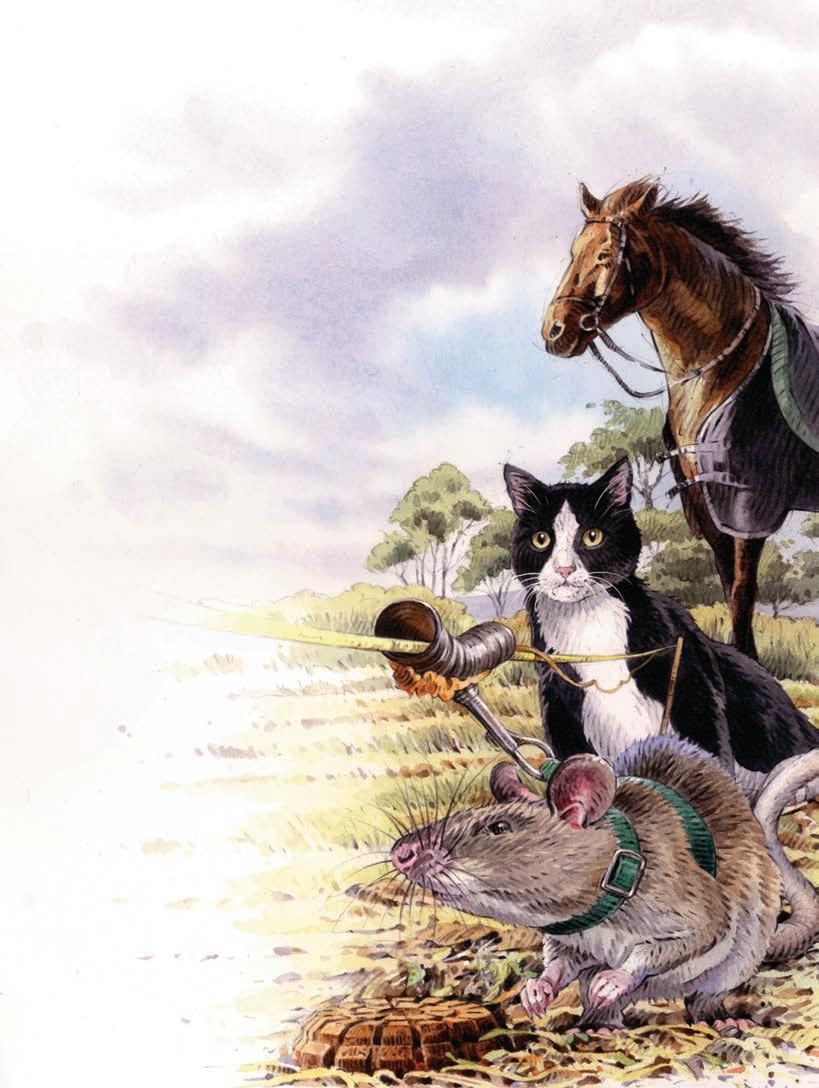
100-Word-Story Competition
Send us your tiny tale—it could win you £2,000! PAGE 65 How


NOVEMBER 2015
PAGE 56
Tails of the Unexpected Heroic animals that went beyond the call of duty
PAGE 78
28
Downton
20 Laugh ............................................140 If I Ruled the World .........................84 Word Power ...................................133 Books that Changed my Life ..........129 NOVEMBER 2015 £3.79 readersdigest.co.uk
to Have a Great Teenager
“I Remember”: Wilko Johnson PAGE
Penelope Wilton talks
PAGE



A







NEW FORD C-MAX ZETEC 1.6-litre 125PS with rear parking sensors and metallic paint from Nil*Advance Payment. To find out more, visit ford.co.uk/Motability, or call 0345 60 40 019.
O cial fuel consumption figures in mpg (l/100km) for the New Ford C-MAX 1.6-litre 125PS: urban 33.6 (8.4), extra urban 54.3 (5.2), combined 44.1 (6.4). O cial CO2 emissions 149g/km.
The mpg figures quoted are sourced from o cial EU-regulated test results (EU Directive and Regulation 692/2008), are provided for comparability purposes and may not reflect your actual driving experience.
*£Nil Advance Payment available only on the New Ford C-MAX Zetec 1.6-litre 125PS. Metallic Paint excludes Design body colours and Special body colours. Design body colours and Special body colours are available to order, but at additional cost. This programme is subject to the standard conditions of the Motability 3-year Contract Hire Scheme. Full written details and quotations available on request from a Ford Authorised participating Dealer of Motability Operations Limited. Under the Scheme the vehicles are leased from Motability Operations Limited (Registered Company No. 1373876), City Gate House, 22 Southwark Bridge Road, London SE1 9HB. Applications must be received and accepted by Motability Operations Limited between 30th September and 31st December 2015.
Clever Configuration.
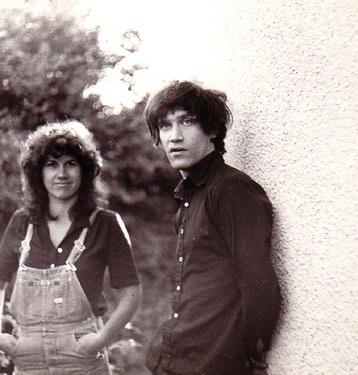
Join us on an insider’s tour of the famous Rijksmuseum in Amsterdam
98 the next exodus
We speak to the Jewish families fleeing France to escape anti-Semitism
Cover Illustrat I on By a ndrew Be C kett 11•2015 | 1 Contents november 2015 features
Reasons to be chee R ful James Brown gets out of the city and back to nature e ntertainment 20 “a little R ese Rve goes a long way” Penelope Wilton opens up about life at Downton Abbey 28 “ i R emembe R”: wilko johnson The legendary musician on life, long-term love and surviving terminal cancer Health
the beautiful life of you R b R ain How to harness your mental muscle for a more fulfilling life Inspire
tails of the unexpected
the animals who’ve distinguished themselves by saving human lives
100-wo R d-sto Ry competition
12
38
56
Meet
65
us—it could
you
Craft a tiny tale and send it to
win
£2,000!
b R idges
70 best of b R itish:
These beautiful feats of engineering are brimming with tales
78 how to have a b R illiant teenage R
& a
tReasuRe
Discover the latest research and expert advice that help make teenagedom a treat travel
dventure 86
house
p28
e DI tor’s letter

a deep fondness fo R animals is something that really chimes with our readers. But even though we love our furry friends, most of us don’t actually owe our lives to them. This month, however, we raise a glass to those four-legged heroes—dogs, cats, horses, even rats—who have risked everything to protect us. Read their inspiring stories on p56.
One person who knows all about dicing with death is Wilko Johnson, interviewed on p28. Diagnosed with terminal cancer three years ago, the guitarist defied the odds and is still tearing up the stage today. We also catch up with actor Penelope Wilton on p20 as the curtain comes down on Downton Abbey after five dramatic years. And don’t miss our advice on how to cope with teenagers on p78— it could prove invaluable.
Finally, turn to p65 for details of our 100-Word-Story Competition, now in its sixth year. The top prize this time is £2,000, so get your thinking caps on and send in your entries!

tom Browne
theeditor@readersdigest.co.uk
facebook.com/readersdigestuk
twitter.com/readersdigestuk
pinterest.com/rdigestuk
google.com/+readersdigestuk1
| 11•2015 2 IN e V er Y I ssue 6 over to you 8 s ee the world d ifferently e ntertainment 17 n ovember’s cultural highlights Health 46 advice: s usannah Hickling 52 Column: d r Max Pemberton Inspire 84 If I ruled the world: John torode travel & a dventure 94 Column: Catherine Cole Money 106 Column: a ndy webb food & Drink 112 tasty recipes and ideas from rachel walker Home & Garden 116 Column: lynda Clark technology 118 o lly Mann’s gadgets f ashion & Beauty 120 Georgina yates on how to look your best Books 124 november Fiction: James walton’s recommended reads 129 Books that Changed My life: a nnie n ightingale f un & Games 130 you Couldn’t Make It u p 133 word Power 136 Brain teasers 140 l augh! 143 Beat the Cartoonist 144 60-s econd stand- u p: n ish kumar
Reader’s Digest is published in 29 editions in 17 languages



















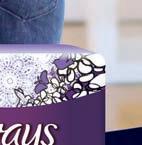
















edItOr-IN-ChIef Tom Browne
aSSIStaNt edItOr Fiona Hicks
dIGItaL edItOr Mandi Goodier
aSSIStaNt dIGItaL edItOr Anna Walker art dIreCtOr Yvey Bailey
GraPhIC deSIGNer Katie Johnson
advertISING dIreCtOr Simon Fulton simon.fulton@readersdigest.co.uk 0203 701 5936
advertISING aCCOUNt dIreCtOr Mike Allen mike.allen@readersdigest.co.uk
0203 701 5935
CeO Gary Hopkins
ChIef OPeratING OffICer Julie Leach
dIGItaL MarKetING aNd CaMPaIGNS
MaNaGer Maggie Champion
trUSted MedIa BraNdS INC (USa) President and Chief executive Officer
Bonnie Kintzer
vice President, Chief Operating Officer, International Brian Kennedy editor-in-Chief, International Magazines
Raimo Moysa
For all subscriber enquiries, please use the customer services number below
We Pay...
£50 for the star letter and £30 for regular letters.
Email readersletters@readers digest.co.uk or go to readers digest.co.uk/contact-us
We a LSO Pay...
£50 for the true stories, anecdotes, jokes in Laugh! and you Couldn’t Make It Up…, and contributions to end-ofarticle fillers and My Great escape.
Email excerpts@readersdigest.co.uk or go to readersdigest.co.uk/contact-us
S O rry!
We cannot acknowledge or return unpublished items or unsolicited article-length manuscripts. Do not send SAEs. Article-length stories, poetry and cartoons are not requested.
C US t OM er Serv IC e S
Contact Customer Services for renewals, gifts, address changes, payments, account information and all other enquiries. Call 0330 333 2220* or email customer_service@readersdigest.co.uk
ta LKING M aG a ZIN eS
Reader’s Digest is available in a talking edition for blind and partially sighted people for £16. For details, call 01435 866 102, email info@tnauk.org.uk or visit tnauk.org.uk
SUBSC r IP t ION S
Visit readersdigest.co.uk or write to: Reader’s Digest, PO Box 7853, Ringwood BH24 9FH. UK: £45.48 a year. republic of Ireland: €61.20 a year. Prices include delivery. For gift subscriptions, contact Customer Services.
| 11•2015 4 *Calls to 03 numbers cost no more than a national rate call to an 01 or 02 number and will be free if you have inclusive minutes from any type of line including mobile, BT or other fixed line
us!
us your stories, jokes and letters or Visit o ur Website
published. Include your name, email, address
all
We may edit letters and use them in all print and electronic
become world copyright of Vivat Direct Ltd (t/a Reader’s Digest).
Write to
send
small Print: Ensure submissions are not previously
and daytime phone number with
correspondence.
media. Contributions used
paper from sustainable forests. please recycle © 2015 Vivat Direct ltd (t/a reader’s Digest). british reader’s Digest is published by Vivat Direct ltd, 57 margaret street, london W1W 8sJ. all rights reserved throughout the world. reproduction in any manner, in whole or part, in english or other languages, is prohibited. reader’s Digest is a trademark owned and under license from trusted media brands, inc, and is registered with the united states patent and trademark office. all rights reserved. classified advertising by madison bell. printed by polestar chantry, polestar uK print ltd. newstrade distribution by seymour Distribution limited.

Over to You
LETTERS ON THE SEPTEMBER ISSUE
We pay £50 for Letter of the Month and £30 for all others
✯ LETTER OF THE MONTH...
Growing up, my knowledge of the Second World War largely came from my grandmother, who brought memories to life through her stories. But reading about the WI in “I’ve Never Made Jam”, and the battles that women are still fighting on behalf of others, caused me to think of the private battles women face—and how far we’ve come since my grandmother’s time.

During the Second World War, she was alone in a foreign country while my grandfather was stationed abroad. She had to give birth alone in her room without medical help and support. It seems such a far cry from where we are today. There are still too many women in poorer countries who do not have the medical help and assistance that they need. May we not forget where we have come from, or stop looking for who we can help.
K C LEMMER, Surrey
PACKAGED PROBLEMS
After reading “If I Ruled the World”, Daphne Selfe would get my vote, especially with her thoughts on reducing packaging.
Although progress is being made in supermarkets, excessive packaging is still damaging our planet. It’s also costing consumers money in
our increasingly excessive society, as the expense of sending waste to landfill sites ultimately ends up on council tax bills.
What’s more, it’s frustrating to tear through huge boxes filled with endless packaging foam to finally unwrap a tiny iPod…
ELERI WEBBER, Cheshire
6 | 11•2015
THREE CHEERS FOR GOLF!
I recently read Chris Tait’s letter “Golfing Gripes” in “Over to You”, and was intrigued that this amazing sport could be considered annoying in any way.
I have endured 30 years of Formula 1 motorsport on the TV (my husband’s passion). Granted, it doesn’t take up three full days of your week, but the noise that comes from F1 on the TV for three hours every other Sunday afternoon from March until November makes watching the Open seem like a dream. Golf is, at least, peaceful to listen to.
My son has recently taken up golfing and is now much more fit and healthy. It gets a thumbs-up from me.
SUE WATT, Glenrothes
LAUGH AWAY ALL DAY
Reading “60-Second Stand-Up” with Mark Thomas greatly strengthened my enthusiasm for comedy clubs. Humour is infectious. The sound of laughter is far more contagious than a cold. Also, when laughter is shared, it binds people together and increases happiness and intimacy. It’s also great for stress.
I’ll be sure to look out for Mark on tour in future. AMBER JACOBS, Cheshire
WELL DONE, MIDGE
It was fascinating to learn more about Midge Ure in “I Remember”. We’ve all heard the famous charity single, but I’m sure he had no idea back in 1984 that his humanitarian efforts would prove to be such a step in the right direction.
Midge has used his platform well. Music transcends race, creed and colour, and he has made the world a little better. Thanks, Midge!
DEMI ROBERTS, Gwynedd
GOING UNDERGROUND
After reading your extremely interesting and informative article “Best of British: Subterranean Attractions”, I was reminded of a visit many years ago to Exeter. It was by chance that we found a tourist attraction—the fascinating Exeter Underground Passages.
Curious, we entered the visitor centre and learned that the tunnels were built in the 14th century to bring water into the walled city. Originally containing a lead pipe, these tunnels were just about big enough to walk through, passing below the busy city centre and out under the old city walls to the river. I highly recommend a visit.
STEPHEN BROWNE, Essex
7 11•2015 |
WE WANT TO HEAR FROM YOU! Send letters to readersletters@readersdigest.co.uk Please include your full name, address, email and daytime phone number. We may edit letters and use them in all print and electronic media.

8
Photo: © searagen/a lamy

turn the page
see the world
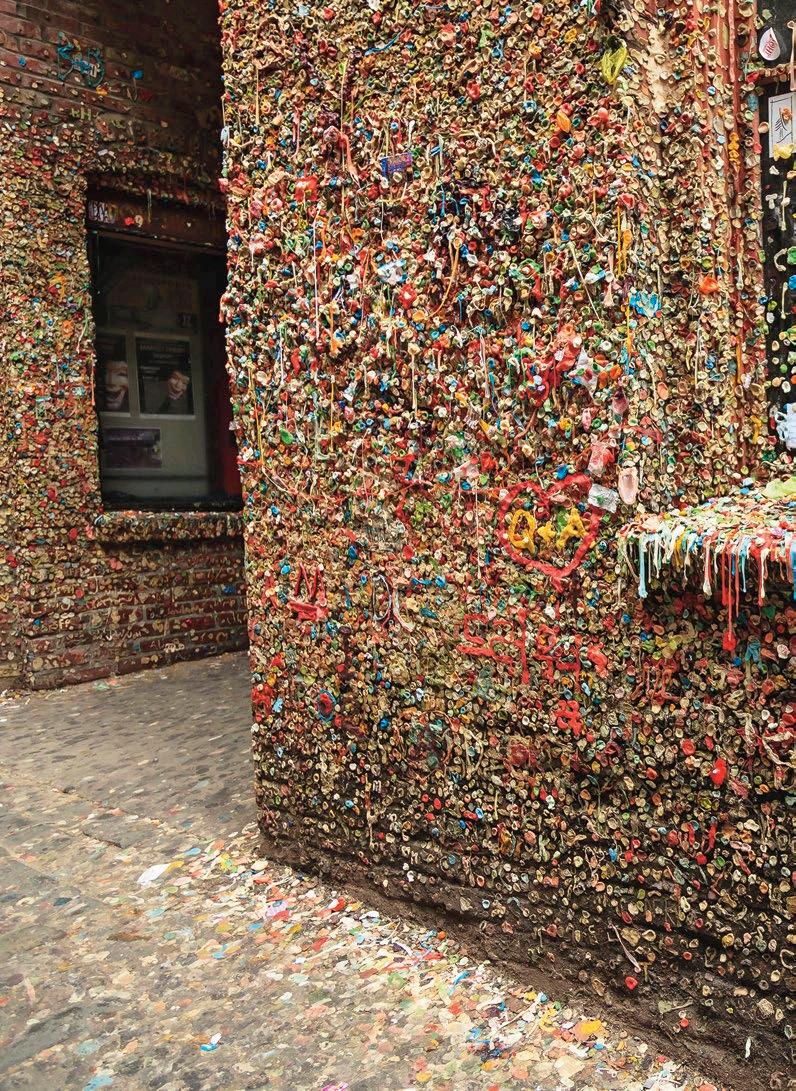
...differently
There’s a slightly fruity aroma when you come near Market Theatre in downtown Seattle (US). The reason? Gobs of gum! They stick there at a length of some 50 feet, sometimes piled inches thick. The sticky fun started in the 1990s when the theatre operators apparently asked patrons to leave their chewing gum outside, which they did—literally. The gum wall was born.
Photo: © s tuart w estmorland/Corbis

11
City slicker James Brown finds some unexpected comfort in the great outdoors
A Tree, A Breeze And A Good Book

James, founder of Loaded magazine, now edits Sabotage Times—an online magazine with the motto: “We can’t concentrate, why should you?”
I’m stood to the s I de of a stone dr I veway I n a small wood. Beneath my feet, springy brown moss is dripping dew onto my pumps, while above me a bird is singing higher than my distant-motorway-level tinnitus. I’m enjoying the stillness.
It’s 8am on a fresh Saturday morning on Scotland’s Solway Coast. The Hazlefield House B&B lawns are long, the trees high and in the distance there’s a hazy mix of dark and lighter greys where the sea meets the sky. Right now, right here, it’s just me, the trees and a slight breeze, and it feels special.
When I first gave up drink and drugs 17 years ago, it was a belief that nature was greater than me—a higher power—that helped me move away from a self-obsessed, destructive daily pattern and onto somewhere unsure and new (but undoubtedly better for me). I came to believe that if I placed my faith in nature, then everything would be OK. And on the whole it has been. During the time I was going through rehab counselling, I lived in a fine old square in Islington, London. Towering above the houses opposite was a huge tree.
In those f I rst few frag I le days, as I tried to move my life towards a different path, I would look up at that tree from my bathroom and tell myself, It’s been here longer
| 11•2015 12
Reasons to be C hee R ful
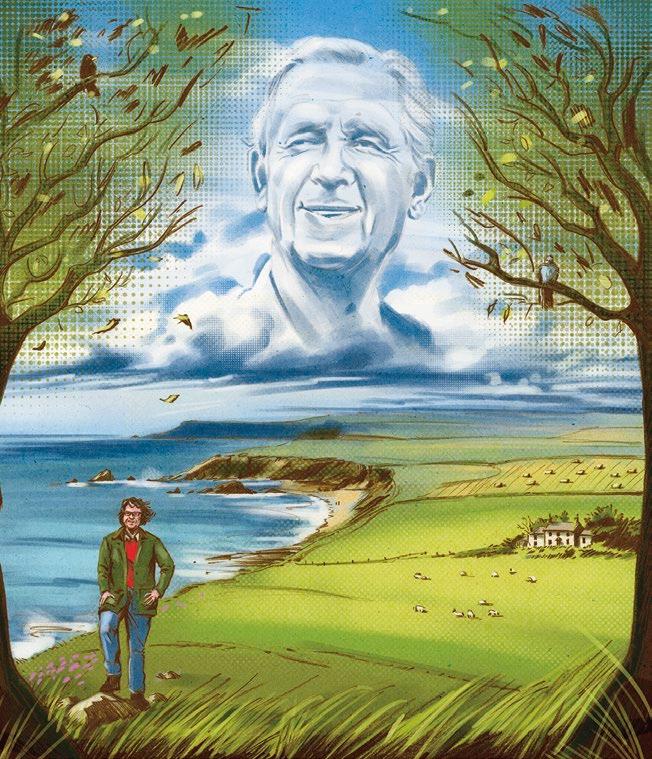
than me, it will be here after me, it’s strong and growing despite its years. And that’s just one great tree. There are all the mountains and seas and woods all over the world. All more impressive than me. I’m
just a tiny part of it, not the centre of it. It took me out of myself and helped me notice the natural world around me.
After a while I started to feel a tremendous power when I found
Reade R ’s d igest 11•2015 | 13
Illust R at I on by M IC hael Ga M b RI el
myself in the stillness of woods.
Surrounded by the busy madness of the capital city, I sometimes forget about the spiritual strength of nature, but lately I’ve been reconnecting with it. This summer, my dad and I walked along the old, disused railway embankment in Thorner, West Yorkshire (the village he grew up in). We stopped and looked across the golden fields with their rolls of hay, listening to the combine harvesters, and it reminded me of being a kid 40 years ago. It was a perfect view.
Some weeks later, I found a James Herriot book in a second-hand shop in Rye. Now reading it daily, I find myself back in the stonewalled valleys of the Yorkshire Dales with the likeable vet. It’s a familiar world of nononsense farmers in tweed caps and hard-worn clothing, of lambing ewes and frolicking dray horses. Or, as the Dalesmen call them, “t’osses”.
Surrounded by the busy madness of the capital city, I sometimes forget about the spiritual strength of nature my life—have
to put my arm inside a cow.
I wondered whether to bring the Herriot book to Scotland with me, but decided that that sort of tale is best read down south. As it turned out, I discovered a full collection of his best-sellers at the four-star B&B. Arranged on the perfect country bookshelf, there was a great array of literature and guide books, and I eagerly helped myself to one of his books and another called Isolation Shepherd.
o f course, I didn’t need reminding of the countryside here. From the moment we turned left at Gretna Green, just miles north of Carlisle where we’d rented a car from an amiable bloke called Kester, we were presented with close skylines of pine forests and outcrops of rock and fields running away with themselves.
Starting and ending the day with his tales of 3am journeys to treat injured farm animals, across barren fields in icy winds, really brings home the benefit of being in bed. Warm and comfortable, it’s a delight to know that I won’t at any point during the next 24 hours—or indeed
My friend Matt, whose wedding we’re going to here, has been trying to get me to come up to stay at his late grandma’s cottage for years. I asked him why he’d never shown me photographs of any of the lush green landscapes—if he had, I’d have been up here like a shot.
He insisted that he had, but all I
Reasons to be C hee R ful | 11•2015 14
remember are pictures of him and his brother dragging a kayak across what looked like an empty, muddy, cold and unforgiving bay. In fact the views are consistently rewarding, but are reassuring rather than spectacular. The strength of nature is everywhere you look.
I’d say any time anyone feels unwell or needs a rest, pack them
off to a decent B&B in Scotland like Hazlefield House. It’s a pleasure to be here now, cheerfully writing off a massive four-course breakfast and looking ahead to a day of fun in the village of Auchencairn. It’s good for the soul, when everything you can see out of the window is a different shade of green and there isn’t a bus lane or kebab shop in sight.
SORRY, I’M NOT SORRY
Children write the best apology notes, as these extracts show (all spelling unedited for authenticity):
“I love you mum. I’m sorry for everything I did rong. It’s just I can’t controle my body.”
“Dear brody, Mrs P made me write you this note. all I want to say sorry for is not being sorry cause I tried to feel sorry but I don’t. liam.”
“I em sorry that I’v been chasing you owtside. If you will start to like me I will not chase you.”
“Dear Jase, I’m sorry for kicking you with a feather. Kicking is not okay because it hurts people. also don’t forget about the time when you were a baby—crying little devil—but I liked you and now you still are a crying little devil who gets away with everything. sincerely, ty.”
“Dear Parents, it seems you both are a little overly strict tonight. Therefore I do not wish to read with you tonight. But, if you change your attitude, I will be glad to. Goodnight. From Chloe.”
“Dear Camron I am so sory that I smaced you in the privets.”
“Dear mum, you are my favorit mummy ever. I’m sorry for calling you a pice of poo. And I hate you and not going to my room. I love you mummy. Love, your daugher, Karah.”
SOURCE: HUFFINGTONPOST.CO Uk
Reade R ’s d igest 11•2015 | 15




















*Based on AC Nielsen, MAT, 25th April 2015











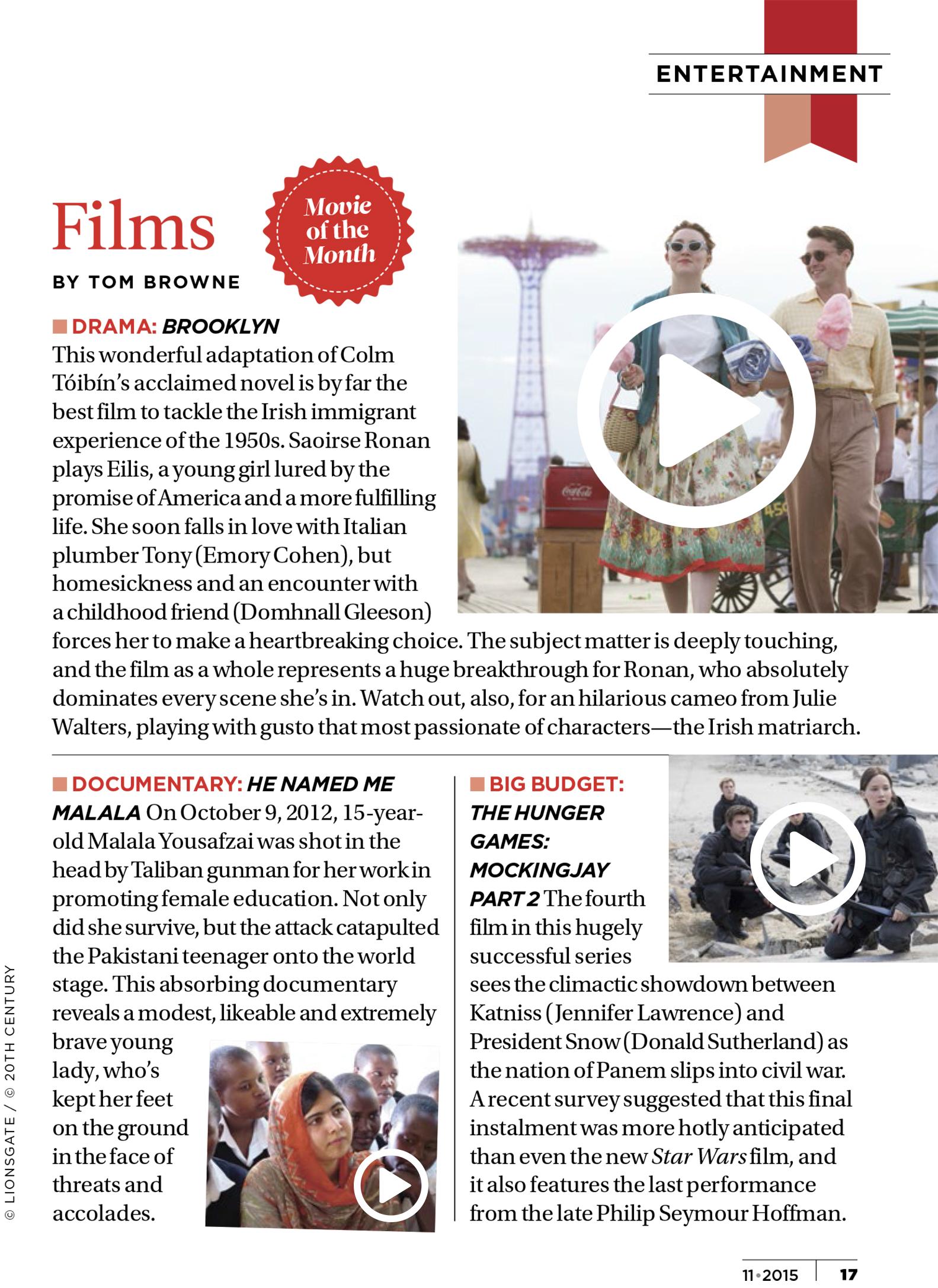
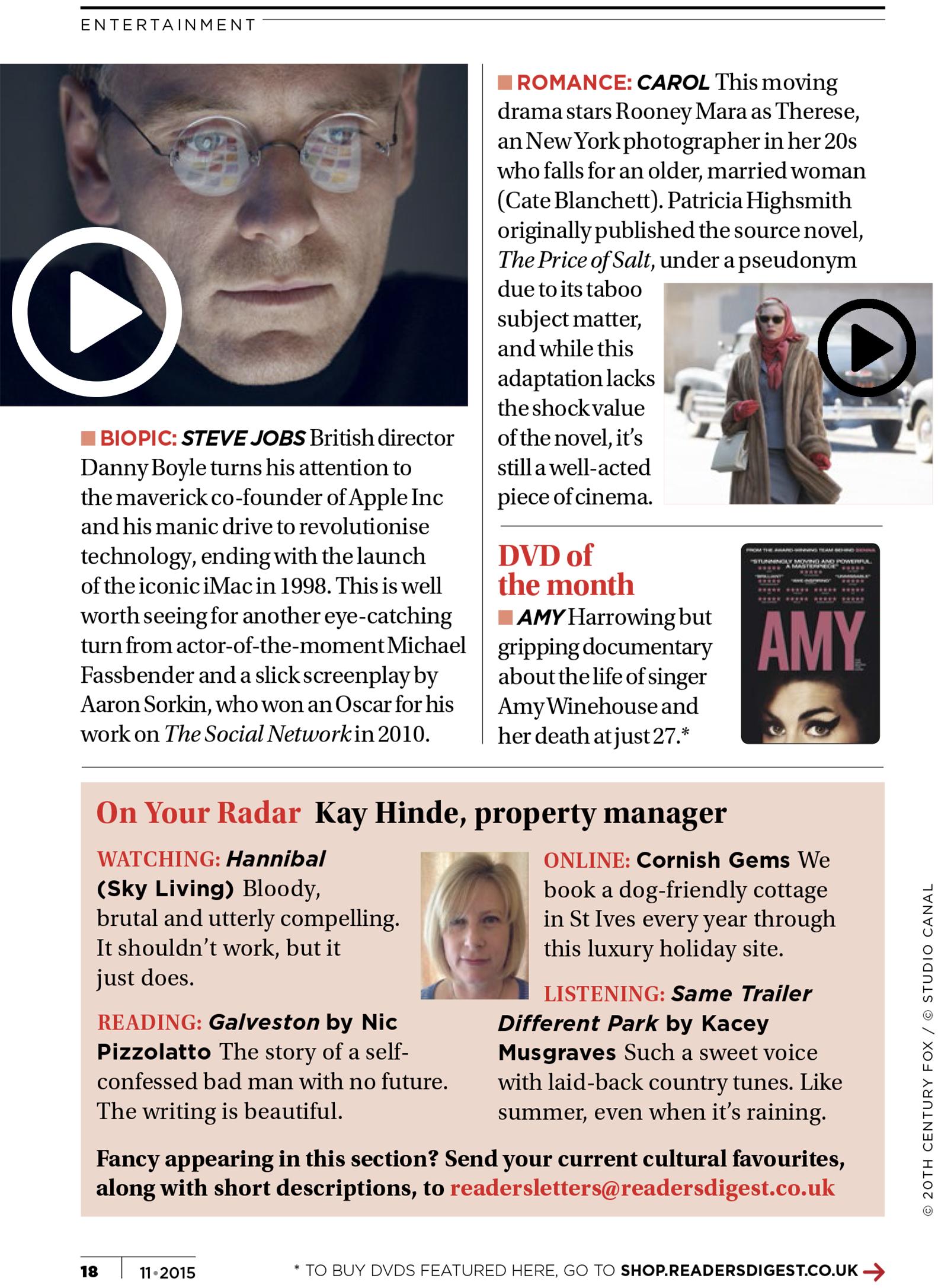
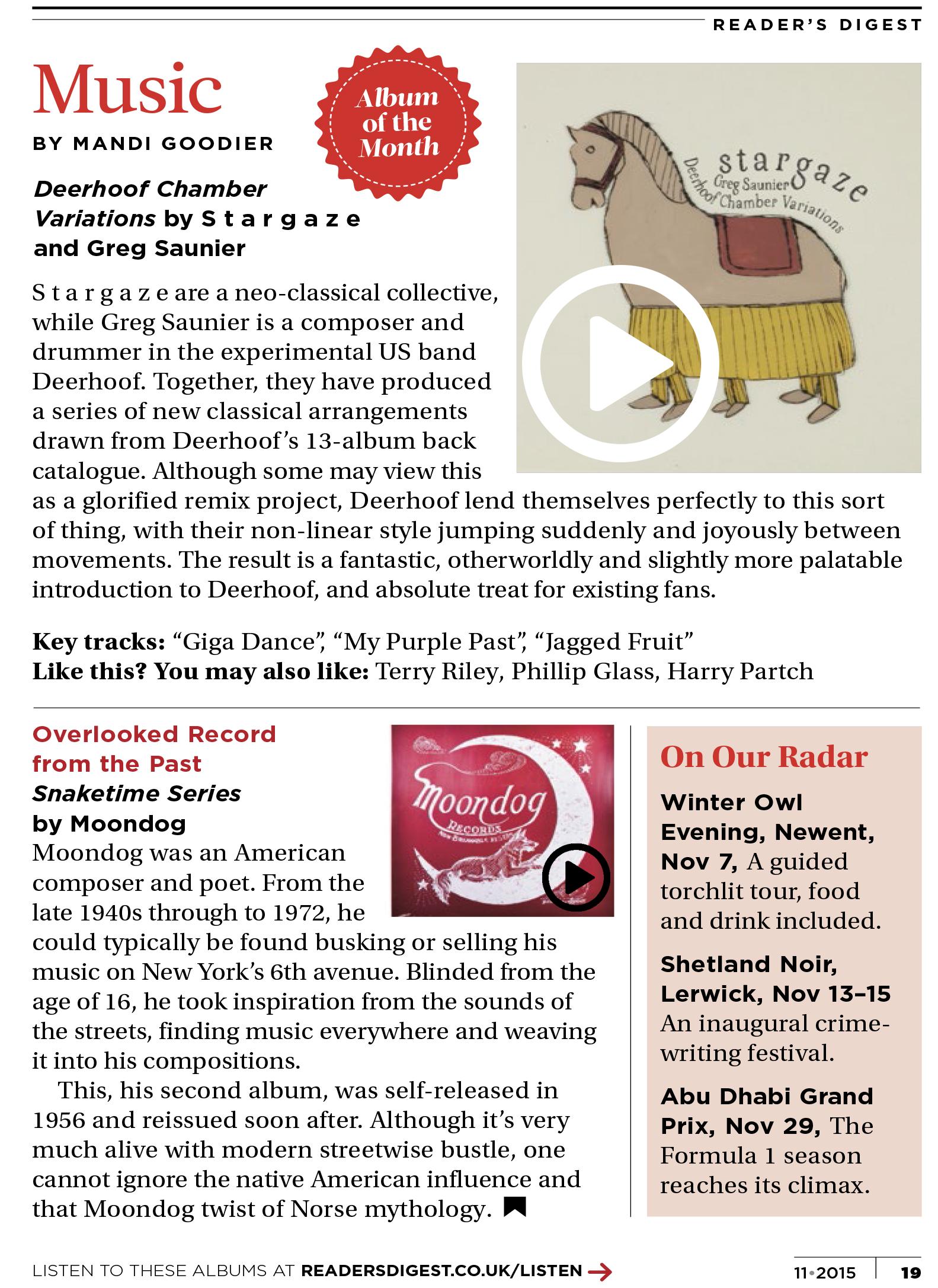
“A Little
Goes a Long Way” Reserve
as the much-loved series comes to a close, Penelope Wilton opens up about life at Downton abbey
By fiona hicks
For the last six years, the lives of the Crawley family, their social circle and their staff have captivated the world. Premiering to a British audience of nine million in 2010, Downton Abbey has grown to be one of the most widely-watched TV dramas in history, reaching a global audience of 120 million.
The closing episode of the sixth series, which airs this month, is the penultimate glimpse into ITV’s fictional Yorkshire estate. The special episode that’s broadcast on Christmas Day will be the last.
©
entertainment
Larry Busacca/ s taff
| 11•2015 20

PeneloPe Wilton, Who’s Played the kind and P rinci P led Isobel Crawley since the first series, is just as sorry as the audiences to see the show end. “It’s been a great experience and it’ll be sorely missed,” she says softly. “You never take anything for granted, I have to say, and we’ve always known it would have to finish.”
She can indulge, like the rest of us, in repeated episodes (“I do watch it from time to time,” she smiles. “I usually wait for the box set to come out”) but she appreciates it’s right for the story to come to a close. She adds, “It’s rather better to leave something
and she became a household name thanks to 1984’s Ever Decreasing Circles, in which she starred with the late Richard Briers. Downton Abbey, however, has been a record for her too. “I’d never worked on anything for that length of time before. It really has been extraordinary.”
Aside from the costumes and sets, what she’ll miss most is “the wonderful camaraderie
with my fellow actors”. The cast, of course, boasts myriad famous figures, including Dame Maggie Smith, Hugh Bonneville and Brendan Coyle. And
I’d never worked on anything for that length of time before. It really has been extraordinary
when people still want to know about it, rather that wait for it to lose its momentum and just become yet another show on TV.”
Of course, with a career spanning four decades, Penelope is certainly an expert on the industry. Born in Yorkshire to a thespian family (her uncle was the actor Bill Travers, her mother was a tap dancer and performer, and her maternal grandparents were theatre-owners), the 69-year-old caught the acting bug at a young age.
Her TV acting career began in 1972 with Mrs Warren’s Profession,
many of the younger actors—such as Michelle Dockery and Dan Stevens— have become household names thanks to the international success of the show.
“The relationship with my fellow actors has been hugely important,” continues Penelope, with a touch of shyness. “When you work with people a lot, after a while you develop a bit of a shorthand with them. You can do more subtle things because they know their character, you know your character, and you know them very well.”
The inimitable Dame Maggie plays
22 “ a LI tt LE r E s E r VE GOE s a LONG W ay ”
| 11•2015
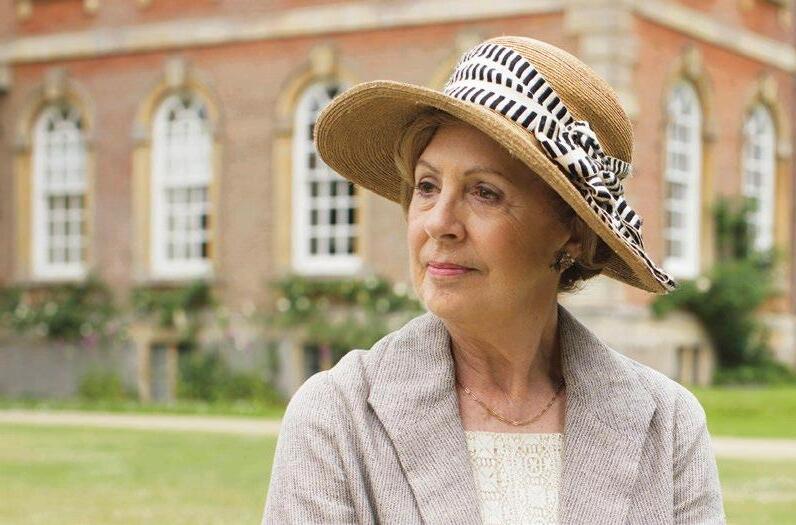
the hilariously caustic Violet Crawley, whose traditional views often jar with Isobel Crawley’s more liberal stance. “I certainly have that shorthand with Maggie,” she avers. “We’ve done quite a lot of scenes together and I’ve also worked with her in other things.” The two together are a joy to watch, where even the slightest lift of an eyebrow can speak volumes.
The pair have also appeared together in the enormously successful The Best Exotic Marigold Hotel and its recent sequel—just two of the films which have peppered Penelope’s diverse career. From the British
feel-good comedy Calendar Girls, to Joe Wright’s 2005 adaptation of Pride and Prejudice, to Woody Allen’s Match Point, she’s certainly no stranger to the silver screen.
laying one character for six years, then, was certainly unusual for Penelope, but an experience that she relished. “At the beginning of each series, Julian [Fellowes, the writer and creator] would give a note to each actor saying, ‘You must look after your character’. And you do. You look after it and it becomes you. I’m not
Reade R ’s d igest 23
11•2015 |
Penelope Wilton as Isobel Crawley in Downton Abbey



quite as straightforward as Isobel, or as brave, or as clever. But I hope that I’d be as principled as she is.”
Isobel’s character is nothing if not strong. A distant relative of the Earl of Grantham, she comes to live at Downton Abbey only when her son Matthew learns he’s entitled to the great estate through a spurious line of inheritance. Matthew dies tragically in the second series, but Isobel stays
on, channelling her grief into charity and community projects. She’s later offered a second chance of happiness with a proposal from the privileged Lord Merton, but—as she’s essentially a middle-class woman— his sons strongly object and Isobel is forced to decline his hand.
She handles death, struggle and disappointment with a reserve that’s almost unheard of today. “Yes, it’s not seen as being strange to show your emotions now,” says Penelope carefully, with a touch of Isobel’s restraint. “In fact, if you don’t, it’s
24 | 11•2015 “ a LI tt LE r E s E r VE GOE s a LONG W ay ”
Left: Penelope Wilton, Helen Mirren and Julie Walters in Calender Girls; (below right) as Irmgard Litten in the play Taken At Midnight; (below left) Penelope is one of many famous faces in The Best Exotic Marigold Hotel
almost seen as if you’re hiding something. I think there’s a lot to be said for keeping your own counsel until you have something to say. A little reserve often goes a long way.”
As well as developing a real fondness for her character, Penelope has greatly enjoyed immersing herself in the period.
“Historically, 1912 to 1926 was an interesting time,” she points out. “People initially thought they would start and end their lives in the same situation, hierarchically speaking.”
It’s not seen as strange to show your emotions now. If you don’t, it’s almost as if you’re hiding something
Of course, the First World War and women’s emancipation caused dramatic shifts in society, giving rise to more mobility and freedom. “You can see it reflected in the women’s costumes,” adds Penelope. “We begin very corseted and by the end we’re free-flowing. It was fascinating.”
There has been a lot of speculation
as to whether this really is the end of Downton, with whispers of a bigscreen adaptation in the pipeline. Whether this materialises or not, Penelope will certainly be appearing in cinemas in the near future. She’s recently finished filming a Steven Spielberg adaptation of Roald Dahl’s The BFG, and has another movie lined up for next year. Then there’s the successful play Taken At Midnight, in which Penelope played a part in London’s West End, and is now scheduled to go Down Under. “I’d like to go to Australia,” she says. “I’ve never been.”
With ambitious roles, professional dedication and a full calendar, one suspects Penelope is rather more like Isobel Crawley than she realises.
Downton Abbey series 6 is released on Blu-ray and dVd from november 16. Visit shop.readersdigest.co.uk for more can yo U con QU er it ?
researchers at MIt in the us have developed what’s believed to be the toughest English-language tongue twister. say it quickly, ten times in a row.
“Pad kid poured curd pulled cold.”
soUrce:
25 11•2015 | r eader’s d igest
I s NE
r E
s
E
O
/ ©
y
IN / r EX s
E rst O ck / © fOXsE
VE r E tt/ r EX s
E rst O ck
Uk.BUsinessinsider com © W. D
y/E VE
tt/ r EX
hutt
rst
ck
tON
Lark
hutt
arch/E
hutt
costs of your vehicle add up over the year with insurance, servicing, MOT and petrol, not to mention any unexpected repair bills.
To help your money go further in 2015, QuickPages is offering one lucky reader the chance towin FREE that’s a prize worth £2,000.





Just think what you can buy with what you will have saved!
And don’t forget, before you renew your insurance, call the companies featured opposite to see if you can save on your premium.







When best Don’t Cheaper MOTOR: Terms and conditions : No purchase necessary. One entry only, open to UK mainland residents aged 18 years and over, except employees of Wilmington Millennium, their immediate families and anyone connected with this promotion. Closing date midnight 31st December 2015. Promoter’s decision is final and the winner will be notified within 28 days of the close date. No correspondence will be entered into. The prize winner’s name and county can be obtained after the draw date 11th January 2016 by sending a SAE to ‘QuickPages Prize Draw’ at the address below. Entry into the prize draw indicates acceptance of these rules and agreement to the winner’s name and county appearing in future QuickPages promotions. Promoter: QuickPages, a trading name of Wilmington Millennium Ltd, The Chapel, The Sidings, Shipley, BD18 1BN QuickPages will use your
to provide
relevant products and services in the
if
details
you with
future
you respond. To be added to the mailing list to receive a QuickPages directory when your insurance is due for renewal, please write to Freepost RTGY-UXEL-HRAX, QuickPages, The Chapel, The Sidings, Shipley BD18 1BN or complete the online form at www.quickpages.org/contactus Win free petrol for a year from The running
WIN
WORTH Enter online at: www.quickpages.org/petrolprizedraw and leave your details. Or
your
and insurance renewal date on a postcard to the Freepost address below. HOW TO ENTER MC 13087 184x268 Quick Pages.indd 1 RD Full Page Ad Template.indd 2 01/10/2015 12:31
ust
send
name, address


Looking for Cheaper Insurance?
Don’t click, call FREE * with
When your insurance is due for renewal make sure you shop around to find the best deal. QuickPages has brought together some of the biggest Insurance brands to make it easy for you to ring round and get the best quote!

MOTOR: 0800 118 1762
HOME: 0800 915 2420

MOTOR: 0800 156 0625
HOME: 0800 156 0841

MOTOR: 0800 024 1390
HOME: 0800 369 8742

MOTOR: 0800 422 0548
HOME: 0800 369 8178
MOTOR: 0800 915 2193
HOME: 0800 156 0902
*Calls to 0800 numbers are free from mobiles as well as landlines.
All calls may be recorded and/or monitored.
MOTOR: 0800 118 1748
HOME: 0800 024 1910


MOTOR: 0800 369 8749
HOME: 0800 156 0958

employees December entered ‘QuickPages name Ltd, respond.
NOT DUE YET?
renewal. Go to www.quickpages.org/registernow QuickPages will not share your details with any 3rd parties. RD2010 29/09/2015 15:35 RD Full Page Ad Template.indd 3 01/10/2015 12:31
INSURANCE
Register your details now to receive your free QuickPages directory and find the best quotes when your insurance is due for
Wilko Johnson, 68, co-founded Dr Feelgood and played with Ian Dury and The Blockheads. Since last autumn, he’s defied cancer, made a hit album with Roger Daltrey and starred in Julien Temple’s The Ecstasy of Wilko Johnson. His band is touring into next year.
Wilko Johnson
“I Remember”
. ..GROWING UP ON CANVEY ISLAND. I was born there 1947. It was all fields and wild open spaces then. We used to play on gun emplacements on the seawall. They had guns pointing out across the estuary.
One of my first memories is the 1953 flood. I looked out the back of our bungalow and, where there used to be fields, I could see waves. It was surreal. I understood what was happening —I was a clever little so-and-so. The island was evacuated and we went to stay with Mum’s relatives in Sheffield.

I got the sense from my mum that there was something shameful about coming from Canvey. She was an intelligent woman—a teacher in the later part of her life. She devoted herself to looking after us, but there wasn’t much affection in our home.
My dad was a fitter for the gas board. He was uneducated and violent and I hated him. I detest cruelty to children. I know how terrifying it is. My sister Margaret was three years older than me and there was 18 months between me and my younger brother Malcolm.
28 entertainment
 © Kevin n ixon/Future Publishing/ rex s hutterstoc K
Wilko with his 1962 Fender Telecaster guitar
© Kevin n ixon/Future Publishing/ rex s hutterstoc K
Wilko with his 1962 Fender Telecaster guitar
As a toddler (right) alongside siblings Malcolm and Margaret
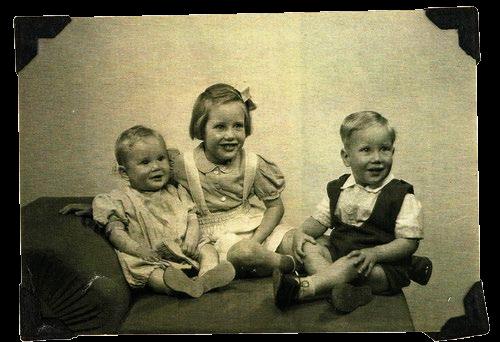
...DISCOVERING SHAKESPEARE. I passed the 11-plus and went up to the grammar school in Southend. My mother scrubbed floors at the gas company showroom to pay for my uniform.
When I first read Shakespeare, I just loved it. Macbeth has some of the most intense poetry. The English teacher used to get me to stand in front of the class and say words like “bottle” to show the other kids how not to speak. I thought it was a laugh. I’ve always been a show off.
...FALLING IN LOVE. When I was 16, I met Irene down the youth club. Everybody liked Irene. She was very friendly and sympathetic. She had this smile...she was beautiful in every sense.
I remember telling her that if I wasn’t a great poet by 21 I’d cut my throat. She’d listen to my nonsense!
...GETTING OBSESS ED WITH MUSIC. The Rolling Stones put me on to R&B music and I fancied myself with a guitar. I’m lefthanded but taught myself to play righthanded. Once I got confident, I started playing in bands.
I remember hearing “I’ll Never Get Over You” by Johnny Kidd and the Pirates. The lead guitarist Mick Green played a Fender Telecaster and had this way of playing—picking and strumming at the same time. He
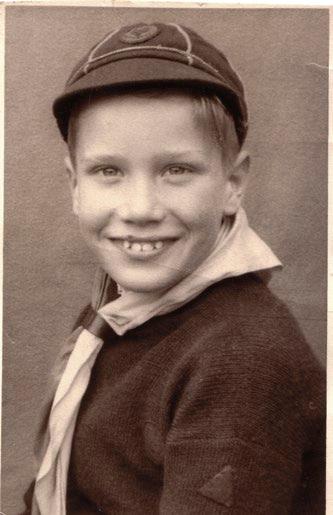
As a schoolboy in his Scout uniform
I remember 30 | 11•2015
sounded like an American. Man, I wanted to be Mick Green!
The local music shop had a Telecaster in the window, but £100 was a fortune. My scheme was to save my dinner money and pay off a bit each week, but Irene paid for most of it out of her Post Office account. Her mum and dad never knew.
...MARRYING WHILE I WAS AT UNIVERSITY.
I went to university in Newcastle to study English. I couldn’t find a band so I stopped playing. I ran the poetry magazine instead and got very interested in medieval literature and old Icelandic sagas.
I got a letter from Irene saying, “Can we get married?” Even as a child, I thought that Irene was the one thing in the universe I was sure of.
We got married at Southend Registry Office in the Easter holidays. We had a wedding breakfast for mums and dads and “respectables” at Cliff Pavilion. In the evening, Irene’s mum and dad left their house to our tender mercies and we had a bit of a party.
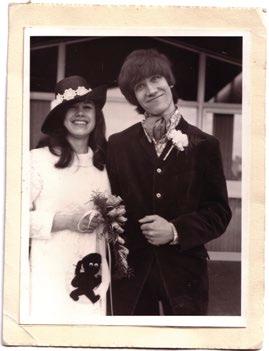
...BECOMING A HIPPY—AND A
TEACHER. I’d never been out of England. After university, a bunch of

us set off to India via Iran and Afghanistan. In Goa I got hepatitis and ended up delirious. The sky was on fire, there were angels and everything…I started thinking that I didn’t want to be a poet. I wanted to be a painter.
I was gone a year. Back home, Mum found me a job teaching English at
Reade R ’s d igest 31 11•2015 |
© P H o T o S FR om w I lko J o H n S on’ S P e RS onal collec TI on
Above: Wilko taught himself the guitar; (left) with wife Irene

a school in Benfleet, but I continued painting. Faces were my thing.
...JOINING DR FEELGOOD.
One day this kid
I knew locally, Lee Collinson, said his R&B band needed a guitarist.
I remember thinking he looked fantastic in this pinstripe
I joined Dr Feelgood in 1971. We started playing R&B covers and became quite proficient. Once I knew I could make five or six pounds a week
Blues Brothers thing, posing around in Lee’s Ford Consul. We never, ever rehearsed. On stage, Lee crackled with electricity and I fed from him. He looked aggressive and menacing and I was like his lieutenant, “machine gunning” the audience with my guitar. It was like playing cops and robbers as kids. A big game of Let’s Pretend. The audience really enjoyed it.
...BECOMING A DAD AND MAKING IT BIG.
One of the best times of my life was 1973. We got some gigs up in London on the pub circuit. Within a few months we were getting famous and Matthew was born the same year. Nothing beats having a little kid. I was doing well and had a lovely wife and little boy back home. I had it all!
By then I’d changed my name from John Wilkinson to Wilko Johnson. I wanted something people could chant. We made our first album, Down
 Left: Wilko’s eldest son Matthew was born in 1973; (right) Wilko, Lee Brilleaux and John B Sparks perform as Dr Feelgood
Left: Wilko’s eldest son Matthew was born in 1973; (right) Wilko, Lee Brilleaux and John B Sparks perform as Dr Feelgood
by the Jetty , in 1974. Next year, we played Reading Festival. The audience had great big banners saying “Dr Feelgood”. What a feeling! In 1976 our live album Stupidity went straight to number one. I remember being in New York in this stretch limo.
I don’t know why but things had got really bad between me and Lee. I left the band in 1977. I didn’t know what to do.

Wilko joined Ian Dury and the Blockheads in 1980. “I just fell in with [bass player] Norman. He’s a really good bloke”
...JOINING IAN DURY AND THE BLOCKHEADS.
One night I saw Ian Dury and The Blockheads on TV. I was flabbergasted by his bass player Norman Watt-Roy. He performed so brilliantly without being flash—always playing just the right thing. A couple of years later Ian asked me if I wanted to join The Blockheads. Oh yeah!
There were so many chords in their songs. I’d have them written down on a piece of paper and sometimes, I’ll confess, I just used to turn my guitar off and do the funny walk or something. But I did learn it in the end.
really good bloke, a lifelong friend. Ian had all this stage fright, but we were having a really good time playing in front of thousands and thousands of people.
There were so many chords in their songs... sometimes I just used to turn my guitar off and do a funny walk
In 1985 Irene was pregnant with our son Simon and I reformed the Wilko Johnson Band with Norman. We’ve been touring together ever since.
I just fell in with Norman. He’s a
...LOSING IRENE. I lost Irene to cancer in 2004. It was terrible to see her waste away in front of my eyes. There was nothing I could do. I’m still in love with her and think of her all the time. She was the most beautiful human being I’ve ever known.
33 11•2015 |
© Ian D I ck S on/R e X S H u TT e RST ock / © B RI an Ra SI c/ge TT y
...SEEING DR FEELGOOD FOR THE FIRST TIME. Julien Temple wanted to interview me for Oil City Confidential, his 2009 film about Dr Feelgood. We went over to the oil works on Canvey at night and he interviewed me in front of this huge projection of a 1975 gig up on an oil tanker. Of course it’s silent, but it was so trippy. I was watching me do a guitar solo and thinking, Look at him go! I’d actually never seen Dr Feelgood before. We existed in a time before video cameras.
...BEING DIAGNOSED WITH TERMINAL CANCER. I was ignoring this lump in my stomach—it was about the size of an apple. But in 2012 Matthew dragged me to my local hospital. When
I found out I had inoperable cancer I was completely calm and accepted it. The doctor told me I had less than a year and chemotherapy would only give me an extra two months. I decided not to bother. I wasn’t in pain and I wanted to make the most of the time I had left. I’ve had depressions and things on and off since I was a teenager, but I walked back home up the high street feeling so alive.
I love Japan and went to a monastery outside Kyoto. I was standing on a balcony looking out over the roofs. It was snowing gently and the sun was making the snow golden. When you have no future, all you can do is live in the minute you’re in. It was a perfect moment.

Wilko performing in Wolverhampton in 2013 as part of his “farewell” tour. Since radical surgery last year, he’s been cancer-free
34 I R emem B e R | 11•2015
© Jo H n Ben T ley/ a lamy S T ock P H o T o
...MY FAREWELL PERFORMANCES.
I played gigs in Japan, France and the UK. Some people were crying as I played Chuck Berry’s “Bye Bye Johnny”. The feedback I experienced from people was so touching.
But I wasn’t sad—I was thinking, These are great shows. And I released a live DVD and recorded the album Going Back Home with Roger Daltrey. We did it in eight days. I thought we’d better do it quick!
...THE HEROES WHO SAVED MY LIFE.
A long-term fan called Charlie Chan came to one of my farewell concerts. He’s a surgeon and couldn’t understand how I was still alive. He put me in touch with a top cancer surgeon at Addenbrooke’s Hospital in Cambridge for another opinion.
After a few scans and tests, the
doctor explained that I had a rare type of pancreatic cancer. I nodded intelligently while he drew diagrams and explained he could operate and I had a 15 per cent chance of survival. It was hard to take in. In April last year I had an 11-hour operation to remove a tumour the size of a baby, my pancreas, spleen and part of my stomach. They got it all. They’re all heroes at Addenbrooke’s, from the consultants to the cleaners.
It’s a long road to recovery and I have to adjust to having a future. People ask what I’m doing next year, but I don’t know about next week. I’m still coming back down to earth after all the weirdness.
As told to Amanda Riley-Jones
Looking Back At Me by Wilko Johnson and Zoë Howe is published by Cadiz music.
Struggling to maintain a conversation? These unlikely truths are bound to provoke a bit of chatter:
according to amazon, the most highlighted Kindle books are the Bible, Steve Jobs’ biography and The Hunger Games.
In a 2008 survey, 58 per cent of British teens thought Sherlock Holmes was a real person, while 20 per cent though winston churchill was not.
if you start counting at one and spell out the numbers as you go, you won’t use the letter “a” until you reach 1,000.
Reade R ’s d igest 11•2015 | 35
FOR MORE, GO TO reaDerSDiGeSt.CO.UK/entertainment
art Y F a C t S
D inner -P
entA l F loss . co M
source : M
The Red Cross - an instantly recognisable sign of hope in a crisis
Always Ready - Always There…
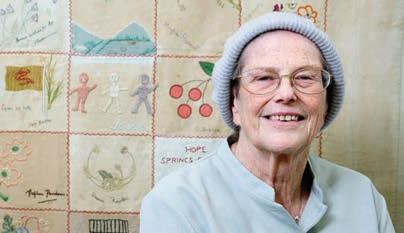
The patchwork squares of the Changi quilt, kept in the British Red Cross museum in London, have hidden messages. Created by a defiant group of women prisoners during the Second World War, each square tells a story.
It was March 1942 when Daphne Davidson’s ordeal as a civilian internee in Changi jail began; she then gave birth to baby Jennefer in July. Despite the appalling conditions, mother and child survived. Over the following gruelling years, their only permitted meeting with Jennefer’s prisoner-of-war father James lasted one precious hour.
THANKS TO THE RED CROSS Liberation came in August 1945. The Davidsons were reunited, returned to
England and free - but not free of troubles: they faced an English winter and were ill-equipped.
“We only had our clothes from the camp, so we really needed warmer things,” says Jennefer. “I have this debt of gratitude to the Red Cross who gave us our first winter clothes. They also sent us food parcels and my toy Pooh bear.”
Learn more of Jennefer’s story and the secrets of the Changi quilt at redcross.org.uk/changiquilt
This is just one example of support given by the Red Cross to people in times of crisis. 27,000 UK volunteers are part of a global network of 13 million who help millions of vulnerable people every year.
The Red Cross have supported people in crisis for over 150 years. Help to ensure they keep on doing so by remembering them in your will. Every legacy gift we receive is a promise that help will always be there when it’s most needed.
To find out more about our work and leaving a gift in your will to the British Red Cross, call 0300 500 0401 or visit www.redcross.org.uk/legacy
ADVERTISEMENT FEATURE


Photo@TaliaFrenkel(ARC) Find out more about remembering the British Red Cross in your will. Call 0800 138 4000 or visit redcross.org.uk/giftinwill today for your free information pack. When you write or update your will, please remember the work of the British Red Cross. Your promise will ensure that help is always there when someone most needs it, whoever and wherever they are.
British
Cross
Royal
England
Wales
Scotland
Isle
PROMISE TO BE THERE WITH A GIFT IN YOUR WILL
The
Red
Society, incorporated by
Charter 1908, is a charity registered in
and
(220949),
(SC037738) and
of Man (0752).
A look at the neuroscience of our most human traits—love, anger, compassion— and how to harness your mental muscle for a more fulfilling life
BY KIMBERLY HISS
The Beautiful Life Of Your Brain
HEALTH 38

AT THIS VERY MOMENT, the twin Voyager spacecrafts, launched in 1977, are carrying precious cargo on their journey beyond the solar system: among other things, a Mozart aria, greetings in 55 languages and the brainwaves of a young woman newly in love.
Astronomer Carl Sagan led the Golden Record project, intended to introduce the people of Earth to any beings the spacecrafts might encounter. As part of the contents, Sagan’s teammate Ann Druyan had her brainwaves measured with an EEG test, which was then compressed into one minute of sound. Two days before, Sagan and Druyan had realised they were in love—an overwhelming sensation flooding Druyan’s mind during the EEG. Today, 18 years after Druyan became Sagan’s widow, that song of a brain in love (it sounds like exploding fireworks) is still soaring into the vastness of space.
To distill the essence of the human race, Sagan and his team chose to reveal a hint of our brain’s inner workings. To many scientists, the answer to the question of what makes us human lies in the mystery of our brain. “On a physical level, there’s just a bunch of atoms sloshing around,” says Christof Koch, scientific officer of the Allen Institute for Brain Science in Seattle. “But there’s a magical jump where this activity turns into feelings of anger or the memory of your first kiss.”
Advances in technology, such as fMRI scanning, allow us to see how regions of the brain function. Experts hope new research efforts will advance the fight against autism, Alzheimer’s and depression, as well as shed light on questions about how we fall in love or make a tough decision, says Dr Thomas Insel, director of the National Institute of Mental Health. “To understand the brain is the ultimate journey to find out who we are,” he says.
A BRIEF HISTORY OF YOUR MIND
This organ has been evolving for millions of years through a process similar to adding ice-cream scoops to a cone, says David Linden, a Johns Hopkins University neuroscientist. “Lower parts like the cerebellum and hypothalamus, which handle survival-oriented behaviour such as sex drive and eating, haven’t evolved as much, so what a lizard has and what we have aren’t that different,” he says, describing the first evolutionary scoop. “Higher centres involved in emotional processing, such as the hippocampus and

| 11•2015 40 THE BEAUTIFUL LIFE OF YOUR BRAIN ILLUSTRATIONS BY VALERO DOVAL; PREVIOUS PAGE: GETTY IMAGES (BRAIN)
amygdala, are a lot more elaborate in mice than in lizards,” he says of the second scoop. “Then as you move further up, humans have a giant, complex cortex,” he says of the top scoop. This is home to our uniquely human thoughts and language.

“The interaction between these older and newer brain regions is what enriches so much of our lives”
Here’s another way to look at how our brains evolved. “Say someone asked you to build a racing boat, but they gave you a wooden rowboat and said you could only add things to make it into the racing boat,” says Linden. “That’s evolution: you can only subtly tweak what was there before and can’t change the basic plan.” The interaction between these older and newer brain regions makes us who we are today.
“Both people and mice can feel pleasure from eating and making babies, which both need to survive and pass down their genes. But only a human can take pleasure in fasting or abstaining from sex, which has no evolutionary advantage. The miracle of human thinking is that our ancient pleasure circuitry can be activated by higher, more complicated parts of our brain,” Linden explains.
“That we can take pleasure from things that are utterly arbitrary is what enriches so much of our lives.”
Human evolution is a glacial process, but we can directly affect our personal “evolution” in our lifetime. “There’s a well-known saying, ‘Neurons that fire together, wire together’,” says neuropsychologist Rick Hanson, meaning that repeated patterns of thoughts and feelings change our brain structure. Here’s how our brain operates during seven situations; we can use these insights to flex our mental muscle.
YOUR BRAIN UNDER CRITICISM
Think back to your last performance review. “Your boss starts by saying 19 positive things,” says Hanson. “But if there’s one piece of criticism at the end, that’s what you remember. What sticks is the negative 20th.”
That overreaction—called negativity bias in psychology circles—helped keep ancient humans alive.
“Ancestors had to ‘get carrots’, meaning food and mates, and ‘avoid sticks’, such as predators,” Hanson explains. “If you don’t get a carrot today, you’ll have another chance tomorrow. But if you fail to avoid a predator? Game over! Our brains became wired to focus on bad news. It’s like Velcro for bad experiences but Teflon for good ones.”
11•2015 | 41
READER’S DIGEST
Fortunately, simple practices can help counteract this bias. “Negativity quickly becomes neural structure,” he says. “But positive experiences can take more time to encode. Intentionally feeling positive experiences longer helps them sink in, which can help you become happier and more resilient.” Savour receiving a compliment. Be mindful during happy moments; note details so they’re easier to remember.
YOUR BRAIN WHILE PROCRASTINATING
When you put off a pressing project, you avoid negative emotions caused by an unpleasant task because you want to feel good now. But all you’re doing is giving the problem to your
future self. “So the question neurologically becomes, ‘Why do we treat Future Self like that?’ ” says Timothy Pychyl, an associate professor of psychology at Carleton University in Ottawa, Canada. One study used fMRI to see what parts of the brain were active when subjects thought about their present selves and their future selves, and found that the brain thinks about the future self more similarly to the way it thinks about a stranger.
Procrastination is also the struggle between two different brain systems. The limbic system, responsible for our basic emotions, is an old part of our brain (in the second scoop). It’s a fast automated system that responds nonconsciously. It wants to feel good

THE BEAUTIFUL LIFE OF YOUR BRAIN
AD-083 revA l Renew Inserts help prevent accidental bowel leakage l A clean and hygienic alternative to pads and incontinence pants l Soft, comfortable and easy to use internal protection for men and women l Now available on prescription through the NHS Regain control today! Call or visit our website for a free demo pack 0800 542 0814 www.renew-medical.uk DO YOU SUFFER FROM A LACK OF BOWEL CONTROL? Regain control with
now. Then there’s the newer prefrontal cortex (the third scoop), home of executive function, which involves planning and impulse control. It’s a slower process you have to kick consciously into gear.

When you contemplate doing your taxes, the limbic system first activates with its urgent goal of feeling better now, accomplished by avoiding this dreaded task. Lagging behind is the more responsible prefrontal cortex, which you need to engage to think about the benefits of completing your tax return on time.
“Intense, romantic attraction is a more primitive response than feelings of attachment”
YOUR BRAIN IN LOVE
The luckiest among us relate to not only the romantic love Ann Druyan experienced when she first fell for Carl Sagan, but also the long-lasting bond that linked the couple until Sagan’s death 19 years later. Those two distinct types of love arise from different brain regions, says Helen Fisher, a member of the Centre for Human Evolutionary Studies at Rutgers University.
“Love originates in the ventral tegmental area in the oldest part of the brain near centres that govern thirst and hunger,” she explains. “It’s a basic drive that focuses our energy on winning a mating partner.”
A primary brain region linked with attachment, however, is the ventral pallidum, which is more modern (in the third scoop). “Intense, romantic attraction is a more primitive response than feelings of attachment, which are more recent,” she says. This circuitry is linked to lifelong love.
“People in love longterm show activity in the ventral medial prefrontal cortex, which is linked with ‘positive illusion’—the ability to overlook cons,” Fisher says. “People in long-lasting relationships say things like, ‘It annoys me when he doesn’t pick up his socks, but I love his sense of humour’. ”
This mindset is a huge factor in making relationships last, as it helps to nurture loving feelings long after the honeymoon period has ended.
YOUR BRAIN ON ROAD RAGE
When another driver cuts you up on the road, you assume that person is an idiot, and that makes you angry.
Our brains were built to overreact to a perceived threat. “The same neuronal machinery that protected our ancestors from charging lions is primed when we encounter stresses such as traffic,” says neuropsychologist Rick
11•2015 | 43
READER’S DIGEST
Hanson. Your body releases the hormone cortisol; this sets off the brain’s alarm by stimulating the emotionally charged amygdala while damaging neurons in the hippocampus, which shrinks the calming part of the brain.

To bring this stress response under control, we can use our newer brain regions, like the prefrontal cortex, to regulate our older ones. When you feel angry behind the wheel, forcing yourself to refocus—say, by thinking, I’ll be only 15 minutes late—may help.
YOUR BRAIN WHILE DREAMING
A participant came to a dream study with a dilemma. He couldn’t decide between two graduate programmes near his Massachusetts home and two further west. Then he dreamed he was in a plane flying over a map. The pilot said they were having engine trouble and needed to land. The student suggested Massachusetts, but the pilot said Massachusetts was “very dangerous”. The student woke up realising the right choice was away from home.
By conducting such studies, Deirdre Barrett, assistant clinical professor of psychology at Harvard University, has been exploring the workings of the brain’s sleep circuitry. After you conk out your brain becomes quiet, but after 90 minutes it reactivates with rapid eye movement (REM) sleep, becoming as active as when you’re awake. But that
activity comes from a different distribution of regions.
While the primary visual cortex, which receives light input from your eyes, is less active while you’re sleeping, the secondary visual cortex, which is involved when you imagine something, is most active during REM sleep. The motor cortex turns on, firing off movement commands that are countered by another area that paralyses muscles during sleep. Also, the “censoring” prefrontal cortex, which helps ensure you behave in conventional ways, becomes less active while you snooze.
Not only does this distribution of activity match the features of dreams —rich environments where events take bizarre twists—but it also makes dreams fertile ground for solving the problems of your waking life.
To maximise dreaming’s problemsolving benefits, Barrett suggests that at bedtime, you phrase your concern in a succinct way by writing it or repeating it to yourself. Then come up with a visual image representing the issue, and tell yourself you want to dream an answer. And write it down as soon as you wake up. “This transfers them to long-term memory,” says Barrett.
YOUR BRAIN WHILE LISTENING TO MUSIC
Imagine you’re in line for coffee and a catchy song comes on the radio. The resulting cascade of mental activity it
| 11•2015 44 THE BEAUTIFUL LIFE OF YOUR BRAIN
takes to process the music “touches on all the most advanced aspects of human cognition”, says Robert Zatorre, professor of neuroscience at the Montreal Neurological Institute and Hospital at McGill University.
First, the sound hits your ear, activating a series of structures from the cochlea (where vibrations are turned into electrical impulses) to the brain’s cortex. When you recognise the tune— its name or where you last heard it— your auditory cortex is connecting with regions that handle memory retrieval. Then, if you start tapping your foot, you’ve activated the motor cortex in a particular way because you’re tapping to the exact beat of the song.
Finally, if it has you feeling happy, the song has turned on your brain’s reward system—ancient, powerful circuitry triggered by essentials for survival such as eating and sex.
Why does music engage that lifepromoting system? Scientists are still trying to work that out, but what happens to your brain may provide a clue. “Music increases cross talk between brain structures in old reward centres that handle pleasure and newer areas of the cortex that handle prediction and anticipation,” says Zatorre. In one
study, he found that the brain released dopamine, a chemical linked to pleasure, in anticipation of a subject’s favourite part of the song. So it may be that music fuels your brain’s desire to detect patterns and solve problems.
YOUR BRAIN
WHILE MEDITATING
Meditation may be a powerful way to build our brains. The practice can grow brain tissue, improving our moods and making us more resilient.
“It engages the entire brain,” says Hanson, accessing sensory and emotional experiences, wants and drives, and ancient substrates of consciousness. “Meditation seems to engage the most modern parts of the brain as well as the most ancient ones.”
One study showed that eight weeks of mindfulness meditation boosted grey-matter density in several regions, including the hippocampus (learning and memory), and decreased greymatter density in the amygdala (which plays a role in generating the feeling of stress).
“Sitting down, focusing on breathing and relaxing every day is actually going to build brain structure?” Says Hanson: “That’s pretty cool!”
TECHNOLOGICALLY CHALLENGED
According to a recent survey, 27 per cent of people believe a “gigabite” is an insect found in South America.
SOURCE: BUZZFEED.COM
11•2015 | 45
READER’S DIGEST
The Real Truth About Red Wine
By sus A nn AH H ick L ing

Susannah is twice winner of the Guild of Health Writers Best Consumer Magazine Health Feature
With the nights draW ing in, we’re likely to favour a glass of red over white or rosé. But when it comes to your health, does red wine really get a thumbs up—or should it get a thumbs down?
Some experts are now saying that resveratrol— a polyphenol found in red wine—is not the wonder antioxidant it’s cracked up to be. A study published last year in JAMA Internal Medicine found that it won’t help you live longer after all.
While that could come as a blow if you enjoy quaffing a glass of red for your health, the good news is that different research is showing that it could contain other beneficial antioxidants. For starters, a study published last year in The Journal of Nutrition suggests that anthocyanins (found in red grapes, wine and berries) may protect against type 2 diabetes.

Also, a study published in BMC Medicine in May showed a strong link between an increased life span and a diet rich in polyphenols, specifically stilbenes, which are found in red wine and olives. Aperitif, anyone?
| 11•2015 46 HEALTH
© Binh Thanh Bui/shu TT ers T ock / © racorn/shu TT ers T ock / © a lexander r a T hs/shu TT ers T ock

Moderate consumption of red or white wine (one to two small glasses for women, two to twoand-a-half for men) can help protect the heart—but only if you exercise regularly. That was the finding from
a recent Czech study, showing that lifestyle factors can affect whether wine is good for you or not. In fact, regular over-consumption of alcohol can increase blood pressure sharply over time.
Stre SS can make you fat!
Or, at least, that’s what a study last year from The Ohio State University suggested. It found that women who were stressed burned 104 fewer calories than those who were more chilled after both groups ate high-fat meals.
Researchers say this shows that stress actually throws off

our metabolism, making us pile on the pounds. Feeling tense also influences our hunger hormones, making us feel hungry even when we’re not. We then opt for foods that are high in sugar and fat. They make us feel better— until we get on the scales, that is.
11•2015 | 47

mEn’s HEALTH: HOW TO AvOid BEcOming
A grumpy OLd mAn
We’ve all seen it happen—carefree young guys who turn miserable in later life. here’s how to make sure you laugh more often:
rediscover your smile. consciously smile at simple pleasures—with luck, that forced smile will become second nature.
Exaggerate problems. overstating a situation when you tell others can help you regain a humorous view.
find a humour buddy. This is someone with whom you can purposefully exchange funny tales.
Tease and be teased in return. it’s a way of highlighting the humour in our little foibles.
chuckle at life’s little annoyances. stepped in dog poo? Think about it as if it happened to someone else— laugh at them, and then yourself.
Fever Pitch
With the winter cold and flu season approaching, you could find yourself fighting a fever, one of the body’s natural protective mechanisms to defeat a virus or bacterial infection. Officially, if your temperature’s above 37.5C (99.5F), that’s a fever.
HOW TO TAkE A TEmpErATurE?
■ Under the tongue with your mouth closed. Make sure you haven’t eaten or drunk anything for 15 minutes.
■ Under the armpit is OK too, as long as the thermometer is tucked tightly under the arm and held close against the body.
■ Beware: ear thermometers are quick but it’s easy to make a mistake if they’re not inserted properly.
HOW dO yOu TrEAT iT?
■ Stay hydrated. Drink plenty of water and eat normally.
■ Don’t bundle up in warm clothing.
■ A fever above 40C is a cause for concern. Take ibuprofen or paracetamol to bring it down, but avoid aspirin.
sEEk mEdicAL ATTEnTiOn if:
■ Medication has failed to reduce a fever above 40C.
■ You’re 65-plus and have a temperature over 38.3C.
■ A child under three months has a fever above 38C.
Healt H | 11•2015 48
© a xel Buecker T /shu TT ers T ock / © i mage Poin T Fr/shu TT ers T ock / © nokkae W /shu TT ers T ock
Six Surprising Facts About Psoriasis
1. It’s an immune response gone wrong. A type of white blood cell that normally fights foreign invaders starts attacking healthy skin cells.
2. The condition isn’t caused by poor hygiene, nor is it contagious.
3. Certain triggers can cause a flare-up. These include stress, an injury, drinking too much, smoking, menopause and some medicines.
4. There are different types of psoriasis. While most people get scaly patches on their knees, elbows or torso, it can also affect fingernails, scalp and even genitals.
5. Psoriasis is incurable, but there are lots of treatments. They vary from creams and tablets to UV light therapy.
6. A new drug is being touted as a “miracle” treatment. Trials of ixekizumab found it brought improvement in 90 per cent of cases.

cELEBs WiTH psOriAsis
american TV personality kim kardashian and her mum kris Jenner have suffered from psoriasis, as have comedians alan carr and Ben elton. some well-known singers are said to be afflicted too, including art garfunkel, liam gallagher and Britney spears.
THis mOnTH’s HEALTH cHEck: sTudy yOur HAirBrusH
You can lose between 50 and 100 hairs a day, and even more when you wash your barnet. But if you’re losing an excessive amount, ask your doctor to check your levels of blood ferritin, an indication of how much iron your body is storing. low levels may be related to unexplained hair loss. Thyroid disease is another common cause, while conditions such as lupus and diabetes may also make your hair fall out. and while you’ve surely heard the expression “shock of hair”, did you know that a severe emotional shock or physical trauma, such as surgery, are other explanations for a thinning thatch?

Reade R ’s d igest 11•2015 | 49
e “Hidden” Costs Of A Cancer Diagnosis
WHILE CANCER CAN BE AN EXPENSIVE CONDITION TO TREAT, few consider the other costs that a cancer diagnosis could bring.
Research carried out by Macmillan Cancer Support found that in 2013, four in five people were on average £570 a month worse off as a result of a cancer diagnosis.*
Travel for treatment, childcare costs, extra help around the home – these are all additional costs a cancer sufferer can face, at a time when income can also fall.

“I would like to say my AXA PPP nurse has always been very helpful and understanding and it is like talking to a friend”
MRS TAPPENDEN, ESSEX
Even small things like the purchase of a wig, if chemotherapy treatment has caused hair loss, can add up. ese sorts of costs can cause concern at a time when money should be the last thing on someone’s mind.
Reader’s Digest has teamed up with AXA PPP healthcare to bring readers Cancer CashCover- an affordable cash plan specifically for cancer.
ADVERTISEMENT FEATURE
“I had my dedicated nurse just a call away. I am sure the way I was treated helped me to a full recovery”
MS HODGINS, HERTFORDSHIRE

Once you’ve had the plan for six months, if you’re diagnosed with cancer for the first time, you could receive a cash lump sum of up to £60,000** to help support you and your family. It also offers access to licensed cancer drugs if they aren’t available to you on the NHS and 24/7 telephone support from dedicated cancer nurses.
*Research by Macmillan Cancer Support, Cancer’s Hidden Price Tag (2013). **Subject to the level of cover chosen.
Not all cancers are covered by this plan. To find out more on what is and what isn’t covered, call AXA PPP healthcare on 0800 5870 842 or get a quote online.
Lines are open 9am to 8pm weekdays. AXA PPP healthcare may record and/ or monitor calls for quality assurance, training and as a record of the conversation.
Reader’s Digest are introducing customers to AXA PPP healthcare to provide affordable cancer cover to readers, please visit www. axappphealthcare. co.uk/readersdigest/ VIVAT Finance Limited, who are the holding company of Reader’s Digest, are an Introducer Appointed Representative of AXA PPP healthcare limited.
What Do You Really Mean?
By max pem B erton

Max is a hospital doctor, author and newspaper columnist
What doctors say isN’t alWays as iNterestiNg as What they doN’t say. They’re deft at obfuscation and euphemism. Pruritis ani, after all, sounds a far nicer thing to be diagnosed with than its literal translation, itchy bum. There are inevitably patients that prove to be “challenging”. There, I’m at it myself. What I mean is that they’re a pain in the neck—not, of course, that I would ever say that.
Mr Chambers has been in to the A&E department over eight times in the past two weeks. He’s what’s known as a “multiple attender”: he’s been complaining of different physical problems on each presentation, trying to get himself admitted.
Last night, he struck gold: “If you don’t admit me, I’m going to kill myself,” he stated after being told he should go home as there was nothing wrong. The poor junior doctor who saw him obviously didn’t know what to do. The chances are he’s bluffing, but it takes a fairly hardened doctor to call his bluff and discharge him. So he was admitted. To the psychiatric ward where I’m working. Great.
Flicki N g through the N otes, it’s clear from each exasperated doctor that saw him that they could find nothing wrong. But nowhere in the notes did anyone say what, reading between the lines, was fairly obvious: the man’s making it up. Instead, there were allusions to it: “No physical cause found. Possible socio-economic factors motivating
| 11•2015 52 H ea Lt H

presentation,” for example, meaning he’s got no money and wants food and a bed for the night.
He comes into my office. This man isn’t suicidal, I’d bet my life on it. In fact, he looks cheerier that I do, although at 9am this isn’t particularly difficult. “You’re not suicidal are you?” I ask after he’s been talking merrily for 20 minutes.
There’s a pause. “Yes, I am. Absolutely,” he says in a chirpy voice.
Being suicidal is rather a difficult thing to prove. There’s no test and no scan for it. But of course, I don’t say to him that I think he’s lying. “Is there another reason you wanted to come into hospital?” I ask.
He looks at me. “Can you get us into a hostel?” he murmurs.
Ah! This is why he’s here. He knows that if I write him a letter, he’ll get a place in a hostel.
The consultant sees him on the ward round and comes to the same conclusion. We agree to discharge Mr Chambers with a letter to the council stating that he’s homeless and asking them find him a room in a hostel. Mr Chambers beams. “Thanks,” he says as he walks out.
I get up to leave. “Would you mind staying late today and summarising these notes for a report tomorrow?” asks my consultant as he hands over a pile of papers.
My heart sinks. “Of course, no problem,” I say. By which I meant, “Yes, of course I mind staying late, but I don’t really have a choice, do I?”
Illustrat I on by l aura b re I l I ng 11•2015 | 53
medicaL mytHS—BuSted!
A Shock Will Cure Someone Of Hiccups

wHere did tHe mytH come from?
Hiccups occur when the diaphragm— a large sheet of muscle that sits at the bottom of the lungs between the chest and the abdomen—goes into a spasm. This causes air to rush into the lungs and the vocal cords to close quickly, resulting in the “hic” sound.
wHat’S tHe trutH?
“Shocking” someone out of hiccups is a nice idea, but is unlikely to work. However, there are plenty of techniques that have been shown
to stop hiccups effectively. Most of them involve one of two mechanisms —either increasing the level of carbon dioxide in the blood or stimulating the vagus nerve, which controls the diaphragm.
Breathing into a paper bag, for example, increases the level of carbon dioxide in the blood temporarily, as does holding your breath. It’s thought that this makes the brain concentrate on the rising carbon-dioxide levels, rather than hiccups. Drinking a glass of water upside down requires you to hold your breath and also has the additional benefit of stimulating the vagus nerve, as does tickling the roof of your mouth.
So, tHere’S notHing to worry aBout?
There have been some reported cases of hiccups going on for weeks, months and even years. But these are very rare. For the vast majority, a bout of hiccups lasts no more than five minutes and they will go away on their own—no shock required.
Illustrat I on b y D a VID H u MPH r I es | 11•2015 54 H ea Lt H
FOR MORE, GO TO readerSdigeSt.co.uK/HeaLtH
Food For Thought
GIVE YOUR BRAIN A HELPING HAND
The brain is the most complex machine on the planet and the largest and most important part of the nervous system. It contains more than 80 billion brain cells called neurons with intricate pathways linking our senses, our movements and our memory.
Once we hit our forties occasional lapses such as forgetting where we put our glasses or blank on a friend’s name can become more common. While it is alarming to have a ‘senior’ moment now and then the good news is that there are simple, positive lifestyle changes that can help keep your brain in normal working order.
5 LIFESTYLE STEPS TO HEALTHY BRAIN FUNCTION & MENTAL PERFORMANCE
Be active – but sleep well. Take plenty of regular exercise – but be sure to get a good night’s sleep too. Exercise also lowers blood pressure, improves cholesterol levels, fights diabetes, and reduces mental stress, all of which can help your brain as well as your heart.
Get Mental Stimulation. Make a list — of grocery items, things to do, or anything else that comes to mind — and memorize it. An hour or so later, see how many items you can recall. Make items on the list as challenging as possible for the greatest mental stimulation.
Cherish friends. Strong social ties have been associated with lower blood pressure and longer life expectancies.
Improve your diet. Good nutrition can help your mind as well as your body. An overall balanced diet is essential. In particular, three B vitamins; folic acid, B6, and B12, can help support normal homocysteine metabolism. High levels of homocysteine have been linked to an increased risk of dementia. Fortified cereal, other grains, and leafy green vegetables are good sources of B vitamins.
Add a supplement. Vitabiotics Neurozan provides a comprehensive formula to help safeguard your daily dietary intake of important nutrients for all round health and wellbeing. It provides iron, zinc and iodine which contribute to normal cognitive function, plus pantothenic acid which contributes to normal mental performance. It also provides vitamins B12, B6, thiamin (vit B1), folic acid and magnesium which contribute to normal psychological function. A general multivitamin is not necessary in addition to Neurozan.
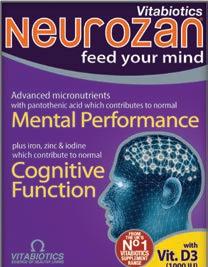

Vitabiotics Neurozan RRP £9.95 for 30 tablets (a month’s supply). Available from Boots, Holland & Barrett, Tesco, Waitrose, independent pharmacies and health food stores and online at www.neurozan.com


ADVERTISEMENT FEATURE

Tails of the Unexpected
We have a powerful connection with our four-legged friends—but did you ever imagine an animal could save your life? We meet the creatures who’ve gone far beyond the call of duty
BY AMANDA RILEY-JONES
56 INSPIRE
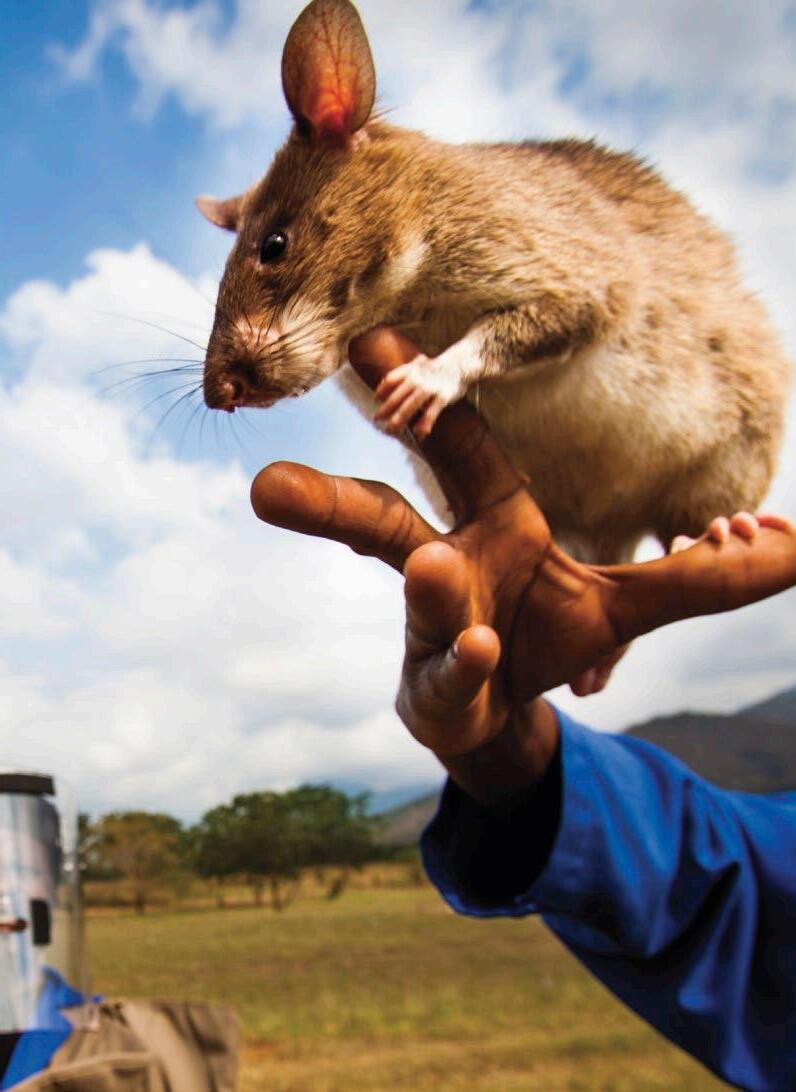
Giant Rats Save Thousands Of Humans
Rats traditionally get a bad rap. We tend to think of them as diseasespreading vermin and like to give them a wide berth. But a crack team of skilled rats has saved thousands of human lives in Tanzania, Angola and Mozambique—and Cambodia is next on the list.
Belgian organisation APOPO is training giant African pouched rats to detect two of Africa’s cruellest menaces. The first is landmines. When civilians have to risk their lives just to fetch water or farm their land, they’re locked into poverty and development is impossible. Wanting to find a local, affordable solution, APOPO founder Bart
Weetjens remembered the pet rodents he’d kept as a boy in Belgium. He knew rats were intelligent, sociable and teachable. They were also in plentiful supply and relatively cheap to train.
APOPO’s heroic rats are also on the front line against Africa’s desperate TB crisis, where clinics are overwhelmed and diagnostic TB tests often inaccurate. (Globally, around 1.5 million people die from TB every year, and every untreated patient can infect up to a dozen other people.)
The rodents are socialised as pups and then trained so that the sound of a clicker means food, and they know that they need to search for the target scent to earn their reward—peanut and banana mash is the favourite.

TAILS OF THE UNEXPECTED | 11•2015 58 PREVIOUS
IMAGE: © ALVARO LAIZ AND DAVID RENGE / © APOPO
They’re trained to sniff out either TNT explosive (contained in mesh tea-balls or in deactivated landmines) or TB (using sputum samples from patients suspected to be infected). Mine-detection rats complete their nine-month training on a field planted with both deactivated and live landmines.
Since 2007, the rats—which live up to eight years in captivity—have detected over 56,000 landmines and other explosives. The four-legged explosives experts are so light-footed, there hasn’t been a single casualty.
They’ve also screened almost 312,000 TB samples and detected over 8,000 cases that the public clinics missed. While it takes a lab technician all day to evaluate 20 samples, a rat can get it done in just ten minutes. Weetjens adds, “It’s so beautiful to see our rat trainers and their HeroRATs working jointly for a better world.”
■ Adopt a HeroRAT for yourself or as a gift at apopo.org
SUPERIOR SMELLING
Researchers at the University of Tokyo have discovered that rats have one third more genes dedicated to smell than dogs— although elephants have the best sense of smell of all. The number of smell genes are:
Human: 396, Dog: 811, Rat: 1,207, Elephant: 1,948

Bailey Rescues Children From Fire
It seemed like any other day when fitness instructor Chantelle Lister set off to work at 7am. It was the school holidays, so her daughters Loren and Mollie, 17 and six, and 11-year-old son Charlie were still asleep in bed.
But within an hour, the family home in Kettering, Northamptonshire, went up in flames. The fire started in the conservatory and lethal smoke from the uPVC windows started filling the ground floor while the youngsters slept.
Thankfully, the family’s beloved dog Bailey rushed to their rescue.
Despite the thick smoke starting to engulf the staircase, the four-year-old Terrier-mix made his way upstairs
READER’S DIGEST 11•2015 | 59
and kept barking and scratching at Loren’s door until she awoke.
Loren opened the door to thick black smoke streaming up the stairs and the sound of smashing glass. Struggling to breathe, the teenager ran into her siblings’ room and managed to get the terrified children out through a bedroom window and onto a flat roof.
After successfully raising the alarm, Bailey scampered back downstairs to try to get out. But tragically he was trapped in the burning house.
“The firemen pulled Bailey out and tried to resuscitate him, but he was dead,” says Chantelle. “They put a blanket over him and I kept thinking, That could have been one of my children. Bailey was such a character and so loving. The children wouldn’t be here without him—he’s my hero and I’m eternally grateful to him.”
■ Nominate a heroic animal for the Blue Cross Medal at bluecross.org.uk

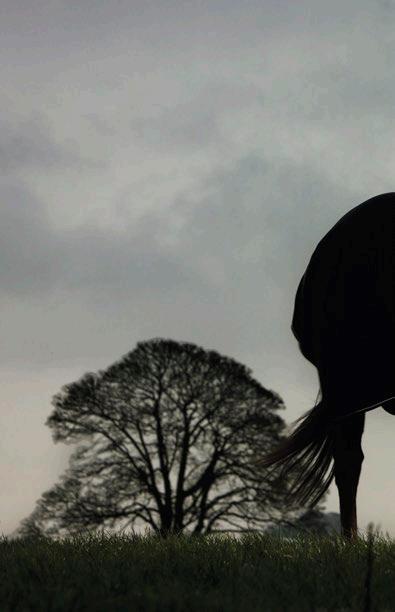
Kerry Gallops To The Rescue
Fiona Boyd, from Castle Douglas, had been working with cattle for more than 20 years when, on a bright July day, she decided to move one of the cows and her calf out of the field.
“You have to separate the mothers from their calves when they’re very young. You walk the two of them down to a special calf house but then the mother is returned on her own
TAILS OF THE UNEXPECTED | 11•2015 60
SMITH: THE GUARDIAN NEWS & MEDIA
SARAH

to the milking parlour. It sounds horrible, but this is what happens on a dairy farm,” she told a reporter.
She started to walk across the field behind the calf, expecting the mother to follow happily. But when the two-day-old calf started to bleat, its protective mother charged at Fiona. “With her head she butted my shoulder, knocking me to the ground,” she recalls. “The cow, 600kg and angry, was intent on attacking me.
I was screaming, but there was no one around to hear me. Terrified, all I could do was curl up into a ball.”
But then Kerry Gold, Fiona’s chestnut mare, galloped over from the other side of the field and began kicking the cow with her back hooves. “The cow left and Kerry stood protectively beside me.”
Fiona was left with cuts, bruises and a tender back. “I’ve no doubt that Kerry saved me from being killed.”
READER’S DIGEST 11•2015 | 61
© MURDO G MACLEOD
Dogs Team Up To Save Drowning Toddler
They’re tough breeds and they have the rough-and-tumble names to match. But free-spirited Aussie dogs Tank the Rottweiler-cross and Muck the Staffie-cross instinctively knew when a small child was in danger, and their naturally protective natures averted a tragedy.
One afternoon in December, Georgie Hillier thought her twoyear-old son Max was playing in the back garden of their home in rural Queensland, Australia. But when she went to check, there was no sign

of Max or their dog Tank. When she couldn’t find him, she jumped in her car and started scouring the neighbouring property. She was frightened he could have fallen into one of the dams or reservoirs.
Then she found Tank with the neighbour’s dog Muck. They were both running around the dams— barking furiously and covered in mud and slime.
“I just panicked. I was running around, checking the sides of the dams,” Georgie told Sara Hicks from radio station ABC Local. While she kept searching, a neighbour called the police. Eventually, a woman who had found Max heard Georgie’s calls and brought the unharmed toddler out to her.
There was no one there to witness what exactly happened, but the RSPCA’s Michael Beattie takes up the story. “When the police arrived on the scene they saw quite distinct drag marks. It was apparent that young Max had actually been pulled out of the dam by one of the dogs— most likely Tank. Max was making moves to go back into the dam and Muck was virtually heading him off at the pass. It was the police’s opinion that the only way that Max was rescued from drowning was by the two dogs.”
For saving the toddler’s life, the daring duo received the RSPCA’s prestigious Purple Cross award for bravery—plus two very large bones.
| 11•2015 62 TAILS OF THE UNEXPECTED
© ABC LOCAL: SARA HICKS
Pippa Makes The Purr-fect Night Nurse
We’re a nation of cat lovers but, let’s face it, they’re not known for acts of altruism. So meet Pippa, an extremely unusual feline.
The black-and-white cat was dumped in a box outside a shop and rehomed by the RSPCA to the Jansa family in Whitstable, Kent. They were charmed by her gregarious character—but never guessed she’d become a lifesaver.
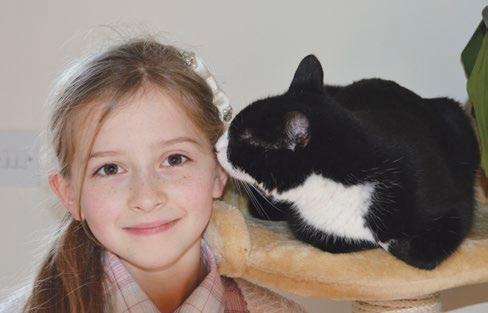
Eight-year-old Mia Jansa had type one diabetes and had become a dab hand at testing her blood throughout the day, as well as having something to eat or drink to restore her blood-sugar levels. But the danger was at night. Mia was prone to having hypoglycaemic episodes when asleep and, left untreated, a hypo can lead to a coma, medical complications and even death.
Soon after she was adopted, Pippa
went into Mia’s bedroom in the middle of the night and woke her up. When the child tested her bloodsugar levels, she found they were dangerously low. Ever since, Pippa regularly visits Mia at night. And if she can’t get her to wake up, she raises the alarm.
“Pippa does this of her own accord,” says Pippa’s mother Laura. “We don’t reward her with food because we don’t want to encourage false alarms, but she gets plenty of cuddles instead. It gives me extra peace of mind to know someone else is keeping an eye on Mia.”
A CAT APART?
Alice Potter, pet scientist at the RSPCA, says, “Although dogs alerting their owners to medical problems such as epilepsy, cancer and dangerously low blood pressure is well known, the RSPCA isn’t aware of any evidence in cats. Perhaps Pippa will be the cat to inspire new research in this area.”
11•2015 | 63 READER’S DIGEST © RSPCA



Terms and Conditions
■ There are three categories—one for adults and two categories for schools: one for children aged 12–18 and one for children under 12.
■ In the adult category, the winner will receive £2,000, and two runners-up will each receive £200.
■ In the 12–18s category, the winner will receive a Samsung Galaxy Tab S2 (8.0, WiFi) and a Samsung Gear 5 watch, plus £150 for their school. Two runners-up will each receive £100.
■ In the under-12s category, the winner will receive a Samsung Galaxy Tab S2 (8.0, WiFi), plus £100 for their school. Two runners-up will each receive £75.
■ Your stories should be original, unpublished and exactly 100 words long. Please submit them online at readersdigestco.uk/100-wordstory-competition by February 20.
■ The editorial team will then pick a shortlist of three in each category and post them online on March 6. You can vote for your favourite, and the one with the most votes will scoop the top prize. Voting will close on March 27 and winning entries will be published in our June issue.
■ The entry forms are on our website, along with details of the prizes.
Amanda Brooke
“He looks hungry, Mum.”
“Ignore him and keep walking,” Helen says, tugging her daughter’s hand.
The dog follows, overgrown claws scraping the pavement as it quickens its pace to keep up. A wet nose touches the back of Helen’s knee, then a head squeezes in the gap between them. Brown, doleful eyes look up, pleading.
Stopping at the kerb, Helen keeps one eye on the bedraggled mutt. When she tries to move, it barks and quickly blocks her path. There’s a flash of crimson as a bus speeds past.
Helen gasps, then turns to her new friend. “Come on, boy.”

■ Amanda Brooke’s The Missing Husband is out now in paperback and ebook, published by HarperCollins.

Would you like help to write your own autobiography? Turn the page for details.
66 | 11•2015 100-WORD-STORY COMPETITION
Paul Finch
“Darren,” Sue whispered, “There’s someone in the wardrobe.”
“Go back to sleep,” he muttered. Her nervousness at night had always irritated him.
“No. We must check. That lunatic who escaped from the asylum…”
Grumpily, he climbed from the bed and fumbled his way across the darkened room. “For God’s sake, put the light on,” he said over his shoulder.
The bedside lamp came on as Darren yanked the wardrobe open—and choked in horror. Sue stood facing him, propped against the compartment’s wooden back, throat slit.
“Is it anyone we know, darling?” came a singsong voice from the bed.
 ■ Paul Finch’s Dead Man
■ Paul Finch’s Dead Man
Walking is available now in paperback and digital format, published by Avon.
Michele Gorman
Buttercream runs in Sarah’s veins. She baked her own cakes at six. All thanks to Mum. She fantasizes about Mary Berry tasting her sponge. “Excellent,” Mary always says. “Can we be friends?”
But this isn’t pretend. The Bake Off tent swelters as the cameras zoom in. Paul Hollywood calls her forward. “Mum’s Morning Muffins,” she whispers. She wants to run away. It’s the most sick-feeling moment of her life. Since the funeral anyway.
“Perfect,” he finally says. “Your mum would have been proud.”
Sarah beams. Mum would be proud. That’s the real prize. Sometimes reality is even better than dreams.

■ Michele Gorman’s Match Me
If You Can comes out in digital format and paperback in January.
Rules: Please ensure that submissions are original, not previously published and 100 words long (not including the title). Don’t forget to include your full name, address, email and daytime phone number when filling in the form. We may use entries in all print and electronic media. Contributions become world copyright of Reader’s Digest.
Entry is open only to residents of the UK, Channel Islands, Isle of Man and Republic of Ireland. It is not open to employees of Vivat Direct Ltd (t/a Reader’s Digest), its subsidiary companies and all others associated with this competition, their immediate families and relatives living in an employee’s household. The judges’ decision is final.
67 READER’S DIGEST 11•2015 |
© MARK MCNULTY
Everyone Has A Story To Tell
Roy Moëd, the founder of LifeBook, talks about the experiences with his father that led him to set up the company
LIFEBOOK HAS BEEN A VERY PERSONAL JOURNEY FOR ME. My father Jules was almost blind in his latter days and felt he had nothing more to contribute. I found I was continually shutting him down when he started a story, to the point that our conversation dried up. I drove back to the office feeling terrible and feeling I’d achieved the very opposite of my intention to cheer him up.
Desperate to find a solution,
I came up with the precursor to today’s LifeBook. I asked a friend, Kathy, to visit dad for an hour each week at a set time to interview him, to get the stories I was too impatient to listen to and ask him, “What happened next?” and, “How did you feel about..?”
Dad eagerly looked forward to his interviews, spending the intervening days planning the chapters of his life story and making notes in preparation for Kathy’s next visit. Dad said he was remembering things he didn’t know he’d forgotten and his book was full of stories we had never even heard! We now proudly deliver hundreds of beautifully presented autobiographies to families all over the world.

Fun, engaging and rewarding We all have our own personal memories and stories that make
100-WORD-STORY COMPETITION
up our lives. Whether it’s childhood memories, family experiences or a rewarding career, we believe everyone has a story to tell, for their families.
LifeBook is truly a “gift of a lifetime”, a legacy that lives on for generations celebrating a life lived and shared with everyone in it and forever a treasured archive.
With our face-to-face interviews, rediscover the many stories and experiences that have shaped yours and your loved ones’ lives. Your words and photographs will be effortlessly transformed into beautifully illustrated copies of your own personal autobiography.
To ensure your LifeBook experience is fun and relaxing, the author is supported at every step of their journey by their own dedicated team made up of a project manager, interviewer, ghost-writer and editor. With five beautiful hardbacked books to share, it’s fun, engaging and rewarding. Start now—why put it off a moment longer?


Now it’s your turn to have a legacy. To discover more about the LifeBook experience, how we can help you write your very own autobiography and how it can benefit you and those you know and love, just call us on 0800 999 2280 or email us at digest@lifebookuk.com
69 READER’S DIGEST 11•2015 |
BY FIONA HICKS

These feats of engineering aren’t just functional, they’re brimming with tales
70
INSPIRE
Bridges Best of British

➸ Tower Bridge
LONDON
Thousands of tons of steel, Cornish granite and Portland stone come together to create this iconic bridge. Perhaps its most famous feature is its bascules—giant, moveable roadways that raise to 86-degree angles to allow ships to pass through. In an average year, these will lift an impressive 850 times. This design is not without incident, however: in 1952, London bus driver Albert Gunton had to speed and leap from one bascule to the other as the bridge began to rise with the number 78 bus still on it.
An engineering marvel to this day, its construction employed more than 400 workers and took eight years of labour to complete. The bridge was finally ready to be unveiled in 1894, and it has withstood the elements (with the help of a few repairs) for more than 120 years.
Today, it’s both a functional bridge and a popular tourist attraction. Along with an exhibition, visitors can amble along the highlevel walkways that were designed to allow pedestrians to cross the bridge when the bascules were raised. Closed in 1910 due to a lack of use, they were reopened in the early 1980s and offer spectacular panoramic views of London.
■ Visit towerbridge.org.uk for details

Iron Bridge SHROPSHIRE
The first arch bridge in the world to be made of cast iron, this revolutionised the craft of bridgebuilding. Opened in 1781, it was a crucial factor in the development of the iron trade in Shropshire and is recognised as one of the great
BEST OF BRITISH | 11•2015 72 PREVIOUS IMAGE: © PETER BARRITT/ALAMY STOCK PHOTO

symbols of the industrial revolution. But just over 150 years after its construction, its historical value was deemed greater than its functional one. Designated a “Scheduled Ancient Monument”, it was closed to vehicular traffic in 1934.
Pedestrians can still wander over the bridge, and an exhibition within
The Tollhouse explains the history and the secrets of the structure.
Planning a visit? The bridge and surrounding village (pragmatically named Ironbridge), along with the neighbouring gorge, form a World Heritage Site that sports ten familyfriendly museums.
■ Visit ironbridge.org.uk for details
READER’S DIGEST 11•2015 | 73 © GORGE MUSEUM TRUST
Tarr Steps EXMOOR
This clapper bridge (from the Latin claperius meaning “pile of stones”) is a treat, whether walking across it or wading through its history.
Believed to have been built around 1000BC, the legend is as follows: the Devil built the bridge and claimed he had the exclusive right to sunbathe on the stones, swearing to kill anyone who attempted to cross it. To prove his point, he vaporized a cat who unwittingly ambled across. It wasn’t until many years later, when the local parson stood on the bridge and challenged the Devil, that he relented.
Now—as the story goes—visitors are allowed to walk over the bridge, unless the Devil is there sunbathing. How you tell if he’s present is unclear, but it’s perhaps best to leave your cat at home.
■ Visit exmoor-nationalpark.gov.uk for details


Infinity Bridge STOCKTON-ON-TEES
Humbly entitled the “North Shore Footbridge” during its construction, the bridge was awarded its grander name when it opened in 2009. A total of 260 yards in length, its construction took a hefty £15m from the Tees Valley regeneration fund.
The bridge is perhaps best enjoyed at night, when its special feature literally shines. The blue-and-white LED lighting built into the handrail
BEST OF BRITISH | 11•2015 74 © DAN JAMES/ENPA / © MICHAEL MAKEPEACE

changes colour as pedestrians cross the bridge, giving the effect of a “comet’s trail”.
What’s more, the bridge arches are illuminated white, while further LED lights cause the water below to glow with a blue tinge. On a calm night, the reflection of the arches in the water appears as an infinity symbol—the inspiration behind the name chosen by the observant public.
■ Visit bridgesonthetyne.co.uk for details
Forth Bridge SCOTLAND
Not to be confused with the Forth Road Bridge, this continues to operate as a rail route with up to 200 trains crossing its 8,000-feet length every day. The longest single-cantilever bridge of its time, this employed 4,600 workers at the peak of construction. The ambitious design didn’t come without a price, however, as a heartwrenching 38 men fell to their death during its erection in the 1880s.
It was opened in 1890 by the Prince of Wales, who drove home the last (gold-plated) rivet. This year it was inscribed as a World Heritage Site.
Unsurprisingly, the iconic structure infuses popular culture: it featured in Alfred Hitchcock’s The 39 Steps, inspired Iain Banks’ novel The Bridge and has adorned posters for the iconic Scottish drink Iron Bru.
■ Visit undiscoveredscotland.co.uk for details

READER’S DIGEST 11•2015 | 75 © WWW.UNDISCOVEREDSCOTLAND.CO.UK

Humber Bridge
KINGSTON-UPON-HULL
A new bridge in relative terms, this nevertheless has a long history. The Humber Estuary had long been a barrier to trade between the two banks, much to the frustration of their inhabitants. Local businesses first put forward a proposal for a crossing in 1872, with repeated appeals arising for the next 100 years. Approval for the construction of a bridge was finally granted in 1959—with work beginning 14 years later. The
suspension design was difficult but crucial: as a busy channel for craft, it was essential there were no midstream piers to obstruct the way.
After eight years of meticulous planning and construction, the longawaited opening was commemorated by a visit from HM The Queen. The persistent appeals have certainly been validated, as almost 180 million vehicles have crossed the bridge in the last 34 years.
■ Visit humberbridge.co.uk for details
| 11•2015 76 BEST OF BRITISH
Pulteney Bridge BATH
This Grade-I-listed building is one of only four bridges in the world to sport shops across its length.
The name comes from William Pulteney, who was purportedly the wealthiest man in Britain when he decided to build a bridge in 1769. Pulteney enlisted architect Robert Adam to design the structure, which connected his home Bathwick Estate to the bustling city centre.
Despite having recently celebrated its 240th birthday, the bridge is still open to buses and taxis. Of course, with The Antique Map Shop, the Bath Stamp & Coin Shop and others offering their wares, it’s filled with eager shoppers too.
■ Visit visitbath.co.uk for details
Do you have a favourite bridge? Email readersletters@readersdigest.co.uk and let us know


11•2015 | 77 READER’S DIGEST
© NIGEL GLADWELL/ALAMY STOCK PHOTO
/
PLUS
© BATH TOURISM
How To Have
Teenager A Brilliant
We uncover the latest research and expert advice that make life easier for teens—and their parents
BY JOY PERSAUD
THE
TEENAGE YEARS ARE SAID TO BE SOME OF THE MOST CHALLENGING FOR PARENTS, let alone the adolescents in question. With hormones raging while the desires for independence and belonging conspire to create havoc, it can be difficult to know what will benefit or hinder your relationship. The following tips can help smooth the course through these years of change.
| 11•2015 78 © OJO IMAGES LTD/ALAMY STOCK PHOTO
INSPIRE

SPEND TIME TOGETHER
This is paramount. Research shows that young people who regularly sit around a table with their parents are more resilient and have better social skills. This is because they learn how to talk about controversial subjects without getting angry.
Education and parenting consultant Gill Hines says that—as well as regular meals—it’s wise to mark special occasions to keep your child feeling part of the family. She says, “As teenagers get older, they might want to spend New Year’s Eve or Christmas Eve with their friends. Be clear about which events this is OK for, as you don’t want them to lose touch with the good things that come with being part of a family.”
It’s interesting to note that when people—adults and teens—are asked to list the top ten moments when they were happiest, reveals happiness expert Andy Cope, they mention shared experiences with loved ones, not products. Cope says, “Ultimately, the biggest tip for parents and their children to be happy together is to have shared experiences. Do things together.
“We don’t hug enough in this country either,” he adds. “For a hug to really count, it has to last seven seconds for the emotional contagion to work. When your teenager comes home from school, don’t just grab them for a quick hug; grab them for seven seconds and squeeze! They
might moan to start with, but not after seven seconds, because they’ll have melted.”
KEEP TALKING
Communication forges bonds. Gill recommends talking in the car because you can do it without eye contact, which boys prefer. Girls are more partial to chatting in cafes.
Talk about all kinds of things—not just school and behaviour. Ask their advice occasionally. This shows them they can solve problems, which creates neural pathways in the brain. Gill stresses, however, that you must stay a parent. “Don’t try to be a friend. Your job is to maintain boundaries, guide and provide unconditional love.
Friendship comes later when they are an adult.”
But what can you do if your teenager prefers sulking to speaking? Consultant clinical psychologist Emma Citron warns that it’s vital not to dismiss negativity as hormonal. “If they are moany or sulky, then there’ll be a reason for it,” she says. “Even if that reason might not seem important to the parent, it is to the teenager. So listen to them, talk to them about it, support them.”
Another tip is to offer sympathy without advice. Gill explains, “If they come home from school and say, ‘Ooh, she said this. And he did that,’ the best thing to do is not offer advice but just say, ‘Oh, poor you, that sounds absolutely awful.’
HOW TO HAVE A BRILLIANT TEENAGER | 11•2015 80

Sometimes they just want your sympathy. If you keep trying to fix things, they’ll stop telling you stuff.”
NIP BAD BEHAVIOUR IN THE BUD
Habits started during the teenage years can become lifelong problems. So what can you do if your teenager’s behaviour is challenging?
Gill advocates allowing “a certain amount of attitude” because young people have trouble reading emotion. But abusive language is unacceptable. “If they’re being rude or hurtful, first of all you stop them. Then, in a calm voice, you let them know how that made you feel and
why. There’s no point in criticising something that’s already been done. So advise for the future. Say, ‘I really don’t like what you just said. It hurt my feelings. I know you’re having a hard time right now [so show some empathy and kindness], but next time I talk to you when you’re reading a book, perhaps you could talk to me in a more polite way, so we both feel good at the end of it.’ ”
Janey Downshire, director of Teens Translated, believes that underlying emotional need drives behaviour. The parent’s response will escalate or deflate the situation. “Don’t ignore the child or pander to the behaviour, but be counterintuitive,” she says. “If
READER’S DIGEST 11•2015 | 81 © ABLEIMAGES/ALAMY STOCK PHOTO
they’re angry, be calm. If they’re frightened, be anchored, like a rock. Their regulation dial will regulate down to the adult they’re engaging with.”
Chartered clinical psychologist Dr Rachel Andrew recommends reframing what you see as “bad”.
“For example, being stubborn is also being determined,” she says. “Can any of your teenager’s habits be seen in a different light? For behaviours that you find totally unacceptable, be firm and consistent with them when explaining why.”
SUPPORT LEARNING
Andy Cope says it’s important for teenagers to go to school with their brain alert, which means sleeping well and having a purpose. “When you’re happy, your brain switches on. It’s more creative, it can see solutions. I’ve taught in British, Indian and African schools, and British children have this cultural thing where they don’t tend to see the purpose of school.
“So we do this exercise in schools where teenagers have to write down in one sentence what they want the outcome of their life to be. We ask them to write it on A4 piece of paper and stick it on their bedroom wall, so it then becomes their purpose for going to school.”
Andy recalls meeting a year-10 pupil in Leicester, who was biding time until working for his dad as
a lorry driver. “But we came along with this exercise and it completely switched him on. He’s now at Bristol University studying medicine. He’d never, ever considered that before.”
Gill Hines warns against nagging about homework, though. “It’s a killer. You have to get them to want to learn. You do that by encouraging their aspirational thinking.”
One of Gill’s clients has a 14-yearold son who was doing badly at school. “One of the things we talked about was where he saw himself in ten years, and then again in 20 years. He didn’t have a clear career path, which is quite right and proper for a 14-year-old. But what he wanted from his life was to be doing something where people could see him. So we then chose several celebrities that he really liked and we looked at their life histories. And what we saw was that these people had worked hard to get where they were. He’s since knuckled down.”
ENCOURAGE HOBBIES AND EXERCISE
Exercise has myriad benefits for teenagers. Dr Anthony Seldon, headmaster of Wellington College and author of Beyond Happiness, believes that most teenagers don’t get enough exercise or sleep.
“They need to be having three periods of exercise every week for their brains and bodies to work properly,” he says. “The body needs
HOW TO HAVE A BRILLIANT TEENAGER | 11•2015 82
Nagging about homework is a “killer”—encourage their aspirational thinking instead

IF THEY’RE ANGRY, BE CALM. THEIR REGULATION DIAL WILL REGULATE DOWN TO THE ADULT THEY’RE ENGAGING WITH
to move. Look at how a dog is when it comes back from a walk. Our bodies are the same as theirs—we need to rest, exercise, water and stretch to get the best out of them. The interconnectedness between the body and the mind is profound.”
Janey Downshire explains that any hobby that has a physical aspect to it is good, because it gets dopamine
flowing, which the body needs for rebuilding. “[A hobby is] about teaching the brain to focus on a task and get lost in that task,” she says. “If the brain was a muscle, it’s exercising the ability to focus and get absorbed in something.”
And don’t forget to do your bit. “You should be praising your child for effort, rather than talent,” says Andy Cope. “If you’re watching your son play football and he puts the ball in the back of the net from 30 yards, you shouldn’t tell him, ‘Oh, you’re the next Wayne Rooney. You’re a genius’. You should say, ‘You put that in from 30 yards. Well done. That’s because of all the hard work and practice you put in.’ That develops a growth mindset, where the child associates success with hard work and effort. Growth-mindset children tend to stick at problems longer and are more resilient.”
LEAD BY EXAMPLE
Your influence is powerful, yet as Dr Anthony Seldon says, “You have to be a nudger, not a megaphone. Megaphoning causes angry reactions and damages relationships, because the child doesn’t feel respected.”
Finally, clinical child psychologist Carol Burniston reassures, “If you were friends when they were little, you will be again. Accept you’ll never be ‘cool’. Above all, make fun of yourself— it costs nothing and often breaks the tension.”
READER’S DIGEST 11•2015 | 83 © BLEND IMAGES/ALAMY STOCK PHOTO
John Torode is well known to us as a chef and TV presenter and is the host and judge of MasterChef, Celebrity MasterChef and Junior MasterChef
If I Ruled the World John Torode
I’d encourage people to take responsibility for themselves. I don’t like the blame culture where, if something goes wrong, people look to shift responsibility onto someone or something else. Things don’t always go according to plan, but moving on from failure is an important part of life—we need to learn from our mistakes and do better the next time.
I’d like to see street vendors cooking all over the world. If you travel in Asia and are hungry, you just go to a street vendor and they cook you up something fresh, delicious, quick and cheap. But we have very few and it’s a shame. When you have to pay 20 per cent VAT on turnover above £80,000, it doesn’t leave much to take home. So, to encourage young entrepreneurs and chefs to get out there and do something exciting, I’d make street food VAT-free.
Basic survival skills would be taught at school. I’m not talking wilderness skills but how to iron, boil an egg and cook a roast dinner. If you can look after



INSPIRE | 11•2015 84
illus T ra T ed by James s mi T h
yourself in your own home then you’re on the road to independence. I’d also give every young person going to university a large Le Creuset pot and a decent cooking knife. Learning how to cook one-pot dishes makes you a popular housemate, and you can eat the leftovers the next day.
I’d change motorists’ attitude to cyclists. And cyclists’ attitude to motorists. As an enthusiastic cyclist, I can tell you that there’s a tension out there on the roads that’s causing animosity and it’s really dangerous. We should be able to cycle to and from work and use pedal power to get around; it’s the perfect form of transport. But there needs to be more courtesy. In Denmark, cyclists cruise along calmly on big upright bikes in their work clothes and everyone seems to get on nicely. Here, half the cyclists dress like they’re in the Tour de France and it’s become a kind of war zone on the roads. I’d put cycle paths in all our major cities.
There would be shops dedicated to selling avocados. How many times have you taken avocados home only to find that they’ve been squeezed so often they’re all bruised and inedible? But they’re such a wonderful food if treated well—opening up a perfectly ripe avocado and pouring a bit of vinaigrette into the middle doesn’t require a plate or any packaging and makes a great healthy snack.
Coffee would be served in normalsize cups. I’m not a coffee snob, but I believe in respecting the long and complicated process that the beans have gone through before they’re ready for us to enjoy. Coffee is a treat and should never be served in cups big enough to be hats. If you want a drink that’s got a swimming pool’s worth of water and milk in it, then have some tea.
Every family would enjoy a leisurely brunch together at the weekend. One of the reasons I’ve dedicated a whole section in my new cookbook to brunch is that, with the busy lives we live, I appreciate that Sunday lunch isn’t always possible. But brunch is the perfect alternative. Mobile phones should be put away for a couple of hours and everyone can cook together —my nine-year-old daughter makes a delicious blueberry pancake! And wouldn’t it be great if we always made sure someone over the age of 60 was there to enjoy it too?
I’d remind people that good-quality food goes a long way. If you buy a cheap chicken, it shrinks to nothing because it’s full of water. If you can afford to spend a little bit more on decent food, you’re going to get a lot more out of it in the end.
As told to Caroline Hutton
John Torode’s new cookbook My Kind of Food is out now, published by Headline.
11•2015 | 85
FOR MORE, GO TO READERSDIGEST.CO.UK/INSPIRE

86
travel & adventure
Join writer Robert Kiener on an insider’s tour of the world-famous Rijksmuseum, Amsterdam’sTreasure House
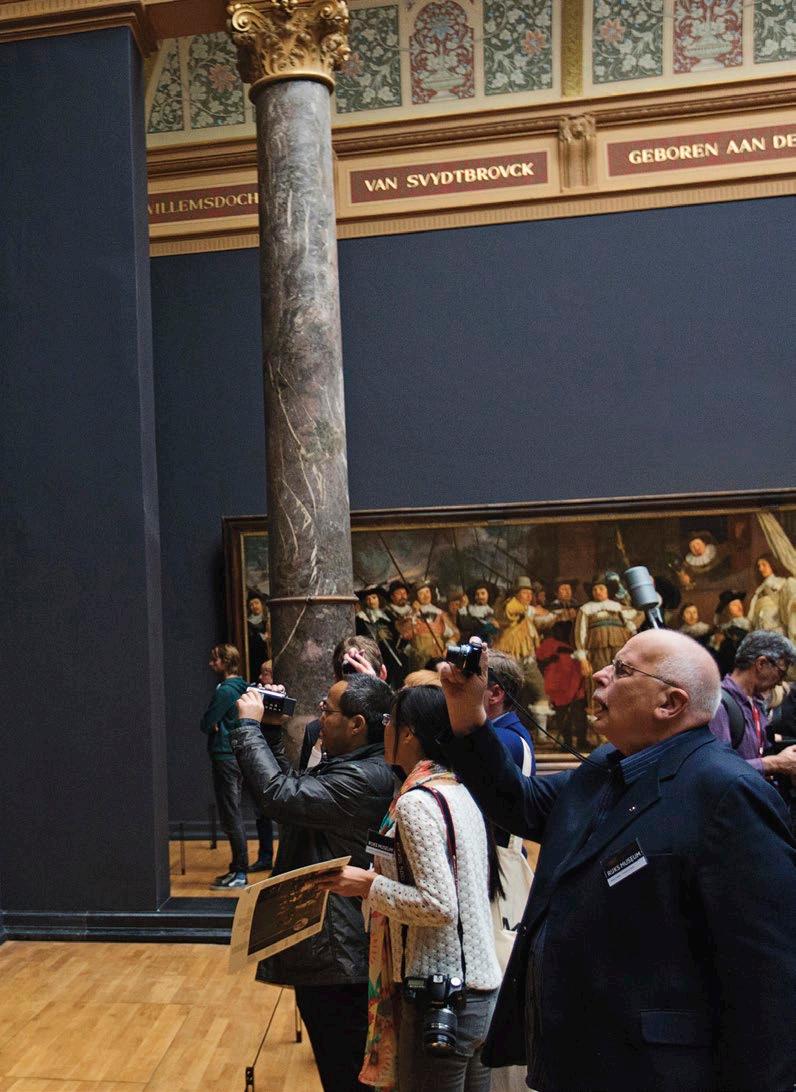 PHOTO: MICHAEL KOOREN/REUTERS
Visitors flock to view Rembrandt’s “The Night Watch” in the museum’s Gallery of Honour
PHOTO: MICHAEL KOOREN/REUTERS
Visitors flock to view Rembrandt’s “The Night Watch” in the museum’s Gallery of Honour
This is The momenT i’ve been waiTing for. After several days of exploring both the public side and behind the scenes of Amsterdam’s Rijksmuseum, I’m about to be ushered into the museum’s holiest of holies by one of its high priests. Gregor Weber, the museum’s head of the department of fine and decorative arts, and an internationally acclaimed expert on both Rembrandt and Vermeer, has agreed to give me a personal tour of the museum’s most famous painting, Rembrandt’s “The Night Watch”.
On the way from his office to the museum’s Gallery of Honour, the ornately decorated room built to show off Rembrandt’s much-admired 1642 masterpiece, Weber reminds me that “The Night Watch” is much more than the museum’s star attraction. “It’s a work of art that encapsulates the Dutch national identity, painted by Holland’s —and the world’s—most famous artist.”
He also tells me it’s wildly popular and warns me to “expect a crowd”.
We enter the museum by a back entrance and climb a winding staircase that leads to the Gallery of Honour on the second floor. Weber was right. There’s a ten-person-deep crowd of several hundred people admiring the massive, 12 x 15-foot painting and filling the gallery with chatter. Some are students and visitors on guided tours; others are plugged into the museum’s audio tours. Art students copy the painting in their sketchbooks. Others stand in awe, admiring the 17thcentury painting. If the Rijksmuseum has a rock star, this is it.
I can see why “The Night Watch” is
considered by many experts to be as majestic as Leonardo da Vinci’s “Mona Lisa” or Michelangelo’s Sistine Chapel ceiling frescoes. A great combination of light, theatre and narrative, it’s a testament to the Dutch-born artist’s skill and evidence of why he’s often called “The Master of Light”, and even “the Shakespeare of painting”.
As I strain to hear Weber over the din of the other museum goers, some of whom are taking selfies with the painting behind them, I ask him if the crowds or noise in the Gallery of Honour ever bother him. He smiles and tells me, “On the contrary, as another curator once said, ‘This isn’t a church.’ We want people to be delighted by what the Rijksmuseum offers.”
It’s a sentiment I hear time and time again as I explore the museum that Taco Dibbits, its director of collections, has said is about “the Dutchness of Dutchness”. Others have referred to it as “Holland’s treasure house” and the nation’s “temple to art”. One writer called it the greatest tribute
| 11•2015 88 treasure house

When the Rijksmuseum opened in 1885, the building wasn’t widely admired— a stark contrast to today, when it receives two and half million visitors a year
to Holland’s past and “the egg that the nation crawled out of”. Going through the museum’s 80 galleries is like taking a journey through eight centuries of Holland’s rich history.
On a tour of the recently renovated museum, I learn that although the museum is popular today, attracting nearly two and a half million visitors a year, it was not so widely admired when it first opened in 1885.
Actually, that’s putting it mildly. “Many thought the original neo-Gothic design by architect Pierre Cuypers was too Catholic and looked too much like a cathedral,” explains museum guide Esther Bruggink as she leads our tour group. Indeed, the Netherlands’ King William III, a Protestant, was so put off by the design, complete with its church-inspired stained-glass windows, that he refused to go to the new museum’s opening. He disparaged it as an “archbishop’s palace”.
“He said he would ‘never set foot in that monastery’,” says Bruggink as she points out the altar-like setting of “The Night Watch”.
As our tour continues, Bruggink pauses in the museum’s Great Hall to say that museum directors throughout the 19th and 20th centuries toned down Cuypers’ designs, such as intricate mosaic tiled floors or walls hung with paintings, by removing them or painting over them. It’s hard to believe the wall decorations (now restored) were once whitewashed over by past museum directors who believed they distracted from the artwork.
“It wasn’t until the recent renovation that much of Cuypers’ original vision and design was restored,” she explains.
That renovation began in 2003. It was expected to take just five years but in the end took ten, at a cost of more than £350m. The comprehensive renovation involved literally stripping the
11•2015 | | 89 PHOTO: s H u TT e R s TO c K
museum down to its original framework, redesigning it, rebuilding it and restoring some 5,000 of the museum’s 8,000 pieces of artwork on display.
“We ran into some problems, both expected and unexpected,” says Igor Santhagens, the museum’s project manager, as we sip strong Dutch coffee in his museum office. Sounding slightly exasperated at the memory, Santhagens explains, “If you dig deeper than a few feet in Amsterdam, you hit water. That complicates matters.”
He turns on his computer and shows me a video of contractors wearing scuba gear and laying a new concrete floor under water—actually some 30 feet below sea level—during the museum’s renovation.
And there was the matter of Amsterdam’s cyclists, who had been merrily biking through a tunnel-like passageway that has cut the museum in two ever since it was first built. When the museum announced it was considering closing it, the cyclists revolted. After very vocal demonstrations, raucous sit-ins and countless letters to the editor, the city’s bicyclists got their way. Plans that restored the bike route were redrawn at huge expense.
ith a couple of million visitors a year traipsing through gallery after gallery of priceless works of art, security is a major concern for Santhagens and other museum staffers. “We tried very hard to make our systems as invisible and as
unobtrusive as possible,” he explains. Cameras, motion detectors, infrared detectors and other high-tech security devices are tucked away, virtually out of sight. Anti-theft Radio Frequency Identification (RFID) tags are hidden in numerous pieces of art.
Because a reported 50 per cent of all thefts take place on an upper floor of a museum, the roof is also protected by a range of security devices. At the nearby Van Gogh Museum, thieves broke into the museum via the roof in 2002 and stole two paintings worth an estimated £20m. (The thieves were captured but the paintings have never been found.)
The most valuable items are placed far from any windows or skylights. The museum’s security staff is well aware that it took thieves only 58 seconds to steal the £40m Cellini Salt Cellar in 2003 from a Vienna museum, which had put it near a window.
Many of the museum’s security guards have been carefully selected based on their ability to detect deviant behaviour in a museum visitor and respond accordingly. Guards trained in this type of “proactive profiling” hope to prevent an attack or theft.
No detail is too small to escape their attention. As I admire Dutch painter Johannes Vermeer’s “The Milkmaid”, I watch as a guard cautions a guest not to point at the painting. Museum guide Sarah Broekhoven tells me, “Someone pointing could be bumped and pushed into a painting, damaging it.”
| 11•2015 90 treasure house
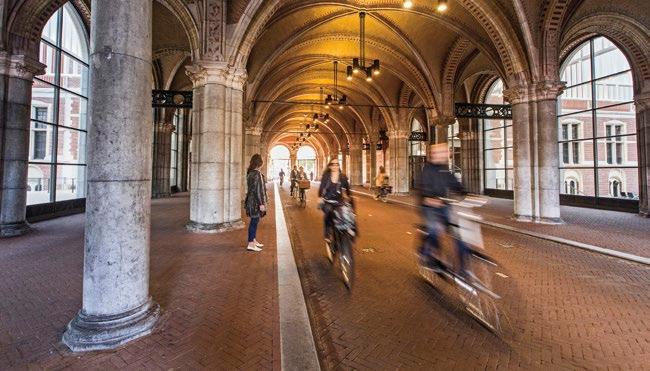
The restored bike tunnel that divides the museum in two is used by thousands of cyclists each day
The Rijksmuseum assigns a rotating shift of two guards to its crown jewel, “The Night Watch”. That’s understandable, given the painting’s importance and the knowledge that it has been vandalised several times in the past.
In 1911 a disgruntled Dutch-navy cook, angry that he’d lost his government job, slashed it with a knife. Then, in 1975, an unemployed schoolteacher made dozens of cuts into the painting before he was wrestled to the ground. It took six months to restore it and some of the cuts can still be seen on it. After a man threw acid on the painting in 1990, guards were able to save it from serious damage by diluting it with water. The acid had only penetrated the outer layer of varnish.
The floor beneath hides a secret door. In the event of fire or other emergency, the painting (and others) can be lowered into the floor and out of the museum to safety by means of a
trap door, dubbed “the Night Watch hatch”. During the Second World War, the massive painting was rolled up and hidden from the Nazis in limestone caves near Maastricht.
fter being ushered through several keyless entry doors in a four-storey office building on the museum grounds, I’m greeted by Paul Van Duin, the Rijksmuseum’s head of furniture conservation in his high-tech studio and conservation laboratory. “Not many outsiders get in here,” says Van Duin as he shows me an elegant, six-foot-tall wooden cabinet made in Holland in 1650 that he and senior conservator Iskander Breebaart are restoring.
As I watch Breebaart painstakingly use cotton swabs dipped in ethanol to clean off layer after layer of centuriesold shellac and varnish from one of the cabinet’s ornate carved figures, Van
11•2015 | | 91
y im A ges
PHOTO: ge TT
Duin explains how technology has transformed the restoration world. “Twenty-five years ago we didn’t have the tools we have today—DNA testing, X-ray fluorescence spectroscopy, gas chromatography—that let us discover exactly what these artists used to build and finish their work.”
Van Duin shows me a picture of his “favourite piece”, a 17th-century Dutch cabinet covered with floral marquetry and built by Dutch furniture maker Jan van Mekeren. “We were able to discover what finishes van Mekeren had used and repair previous badly-done repairs.” The conservation treatment took about a year for Van Duin and his three-person staff. The museum employs almost 50 full-time conservators.
He compares conservation to surgery, explaining how his staff may X-ray a piece to see how it was put together and then carefully peel off a veneer by melting glue so as not to damage it.
“We want to restore the piece to the way the builder envisioned it, but without removing original material,” he says.
“It’s an honour to work with these masterpieces and in many cases restore them to their former glory.”
Technology isn’t the only change that’s affected the world of restoration.
Gregor Weber tells me that when the museum restored one of its most famous paintings, Vermeer’s “Woman in Blue Reading a Letter”, it sought the advice of international experts. “We formed a commission and asked for





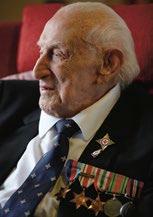







treasure house
recommendations from around the world,” remembers Weber. “A hundred years ago, a restorer typically worked alone and might have made major changes to a painting without consulting anyone because he considered himself the second Vermeer.”
Indeed, an X-ray fluorescence scan recently proved that an overenthusiastic 20th-century Rijksmuseum restorer had added several pearls to Vermeer’s “Woman in Blue Reading a Letter”. After discovering the addition and consulting with his international commission, Weber and his team removed the pearls during the year-long restoration and cleaning, returning the painting to its original state. Says Weber, “Happily, those days are long gone. Restoration is now more scientific, less artistic.”
lthough many visitors tend to rush through the Rijksmuseum to sample its “Greatest Hits”, I had the luxury of spending five days exploring the restored museum and
seeing it through the eyes of its expert staffers. The collection of Rembrandts, Vermeers, van Goghs, Frans Hals and other Dutch masters, as well as thousands of other objects, was thrilling to see. But I also remember the chilly morning I stood in line with one hundred or so other tourists waiting for the museum’s doors to open at 9am.
A violin player stood outside under the museum’s vaulted passageway and unpacked his violin, setting down his case for donations. As hundreds of commuters whizzed by on their bicycles, he began playing Mozart’s “Violin Concerto No 5”. The background noise faded away as the lilting notes echoed throughout the passageway and off the cobblestone walkway. It was a timeless, poignant reminder of how a masterpiece can transport an audience to another time and another place.
The Rijksmuseum has put 500,000 Dutch works of art online. For details, visit rijksmuseum.nl
WH at are YO u a F ra I d OF?
snakes and spiders are common, but some phobias are a little more unusual: Pentheraphobia is the surprisingly common fear of one’s mother-in-law.
Deiphnophobia, meanwhile, is fear of that dreaded social nicety: dinner conversation.
similarly, mageirocophobia is the name given to the fear of cooking.
Feeling weary?
Cathisophobia is the fear of sitting down.
SOURCE: LISTVERSE.COM
11•2015 | | 93
r eader’s dI gest
Times Square, the first stop on the New York tourist trail
BY CATHERINE COLE
My Great Escape: Visiting New York

It was lights, camera, action when Rachael Jones from Cheshire travelled to the famous city for the first time

Catherine has danced in Rio, been microlighting in South Africa and hiked the mountains of Oman
Tell us about your favourite holiday (send a photo too) and if we include it on this page we’ll pay you £50. Go to readersdigest. co.uk/contact-us

YEARS OF WATCHING FRIENDS and films such as Breakfast at Tiffany’s left me yearning to visit the Big Apple, which I finally did in March last year with my husband.
New York was out of this world. The sheer height of the buildings was enough to make you feel miniature—I loved that feeling. It’s the city that never sleeps. Traffic beeps all the time, with thousands of people swarming down every street at all hours of the day.
My husband Richard and I stayed at the Renaissance Hotel on East 57th Street, near to Bloomingdale’s and Tiffany & Co—what more could a girl ask for? In March, it was cold but bright: the perfect combination for sightseeing. We spent ten days exploring and saw everything on the tourist trail, including Brooklyn Bridge, the Statue of Liberty and Times Square.
Our highlights included the ice-white Trump skating rink, which gleamed in the middle of Central Park, juxtaposing the mass of concrete and glass on every side. When it comes to the best view, it has to be from the Empire State Building. You can see for miles—the views are just phenomenal. Bridges
| 11•2015 94 TRAVEL & ADVENTURE
© SHUTTERSTOCK/SEAN PAVONE
and buildings, parks and statues, apartment building after apartment building spread out as far as you can see—getting up high is the best way to get familiar with the city.
Then down on Fifth Avenue, where the mouth-watering smell of freshly cooked bagels pours from every deli door. I’ve learned that the taste of a cream-cheese bagel with smoked salmon is a treat like no other.
Of course, another must-see was Tiffany & Co. Resplendent on the corner of Fifth Avenue and 57th Street, it twinkled in exorbitant glory. Oh, to be Audrey Hepburn for a day…
■ TAKE A BITE OF THE BIG APPLE Return flights to New York start from £277pp with Norwegian Air (033 0828 0854; norwegianair.com).

Postcard From... Mexico City

Views from New York’s buildings are spectacular
FOR A CITY THAT’S BEEN LARGELY IGNORED for so long in favour of Mexico’s glorious beaches, it’s becoming increasingly touristfriendly. Take the time to explore this pulsing centre of culture, tasty food, surrounding Mayan monuments or what many come to see: Frida Kahlo’s famous blue house.
There’s an added reason to visit this month. Mexico city—along with the rest of the country—gets swept up in Day of the Dead madness over November 1–2, where respects are paid to relatives that have passed away. That doesn’t mean it’s a sombre affair, though. Expect to see a lot of painted faces, sugar skulls and flowers strewn over the streets.
■ HOLA MEXICO
Sunvil Holidays offers a 16-night “Essential Mexico” trip from £2,998pp (020 8758 4774; sunvil.co.uk).
11•2015 | 95
Things To Do This Month

CAPE TOWN IN TWO MINUTES
■ DO: THE GREAT OUTDOORS
November in Cape Town heralds the start of summer. It’s the ideal time to enjoy the sunsets from the city’s beautiful beaches (Camps Bay is one of the best), climb Table Mountain or discover the city’s wildlife—notably, penguins on Boulders’ Beach (capetown.travel).
■ STAY: ELLERMAN HOUSE
Recently reopened Ellerman House sits on the coastal fringes of Cape Town, with cosy, luxury interiors and those all-important views out over the crashing Atlantic Ocean (+27 21 430 3200; ellermanhouse.co.za).
■ VISIT: STELLENBOSCH
This quaint town is a short drive north of Cape Town and is the epicentre of the area’s wine region. Make sure you try the pinotage (stellenbosch.travel).
SHORT/ LONG HAUL: ARCHITECTURE HOLIDAYS
LONG: Chicago is one of the world’s most celebrated design cities —with good reason. Its skyline is a compendium of the most important architecture of the 20th century, showcasing everything from art deco to postmodernism.

My America Holiday offers trips from £540pp (0208 003 6081; myamericaholiday.co.uk).
SHORT: The world’s largest outdoor museum, Rome is home to the ancient, crumbling Coliseum, the Forum and many baroque piazzas. Citalia offer trips from £269pp (01293 731 753; citalia.com).

TRAVEL APP OF THE MONTH
Flio, Free, iOs. New app
Flio takes away the hassle of filling in multiple airport WiFi sign-in forms. Enter your details once and it’ll automatically connect you at many airports around the world (getflio.com).

| 11•2015 96 TRAVEL & ADVENTURE
FOR MORE, GO TO READERSDIGEST.CO.UK/TRAVEL-ADVENTURE © CHOOSE CHICAGO
Your guide to getting back out there with Reader’s Digest Dating
Leisure time, long holidays and new hobbies—enjoying the finer things in life is the privilege of being 50-plus. Sharing it all with someone special is even better.
Reader’s Digest Dating can help you get back out there
MAKING A START
Online dating is convenient and straightforward. All our subscribers are over 50, single and looking for companionship. Once your profile is made we’ll suggest people who match your tastes and interests — the rest is up to you!
Chatting to new people can seem challenging at first. Why not join a local club or class? That special
How it works:
someone might not be at the local book club, but mingling will help to build your social confidence.
MAKING A DATE
A great profile picture can be the start of something beautiful! It needn’t be difficult — a recent photograph of yourself in natural light is always the best bet.
All our subscribers can make contact via our messaging service. Taking the time to write to someone is a great way start a conversation. With Reader’s Digest Dating, you can afford to spend a little more time getting to know your admirers!
A first date is best held in an open, public space. Keep it light-hearted and centred on a common interest. You might opt for a coffee in a favourite park or an early show at the theatre. Above all, don’t forget to have fun!
1. Visit www.readersdigestdating.co.uk
2. Create a profile for free
3. Find a match for free
4. Pay an affordable membership fee
5. Start chatting to your match right away!

ADVERTISEMENT FEATURE
Exodus Th E NE x T
Daily acts of anti-Semitism are driving Jews to pull up roots and leave France
By Lisa Fitterman
The first thing you see is the machine gun, casually slung over the shoulder of a soldier. He stands in front of a concrete barrier topped with spikes that hides the entrance to a private Jewish school in Sarcelles, 12 miles north of Paris. On a warm afternoon in April, students stream out of the gate as their parents hover, mothers in long skirts, fathers dressed in black.
“The soldiers are here to protect us,” shrugs seven-year-old Shana Haddad, a petite redhead with a wide smile. But she’s at a loss when asked why. “They just do!” she replies, puzzled.


| 11•2015 98

Her parents talked about the events in Paris earlier this year at a Hyper Cacher kosher supermarket and the offices of Charlie Hebdo —a satirical magazine that lampoons Islam along with other mainstream religions— but kept the details of the slaughter to a minimum. Of course, she never watched the news as police hunted for the gunmen or heard stories about the funerals of the victims—14 civilians and three police officers—in the days that followed.
But her father Laurent Haddad, a burly judo instructor, and his wife Daniella Haddad were transfixed. They know all too well why soldiers have to guard their daughter’s school and patrol synagogues and Jewish community centres. More than half the Jewish families in Villepinte, their working-class town about 12 miles south-east of Sarcelles, have already left. The local synagogue, which has been torched twice, is barely holding on, scrambling each day to gather a minyan—the ten men required to hold prayer services.
Now they are leaving too. Unable to sell, they rented their house and left France with their five offspring, aged two months to seven years, for Haifa in the north of Israel, in early August.
“It’s for the kids’ future,” Laurent, 37, tells me. “The threat of violence here is part of our daily lives.”
The family is part of what’s becoming a trend in France: last year, 7,231 Jews from a population of 475,000
moved to Israel, compared to 3,280 the year before. With mounting antiSemitism and a national unemployment rate that’s been stuck at around ten per cent for the past three years, thousands more are expected to continue the exodus this year and next.
“We don’t expect Israel to be a magic solution to everything,” Laurent says. “But we’re convinced it will be better than what we have now.”
anti-semitism has been in france as long as Jews have been there, from expulsions in the Middle Ages to the collaboration of French police and civil servants in the Nazi round-up of 13,152 Jews, including more than 4,000 children, over two days in 1942.
But in the last 15 years, since the beginning of the second intifada in Gaza, the source of most of it has quickly changed from a nationalist right wing replete with those who deny or downplay the Holocaust to those who confuse their hatred of Israel with Jews in general. Mix in unemployment, abject poverty in suburbs with high immigrant populations and the conversion of those serving time in French jails to extremist Islamist ideologies, and you get a powerful recipe for hatred.
Over the years, the acts have ranged from name-calling and racist flyers to assaults, muggings and the defacement of Jewish graves. In January 2006, Ilan Halimi, a mobile-phone salesman, was kidnapped by a gang because its members thought Jews, being Jews,
| 11•2015 100 the next exodus
Photo S by toma S van houtryve

would have money to pay a ransom; after being tortured for three weeks, he died from his injuries.
In March 2012 the world was horrified when a jihadi killed three children and a father outside a Jewish school in Toulouse because, he said, “Jews kill our brothers and sisters in Palestine,” and it was horrified again this year by the massacres at the Charlie Hebdo offices and Hyper Cacher supermarket.
But for Jews living in certain areas of France, anti-Semitism has become so much a part of their daily lexicon that the world’s knee-jerk vows of “never again” have become devoid of meaning. Like when a Jewish family
just north of Paris was set upon in June 2013 by a group of white men who shouted epithets such as, “Heil Hitler, we should have burned you and finished the job in 1940”—all because a family member asked one of them to respect the 20-mile speed limit as he rode his motorcycle.
Richard Krawczyk, an accounting professor at a lycée in Paris, found himself flat out on the pavement in the city’s 19th arrondissement in March last year, his nose broken, with severe bruising and a swastika scrawled on his body in black ink. The 50-year-old had just left a kosher restaurant after supper with friends and was walking towards the metro. All of a sudden, three
11•2015 | 101
Laurent Haddad with his two-year-old daughter in their home outside Paris before their move to Israel: “It’s for the children’s future”
men were upon him, calling “Dirty Jew! Death to the Jews!” His assailants ran off when they heard sirens. He spent the night in hospital, made a police report and missed a week of work.
“For me, being Jewish is a way of life,” Richard tells me. “I’m married to a Christian woman and our children weren’t raised Jewish. But they all
In response to such acts, Prime Minister Manuel Valls announced in April this year that the government was funnelling £75m to a national anti-racism programme that includes a national awareness campaign, harsher punishments and an increased monitoring of hate speech disseminated online.
Samuels shrugs. If they haven’t
Being Jewish is a way of life. yet when i walk among strangers, PeoPle look at me with hate in their eyes
respect my choices. Yet when I am walking among strangers, people look at me with hate in their eyes.”
’
Im sitting with Shimon Samuels of the Simon Wiesenthal Centre in a cafe next to the Place de la République, where the Marianne statue that towers over the square is draped with a banner that reads “ Je suis Charlie ,” the phrase taken up by much of the western world to show solidarity with those who were slaughtered in January and their survivors.
Samuels is at once disillusioned and realistic. “Would the reaction have been the same if only the Hyper Cacher had been targeted? Charlie Hebdo made it a crime against us all. But can you imagine a banner that says, ‘I am the Hyper Cacher?’ ”
moved outright, many French Jews like himself are hedging their bets, buying property in Israel and even moving their families while continuing to work here. “With flights that last just over four hours between Paris and Tel Aviv, it’s easy to do,” he says.
Still, many Jews are staying. The solution, they say, is not flight but dialogue. Diana Pinto, a prominent historian, cautions against the position that France is bad for Jews. The sheer size of France’s Jewish community may have turned it into a crucible for the rest of the continent but many antiSemitic acts, including extreme ones, occur outside its borders too.
As examples, she quickly points to the killing in May last year of four people at the Jewish Museum in Brussels and a shooting rampage earlier this
| 11•2015 102 the next exodus
year by a Muslim gunman outside a synagogue in Copenhagen, which claimed the life of a young Jewish man and injured two police officers.
“There are certain neighbourhoods you wouldn’t enter as a yarmulkewearing Jew, but the old image of Jews packing suitcases and fleeing a pogrom is plain wrong,” she continues. “The fact is that the majority of Jews, including me, aren’t going anywhere.”
Rabbi Michel Serfaty is an activist based south of Paris in the community of Ris d’Orangis, less than two miles from the high-rise apartment building that was home to the Hyper Cacher gunman. Three civil bodyguards watch over him 24 hours a day, checking bushes, parking lots and cars for suspicious packages or the blink from binoculars or a firearm ready to strike.
Once a professor of linguistics and Jewish studies at the Université de Nancy, Rabbi Serfaty, bearded and grave, believes the solution is reaching out to people in underprivileged communities. When not ministering to his small congregation, he travels throughout France on a “bus of peace” to promote a group he helped found in 2005— L’Amitié Judéo-Musulmane
de France [the Jewish-Muslim Friendship Association]
“When someone says, ‘But you’ll be stoned going there,’ I say that’s a good thing because people will then realise where the work has to be done,” he tells me. “We have to say no to hate and misunderstanding where it will count most.”
Laurent Haddad and his wife Daniella didn’t decide to pack up on the spur of the moment. Should they tear their children from everything that was familiar? Would Laurent be able to learn enough Hebrew to land a good job?
While his wife was born in Israel, he was born in France, and although Jews who move to Israel get immediate citizenship, he’s torn about leaving his parents, siblings and other relatives behind. “It feels like I’m giving up on a place that I love, on my home,” he admits.
But every time he feels a pang of regret, he remembers the grainy images from last January—the four dead Jewish men who tried to stop the jihadi and cowering hostages who hid in a freezer in the basement. He says: “It’s my refrain for goodbye.”
DID YOU KNOW?
yawning and stretching at the same time is called “pandiculating”.
SOURCE: WIKTIONARY.ORG
11•2015 | 103
Rea D e R ’s D I gest










If you want to make sure your hard-earned wealth benefits your children and grandchildren, you need to take action now

Keep It In The Family
3 THREATS TO YOUR FAMILY’S WEALTH:



1 CARE FEES. With the cap on care fees now shelved until at least 2020, it is clear to many that action must be taken to protect family wealth. If you require care and have assets exceeding £23,250, often including the value of your home, you will likely have to fund that care yourself. With the average annual care home bill pushing towards £50,000, it is easy to imagine an inheritance intended to benefit future generations disappearing quickly.
2
LOSS



OF CAPACITY. We rarely get any warning of accidents or illnesses, the likelihood of which increases as life progresses. People often assume that the authority to manage their financial affairs and





make decisions about their medical care and health automatically passes to their next of kin. It doesn’t. Without a Lasting Power of Attorney in place, your next of kin are required to obtain an order from the Court before they can manage your affairs – this is a long, complex and intrusive process.



3 THE MODERN-DAY MARRIAGE.
Some people are concerned that if they leave all their assets to their husband or wife, everything they have worked hard for could pass to someone they’ve never met in the event of their husband or wife remarrying after their death. Others are more concerned about one or more of their children suffering a marital breakdown and the inheritance they leave to their child forming part of a divorce settlement.





ADVERTISEMENT FEATURE





Some would say it is a basic human desire to see the fruits of our labour pass down to future generations –it’s our legacy. But if you don’t take action and plan for the future, you will lose the ability to ensure your












wishes are carried out and your family benefit from your endeavours. Every family is different and there is no “one size fits all” solution, so taking advice from a specialist is a crucial starting point.













WHAT NEXT? Take the first step and request your free information pack by calling Reader’s Digest Legal on 0800 031 9516 and quoting reference “RDL7”




Reader’s Digest Legal is a service provided by the Collective Legal Solutions Group.
Are You Wasting Your Kids’ Inheritance?
Inheritance tax can sometimes mean a big bill—but there are ways of diminishing it while you’re still alive
B Y A N d Y W
EBB

Andy Webb is a money expert at the Money Advice Service. Visit money adviceservice. org.uk for details

Having worked H ard all your life, you should be able to spend your money how you want. Right? Well, your children might have something to say about that.
For many, being retired is a chance to enjoy new-found free time, with travel, home improvement and activities often high on the to-do list. Yet research from finance company SunLife has found one in ten adults think their parents are blowing their inheritance.
Luckily, whether you’re spending it or saving it, there are ways to ensure you can leave more money behind and make sure your loved ones get as much as possible. Here are three ways to reduce the amount of inheritance tax you’ll pay on your estate.
1. Gift some to family and friends
If you’re married or in a civil partnership, anything you choose to leave to your partner is already free from inheritance tax.
For other family members or friends, you can give up to £3,000 in total each year and not pay inheritance tax on the money. You can also give children and grandchildren cash when they get married.
You can give more money and belongings as well, and as long as you live for another seven years, it won’t be counted as part of your estate when you die.
| 11•2015 106 MONEY

2. Leave money to charity
You don’t pay inheritance tax on any money left to charity. If you donate more than ten per cent of your estate, your overall tax bill will be cut from 40 per cent to 36 per cent.
3. Buy life insurance
Sometimes family members are forced to sell property or assets to cover the cost of inheritance tax. In most cases, you can make sure this doesn’t happen by taking out a “whole of life” insurance policy. This means when you die, the insurance payout from the policy goes towards covering the tax bill. However, any gifts given in the last seven years would still be due inheritance tax.
WhAt hAppENs if YOu dON’t lEAvE A Will?
If you don’t have a will when you die, your money, property and possessions will be shared out according to the law instead of your wishes. Dying without a will is called intestacy or dying intestate. The law is different across the UK, but there are some common problems.
■ If you’re not married or in a civil partnership, your partner isn’t legally entitled to anything when you die.
■ If you’re married, your husband or wife will inherit most or all of the money (even if you’re separated) and your children and grandchildren possibly nothing.
■ If you don’t have any living close relatives, your whole estate will go to the government.
11•2015 | 107
© An D y B AK er/Al A my S T oc K Pho T o
Bank Myths Exposed
MYth: YOu cAN’t hAvE MOrE
thAN ONE currENt AccOuNt
Many banks are trying to tempt you to switch to their current account, meaning you’d close your existing one as part of the process. However, you can have as many current accounts across as many different financial institutions as you like.
Why would you want more than one? Well, some bank accounts may

pay you more interest than others— even beating the top savings accounts.
Other accounts offer bonuses such as free travel insurance or cashback on spending.
Bear in mind some incentives are dependent on switching bank, and remember to look beyond short-term offers to make sure the account suits you once the deal is over.
MYth: YOu cAN’t sWitch
BANk AccOuNts if YOu
ArE OvErdrAWN
All banks and building societies now offer a free seven-day current account switch service.
If you do switch your bank account, your balance will be transferred over to your new account—including your overdraft. This is subject to passing a credit check. Remember the overdraft limit you’re offered and fees charged may vary between banks, so do check first.
MYth: YOu NEEd phOtO id
tO OpEN A BANk AccOuNt
By law, all banks must ask you to provide proof of your identity and address. But that doesn’t need to be photo ID— it could be a tenancy agreement with a recent utility bill instead, for example. Talk to the bank you wish to open an account with as they should be able to provide you with a list of alternative documents you can give instead.
Do You Know The True Cost Of Your Cat Or Dog?
If you’re a pet owner, you’ll know they don’t come cheap. But the unexpected costs of owning a cat or dog can add up to more than £5,500.
On top of day-to-day pet spending, dog owners are spending an average of £427 in hidden costs each year, adding up to £5,551 over a lifetime.
Cats cost a little less at £322 a year, or £4,980 in total, according to Co-operative Insurance.
The most common cause of these extra outlays is unforeseen vet bills, with three quarters of pet owners faced with a poorly animal. Special food and boarding kennels/catteries also added unexpected costs to looking after pets. Surprisingly, only one in ten covered these costs through their pet insurance. Four in ten had to take money from their savings, while a quarter used a credit card.
Fortunately, planning ahead can
make sure you’re not chasing your own tail when covering these bills. Factor in all the costs when you’re budgeting. As well as food, what about treats, toys and bedding? Trips to the vet aren’t cheap, and you may have additional costs such as special food or medicine if they get ill. Getting insurance can help protect against big bills, but you’ll need to budget for it too.
You might also need to pay for kennels or a cattery when you go on holiday, or someone to walk your four-legged friend if you’re working late or going out for an evening.

FOR MORE, GO TO rEAdErsdiGEst.cO.uk/MONEY 109
rEA d E r’s d i GE st © S h UTT er ST oc K /J I r I h er A / © y A y m e DIA AS/Al A my S T oc K Pho T o
Avoid The Threat Of Underinsurance

Reader’s Digest Insurance Services provide a range of home insurance policies from leading insurers such as Aviva, Ageas, Axa, Allianz and Legal & General.
To discuss your home insurance and to obtain a competitive quotation, call us today on 0208 069 3102.
IF YOU ARE PAYING TOO LITTLE for your insurance premium you’re at risk of being underinsured.
Say you have an insurance policy that covers £40,000 of household contents, but the actual value of all the items in your home is £80,000. This means you are underinsured by 50 per cent. If you had to make a claim for £30,000 of stolen items after a burglary, you will receive a payment of just 50 per cent of this amount.
Precious metal and diamond prices can change drastically over short periods of time, amplifying the risk of being underinsured. The value of gold has increased by over 20 per cent in the last five years and by more than 200 per cent in the last ten
ADVERTISEMENT FEATURE

years. The popularity of expensive gadgets — such as laptops and tablets — also increase the risk of underinsurance.
Calculating the true value of your contents can be difficult, but it is important to give information that’s
WIN FREE INSURANCE FOR A YEAR!
accurate as possible. Here are three tips to help avoid being underinsured.
TIP 1
Get an up-to-date valuation
If you own precious items, arrange valuations in order to ensure the value specified on your insurance policy is correct and appropriate for their needs.
TIP 2
Make sure the valuation contains detailed information
It’s important to have a professional valuation, so there is no confusion in the event of a claim. A valuation stating “A Solitaire diamond ring: £20,000” is ineffective. There are no indications of carat weight or grading, details of the mount or whether the ring is antique or modern. This level of information is vital when seeking a replacement.
TIP 3
Make sure your home insurance policy matches your needs
Ensure your home insurance policy adequately covers the value of your contents, so your possessions are properly protected.
Reader’s Digest Insurance Services is giving away a year’s worth of FREE home insurance! For a chance to win, all you have to do is pick the top three activities on your bucket list. To enter this great competition, visit www.readersdigest.co.uk/bucket-list-comp
Easy-to-prepare meals and accompanying drinks
Mushroom, Thyme & Pancetta Risotto
BY RACHEL WALKER

Rachel is a food writer and blogs at thefoodieat.org
Serves 8
A RISOTTO REQUIRES PATIENCE. It’s a relaxed dish that’s best cooked with a wooden spoon in one hand and a glass of wine in the other. I’ve never made one in less than 45 minutes, but then that’s part of the joy. When the temperature drops and nights close in, the cosy spot by the oven can become a contested place in the kitchen—and a bit of gentle stirring guarantees prime position.
I’ve recommended chestnut mushrooms because they’re readily available and have a lovely nutty flavour. If your local shop has a broad range, then there’s no need to be restrained—oyster, portabello, shiitake and button mushrooms would all make welcome additions.
• 180g pancetta cubes/bacon lardons
• 1–2tbsps olive oil
• 1 onion, finely chopped
• 3 cloves garlic, crushed
• 500g chestnut mushrooms, sliced
• 400g rice (arborio or carnaroli)
• 4 sprigs of thyme
• 125ml white wine
• 1.2–4l chicken stock
• 75g Parmesan cheese, grated
• 50g unsalted butter, diced
• Season: salt, pepper
1. Heat a large, heavy-based saucepan and start cooking the pancetta cubes.
2. When the fat begins to render, add the onion and olive oil, and stir with a wooden spoon so the onions are coated and gleaming. Cook on a medium heat for 10 minutes, until
FOOD & DRINK | 11•2015 112
PHOTOGRAPHY BY TIM &
HILL
ZOË

the onions turn translucent (stop before they colour).
3. Next, add the garlic and cook for 1 minute, then add the mushrooms and thyme. As the mushrooms cook, they release moisture and will stop the garlic or onion from burning.
4. After 5 minutes the mushrooms will have shrunk and darkened in colour. Now turn up the heat and add rice to the pan, stirring until the grains become hot and thoroughly coated in the mixture in the pan—but not so long that they start to colour or cook.
5. Add the wine. It should sizzle as it hits the hot pan. Stir until it’s all been absorbed. Add 500ml of the stock,
and let it cook at a rolling simmer, stirring from time to time. Once it’s been absorbed, add another 500ml.
6. The final 400ml of stock might not all need to be added. Add it bit by bit, stirring and tasting as you go, until the rice has developed a creamy consistency but the grains of rice still have a bit of a bite to them.
7. Add the Parmesan and butter, and stir vigorously so the risotto takes on a glossy sheen.
8. Taste and season if necessary. Note that pancetta and Parmesan are both salty, as is stock, so don’t be too liberal with the salt. A splash of truffle oil makes a luxuriant addition.
11•2015 | | 113
Red But Not Hot
MUSHROOMS ARE AN EASY ingredient to pair with wine because their savoury “umami” flavour is quick to flatter, with their earthiness going particularly well with a Pinot Noir or Barolo.
Make the most of a red by decanting it. Also, resist the temptation of overheating red wine. When the French term chambré was invented, meaning “the room” to describe the ideal drinking temperature of red wine, French dining rooms wouldn’t have been much warmer than 15C. Now the average thermostat in British households is set to 23C.
A young, light and slightly tannic red should be drunk towards the cooler end of the scale (14–15C). Fuller-bodied, more matured reds are at their best round 18C. Either way, make sure you save the mulled wine for heating, and keep the rest



of your red at a medieval rather than modern “room temperature”.
RACHEL RECOMMENDS...
■ Barolo, Piedmont, Lidl, £9.99
It’s very unusual to find a Barolo under £10, making this a great value bottle from Lidl.
■ Pinot Noir Jacques Dépagneux, The Wine Society, £5.75
A smooth wine, which elegantly partners a mushroom risotto.
■ AVB Beaujolais, Morrisons, £4.99
An award-winning Beaujolais, best drunk slightly chilled.
■ Steelite craft brown decanter, Perfect Setting, £21
No need for cut-glass heirlooms— this traditional decanter is more versatile and just as effective.
■ Wine thermometer, Barrels and Bottles, £20.42
Take away the guesswork with a wine thermometer.
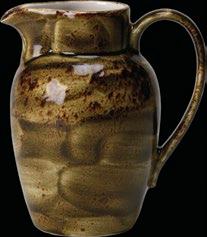

| 11•2015 114 FOOD & DRINK
Pudding of the Month

Buttermilk Panna Cotta
Serves 4
• 180ml double cream
• 40g sugar
• 1.5 gelatine sheets
• 180ml buttermilk
1. Submerge the gelatine sheet in cold water.
2. Meanwhile, heat the double cream and sugar in a pan, bringing it up to near-simmering point until the sugar has dissolved.
3. After 5 minutes in cold water, the gelatine should have turned squidgy and slippery. Squeeze out any excess water and stir it in with the still-warm double cream and sugar until it has dissolved.
3. Now add the buttermilk. Stir so everything is combined and divide between four ramekins.
4. Allow at least four hours for it to set in the fridge (ideally more time if you can allow it).
5. Serve in ramekins.

The Essentials of Classic Italian Cooking by Marcella Hazan, £20.40. Cult cookbook, crammed with Italian classics.
BUDGET

Cooks’ Ingredients
Carnaroli Risotto Rice, £1.48, Ocado. This is a bargain for risotto rice.
BLOW-OUT

Taste of Italy Monthly Food Box, from £34.99 per month, Vallebona. Italian treats delivered to your door.
READER’S DIGEST 11•2015 | | 115
FOR MORE, GO TO READERSDIGEST.CO.UK/FOOD-DRINK
BOOK
© VIKTOR FISCHER/ALAMY STOCK PHOTO
By Lynda C L ark

Lynda Clark is a homes, property and interiors expert, and is editor of First Time Buyer magazine
Highland Fling
TradiTional TarTan is iconic and will never go out of fashion. This season, why not team modern plaids and bright checks to create a stylish interpretation of a truly timeless look?
Perfect for any setting, the latest designs have been updated with a fresh colour palette. From classic highland tartan in blues, greens and reds to pretty blanket weaves in pretty pastel shades, this heritage fabric renews our love affair with traditional craftsmanship and ever-popular natural fabrics.
Sheep cushion, £15; White staghead wall plaque, £89; Shepperton chair, £499; Sheepskin rug, £79; B&O Play by Bang and Olufsen speaker, £399.
■ all available from Very (very.co.uk)
Get The Look
Add some Scottish spirit to your home with these understated pieces.
■ Winterberry check throw, £79, Marks & Spencer (marksandspencer.com).
■ Tartan table lamp, £245, Alexander & Pearl (alexanderandpearl.co.uk).
■ Edderton soft cube, £39, Very (very.co.uk).



home & Garden
| 11•2015 116


WILd aBouT FLoWers
Judith Blacklock is the author of 13 best-selling books and runs the highly regarded Judith Blacklock Flower School in central London.
Her new book Contemporary Floral Design is a real must-have for anyone who loves cut flowers. She includes practical, easy-to-understand descriptions to help you achieve both classic and innovative designs, along with 350 stunning floral images to inspire your creativity.
■ Contemporary Floral Design (The Flower Press, £35) is distributed by Gardners Books. For details, call 01323 521 777.
CLeVer CreaTIons
o nce you have these nifty products, you’ll wonder how you ever managed without

Garden Glove, £14.97 (houseofbath.co.uk).
Microwave these gloves briefly and you’ll enjoy an hour’s warmth while digging and planting.


cast iron s quirrel
Boot Brush, £20 (berryred.co.uk).
Sturdy and compact, this cast-iron squirrel will clean the muddiest of garden boots.
11•2015 | 117
FOR MORE, GO TO readersdIGesT.Co.uk/home-Garden
© O L iver G O rd O n
Planting A Spy In Your House
By olly mann

Olly is a technology expert, LBC presenter and Answer Me
This! podcaster
nest Cam, £159
Available for the first time in Europe, Google’s home-security camera live streams images to your mobile or computer, wherever you are. So check in to see how much food Fido has eaten, whether the babysitter is still awake, or just to watch out for your valuables. The footage is full high-definition (1080p), with motion alerts and night vision, and—if you pay a subscription— you can review up to 30 days of content online. The mounts are magnetic, so I placed a cam on my fridge door to monitor exactly who ate all the pies. It turned out to be me.


apple app of the month: notes, free Apple’s iOS 9 operating system (available as a free update on newer Apple mobile devices) includes a Notes redesign that’s most welcome. Previously

a place where shopping lists would mingle unhelpfully with your creative thoughts and financial planning, Notes now sorts thoughts into folders, can attach photo and video, and offers new formats such as checklists.
| 11•2015 118 Technology
© Martyn Landi/P a iM ages
apple ipad pro, priCe tBC
You’ve got to feel for Microsoft’s hardware team. Their Surface Pro 3—a tablet-laptop crossover pitched at business users—was their only notable success. But Apple have just parked a 12.9-inch tank on their flexible-working lawn. The iPad Pro’s 5.6m pixel Retina display delivers exceptional entertainment, while the optional keyboard and nifty stylus (“Apple Pencil”) adds productivity: ergo, one less reason to choose the Surface over an iPad when you want to work on the move. Ironically, it’s Microsoft’s own Office apps for iPad that make it such a convincing alternative.
intel selfie stiCk, prototype


The “Selfie Stick” is the most ubiquitous yet most hated gadget of the year—on sale wherever tourists congregate, they’re banned from Disney World and derided as “the staff of Narcissus”. There’s no patent, so now Intel have created their own version—a monopod mounted by no less than six GoPro Hero 4 cameras, capable of taking, wait for it…the world’s very first 4K 360-degree selfie! This isn’t commercially available, but by tapping into the trends for both virtual reality and digital egomania, it’s surely a taste of things to come.

android app of the month:
Quiz tix: BBC Comedy Genius, free
If you know your Basil from your Sybil, can recall which actor links Have I Got News For You with One Foot in the Grave, and generally spend more time watching Gold than you’d care to admit, this is the trivia game for you. But if, like me, you can answer the questions with alarming ease, it does move a little slowly.

11•2015 | 119
FOR MORE, GO TO readersdiGest.Co.uk/teChnoloGy
BY GEORGINA YATES

Georgina is a fashion and beauty editor for numerous travel titles and a blogger at withgeorgia.com
The Art Of Movement
“I FIND OLD BITS OF MACHINERY AND MECHANISMS REALLY FASCINATING,” says designer Sophie Stamp of her inspiration behind her stunning kinetic jewellery range. “I like to open up the casings or take things apart and figure out how they work. There are all these beautiful components and elegant shapes, and they’re just hidden away.”
Casting nuts, bolts and cogs in precious metal, Sophie’s pieces are current yet imbued with a vintage style, making them truly unique and very striking.

“I’m a real fidget and I have this habit of playing with my jewellery, spinning
Crème Caramel
Caramel, camel, deep beige…the muted tone is at the fore this month.
■ Invest in a lovely alternative to a black winter coat (£65; topshop.com).
■ Treat yourself to a cashmere cardigan (£139; marksandspencer.com).
■ Keep the chill out with this soft scarf in camel (£19.99; zara.com).



| 11•2015 120
FASHION & BEAUTY
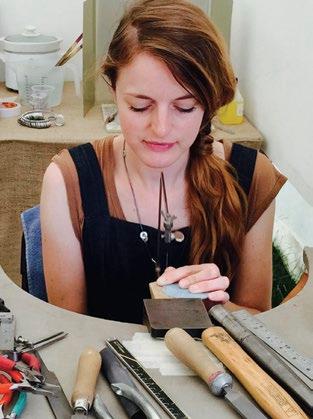
my ring around on my finger and running my little locket up and down along its chain. All the better for me if the jewellery is designed for this purpose!” There is, therefore, a wonderfully tactile quality to Sophie’s pieces: they encourage the wearer to play with the mechanism.
Sophie is continuing to expand her jewellery business, one facet of which is a training school that takes place in her studio, along with a fellow silversmith. “We’ve just started running ring-making workshops.

I have some great mentors who’ve taught me so much. It’s nice to give something back.”
■ Visit sophiestamp. co.uk for details
FAMILIAR STEPS
Traditional shoe styles are firmly back in fashion. Reinvented in innovative colours, prints and materials, these classic designs are given a new lease of life.

Originating in Ireland, the brogue was previously considered a man’s shoe that was worn for country walking. Now the tables have turned and the design has become truly unisex (Brogues, £59; marksandspencer.com).

The Mary Jane design has been around since the 1500s, but it was in 1902 when it was coined “Mary Jane” after the character from Richard Felton Outcault’s popular comic strip Buster Brown. Initially a flat shoe, during the 1990s a chunky heel was added (Mary Jane Court Shoes, £36; next.co.uk).
“Don’t step on my blue suede shoes!” The 1956 rockabilly hit made “blue suede shoes” iconic— it’s no wonder they’ve made a return (Boots £39; laredoute. co.uk).

11•2015 | | 121
Going Coconuts

VIRGIN-PRESSED COCONUT OIL has enjoyed a recent renaissance. Aside from being a healthier alternative to olive oil, it’s also touted as the miracle natural beauty product of the moment. With just one jar of extra virgin coconut oil (£5.99; tesco. com) you can adopt a healthier diet, cure split ends, cleanse away daily grime and achieve a closer shave.
1. Coconut oil is comprised of smaller chain fatty acids, which means it’s able to penetrate the hair more quickly and effectively than other natural oils. You can take it straight from the jar and massage a dollop into damp hair, or you can heat the oil so it becomes runny and apply it to clean, dry hair in the same way. For super
silky locks, wrap hair in a towel and leave the oil in overnight.
2. Oil-based cleansers remove daily grime and wax-based make-up products, such as mascara, much more effectively than water-based products. It’s best to use a natural product around the delicate eye area to avoid irritation.

3. Coconut oil is a natural alternative to chemicalladen shaving balms. Its moisturising properties hydrate your skin as you shave, leaving your legs feeling soft and smooth.
REFRESHING SCENTS
Dr Hauschka’s range of vegan deodorants (£12.25; dr.hauschka.com) provides an animal-friendly, natural substitute to synthetic sprays. The collection features two delicate fragrances of rose and sage and mint. These are sourced from natural oils, which means that the product stays on the skin much longer than your average spray or roll on—keeping you smelling fresh and feeling moisturised throughout the day.

FASHION & BEAUTY | 11•2015 122 FOR MORE, GO TO READERSDIGEST.CO.UK/FASHION-BEAUTY
BOOKSHOP
WHAT ARE YOU READING NEXT?


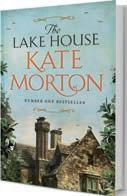











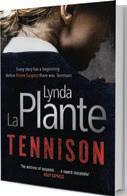









For more books at bargain prices, look for the 8-page insert accompanying the magazine or visit shop.readersdigest.co.uk/books and browse through our shelves.
HOW TO ORDER
(Please quote RDP033 when ordering)
Online: shop.readersdigest.co.uk Phone: 0844 332 8080 (8am-8pm Mon-Fri, 9am-5pm Sat-Sun) By Post: Reader’s Digest, FREEPOST , RTHR-LLRY-ZHYS, Ringwood, BH24 1HD (Cheques should be payable to Reader’s Digest, and please remember to quote RDP033 * plus £1.99 postage and packing per order

UP TO 40% OFF RRP
£18.99
£11.99*
£20.00
£11.99*
B11314
£20.99 £15.99*
B11325
B10773
£18.99 £10.99*
£7.99
£6.99*
B10782
B11403
B11404
£7.99
£6.99*
Lose yourself in conspiracy theories and guilty pleasures with the latest literary offerings from two big names
November Fiction
James writes and presents the BBC Radio 4 literary quiz The Write Stuff b y J AME s WA lT o N
Numero Zero by Umberto Eco (Harvill Secker, £16.99)

Ever since The Name of the Rose conquered the world in the 1980s, every new Umberto Eco novel has been a fully-fledged literary event—without any quite matching the sustained brilliance of that debut. In truth, Numero Zero doesn’t either. Even so, there’s still plenty to enjoy and at an unusually slim 200 pages, it’s also a pretty effortless way for new Eco readers to see what all the fuss is about.

The latest book, like many of its predecessors, is based around a conspiracy theory—in this case, rather a good one: that Mussolini didn’t die in 1945. Instead, that famously disfigured corpse belonged to somebody else, while Il Duce himself was smuggled to Argentina. (In Eco’s hands, this becomes surprisingly convincing.) What follows, again not for the first time, is a combination of a conventional thriller and a whole lot of other stuff that Eco wants us to know about. Not all the tangents he goes off on—sports-car specifications, fraudulent orders of chivalry—are as rewarding as he seems to think. Nonetheless, where the book is at its considerable
NAME THE AUTHoR
(Answer on p128)
Can you guess the writer from these clues (and, of course, the fewer you need the better)?
1. In 1993, he was played on screen by Anthony Hopkins.
2. His famous books feature siblings Peter, Susan, Edmund and Lucy.
3. His first names were Clive Staples.
| 11•2015 124
books
best is its angry and persuasive depiction of the essential rottenness of post-war Italian politics.

The St Tropez Lonely Hearts Club
by Joan Collins (Constable, £16.99)
If after Eco you fancy more of a guilty pleasure, Joan Collins should fit the bill nicely. Her latest novel features a poor but gorgeous Argentine girl being wooed by a handsome playboy, whose full psychopathic cruelty is revealed once they’re married—with her years of misery ending only when he dies in a bizarre sex-related accident. And that’s just the first 25 pages. After that, things take a turn for the actionpacked, as a large cast of rich and/ or beautiful characters party their way through summer in the South of France. The only trouble is that they also seem to be the targets for a serial killer...
The result, needless to say, is shamelessly over-the-top. Yet, at 82, Dame Joan remains such a force of nature that asking her to tone it down a bit would be like asking a hurricane to blow more gently. She also has a fair amount of teasing fun at what seems to be her own expense—one character, for example, is an elderly former starlet who needs three hours with her “glam squad” before appearing in public.
pApERbAcks
■ Moriarty by Anthony Horowitz (orion, £7.99).
Horowitz’s second trip into Conan Doyle territory is oddly a Holmes novel without Holmes.
Odder still, it works beautifully.
■ Britain’s Best Political Cartoons: 2015 edited by Tim benson (Random House, £12.99). Latest in the series that provides a reliably fun way to remember the year. Let’s face it, the perfect book for any loo.
■ Shadow Spell by Norah Roberts (piatkus, £7.99).
Second novel in the Cousins O’Dwyer trilogy from the woman whose books sell at a global rate of 34 a minute.
■ The Death House by sarah pinborough (Gollancz, £7.99).
Proper scary read for older teenagers, complete with a great final twist.
■ Going Off Alarming by Danny baker (phoenix, £7.99). The second volume of Baker’s autobiography covers “the television years” with all his usual wit and wry anecdotes.

11•2015 | | 125
RD’s REcoMMENDED READ
We all have a favourite anecdote about our hometown—author Mark Mason traversed the country to discover every silly story
Tales Of Local Trivia
Mark Mason has the knack of turning his love for obscure but arresting facts into proper joined-up books. Now, having already written about walking the entire London Underground route at street level, and about travelling from Land’s End to John O’Groats by local buses, he’s set himself a new challenge: to find one killer fact—or, as he admits, piece of trivia—about every one of the UK’s 124 postcodes.
It’s a project that allows for plenty of breezy but sharp travelogue about modern Britain. (When he buys a road atlas at Watford Gap services, the assistant duly asks, “Would you like a chocolate bar with that?”) He also throws in lots about the Post Office—including the tragicomic news that in 1978 a stamp was printed and ready to go, celebrating Scotland’s World Cup win that year. We learn that telephone boxes were designed

Mail Obsession: A Journey Round Britain by Postcode by Mark Mason is published by Weidenfeld & Nicolson at £12.99.

to be tall enough for a man wearing a top hat—and, less charmingly, that they soon had to be made with sloping floors because people were already using them as urinals.
Despite these recurring themes, it can’t be denied that the book’s structure remains fairly random,
| 11•2015 126
BOOKS
with Mason never trying too hard to hide his real aim—to tell us more or less anything he thinks we’ll find interesting. Luckily, he’s nearly always right. Almost every page contains at least one thing that you’ll be itching to startle your friends with.
We join him here as he’s pondering what his killer fact might be about postcode NN, for Northampton…
There’s Borough Hill in Daventry, from where the BBC’s Empire Service used to be broadcast. The announcement ‘Daventry calling’ was the reason the literal pronunciation became the accepted one—before that people said ‘Daintree’. There’s Corby, which although it didn’t invent the trouser press (that was done in Windsor by someone called Corby), has a crater on Mars named after it. This is in tribute to a conversation between Apollo 11 and mission control, who relayed Neil, Buzz and Mike items of news to help them feel bonded to their home planet. ‘In Corby,’ went one story, ‘an Irishman named John Coil won the World’s Porridge Eating Championship by consuming 23 bowls in ten minutes.’
siX oF MARk MAsoN’s posTcoDE FAcTs
Wr (Worcester): The village of Bricklehampton has the longest place name in Britain not to repeat any of its letters.
sW (London s outh West): Some of the TV cables at Buckingham Palace for the 1981 wedding of Prince Charles and Lady Diana Spencer were installed by a ferret.
G (Glasgow): The Royal Marines at Faslane Naval Base repel midges by wearing Avon’s “Skin So Soft” body lotion.
sP (salisbury): The famous 1973 “schoolboy pushing his bike up a steep Northern hill” Hovis advert was actually filmed in Shaftesbury in Dorset.
nP (newport): Charles Rolls [who lived near Monmouth], the partner of Henry Royce, was the first British person killed in an aeroplane accident.
Pe (Peterborough): The boundary between Lincolnshire and Northamptonshire is, at 19 metres, the shortest county boundary in England. ‘‘
Then there’s the country’s first ever arrest following a car chase. Sergeant Hector Macleod was our man behind the wheel in 1899, when he caught a Benz driven by a wanted criminal. The heady speed of 15mph was reached, though my favourite
11•2015 | 127 R EADER ’s Di GE s T
detail is the crime for which the man was wanted: selling counterfeit circus tickets.
Much of the material I unearth comes, like Macleod, from the Victorian era. Whenever you read about this period you come away feeling that Britain crammed more into those 64 years than we’ve managed in the rest of our history put together. It’s the inventions that always get you: there were so many of the things. Take Hiram Maxim.
creditable thing to invent a killing machine, and nothing less than a disgrace to invent an apparatus to prevent human suffering.’
But the award for greatest concentration of inventive talent per square yard surely goes to the Nottingham pitch that played host to a game of football in January 1891. This event, which makes a strong early claim to be my NG fact, is recorded as the first ever game to use goal nets. They were the recent
What I really love about the story is that it’s an example of how your assumptions can be challenged
He’s most famous as the inventor of the machine gun, but he also held patents on a mousetrap, hair curlers and an automatic fire-sprinkler that didn’t just douse the flames, it alerted the nearest fire station too. One of Maxim’s other brainwaves was a steam inhaler for bronchitis sufferers called the Pipe of Peace. Criticised for pandering to ‘quackery’, Maxim replied: ‘It will be seen that it is a very

AND THE NAME oF
THE AUTHoR is…
C S Lewis. (Anthony Hopkins played him in Shadowlands, and those famous siblings are the children in The Chronicles of Narnia.)
creation of John Alexander Brodie, a civil engineer from Liverpool. Despite being responsible for the Mersey Tunnel and the initial planning of New Delhi, Brodie said the goal net was the invention of which he remained most proud. What I really love about the story is that it’s an example of how your assumptions can be challenged. The reason nets were needed is simple: to stop people having to run miles to retrieve the ball, right? Wrong. It was because there had been frequent arguments about whether the ball had passed inside or outside the post. The reason for the ‘greatest concentration’ title, meanwhile, is that the match referee was Sam Widdowson— inventor of the shin-pad.
| 11•2015 128 BOOKS
’’
© K E y S t O n E P IC tur ES u SA/A LAM y St OCK P HO t O
Books THAT CHANGED MY LIFE

Annie Nightingale, MBE, was Radio 1’s first female DJ and is celebrating five decades in broadcasting. At 75, she’s still championing new music and has recently curated an album for the Ministry of Sound’s “Masterpiece” series.
The Princess and the Goblin
BY GEORGE MACDONALD
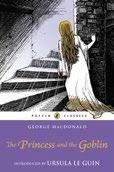
This classic was my mother’s favourite. She read it to me when I was about five and it became my first favourite book. I was enchanted by the stark, scary, black-and-white illustrations and I identified with the gutsy princess—an only child like me. It’s about bravery and loyalty, and it’s full of symbolism. When I was waiting to film an eclipse on a mountain in Chile, it took me back to Princess Irene waiting for her great-great-grandmother to appear in the moonlight.
You’ll Never Eat Lunch in This Town Again
BY JULIA PHILLIPS
This is the hairraising, hilarious autobiography by Julia Phillips, the first female producer to win an Oscar,
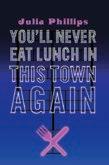
for The Sting in 1974. She had a very wild life, hanging out with Hollywood movie stars. I’ve read it so many times, the pages have almost fallen out. It shows how hard it is for a woman to be taken seriously in an all-male industry, and that chimed with me. I’d have loved to meet her, but she died young. (Maybe we wouldn’t have got on; she could be very scathing.) I’m hoping to make a documentary about her with Radio 4.
Lean In
BY SHERYL SANDBERG
This is another book by an amazing woman who broke through the glass ceiling. The author is chief operating officer at Facebook, and I empathised with her descriptions of her failures and struggles to get to the top in a very aggressive, male world. Her message is to believe in yourself and give it your all. As told to Amanda Riley-Jones
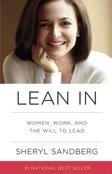
11•2015 | 129 © FEATUREFLASH/SHUTTERSTOCK
FOR MORE, GO TO READERSDIGEST.CO.UK/BOOKS
You Couldn’t Make It Up
Win £50 for your true, funny stories! Go to readersdigest. co.uk/contact-us or facebook.com/readersdigestuk
IT WAS TEA TIME during the second test at Lord’s. I was delighted to see the people in one of the sponsors’ stands were giving out tasty strawberries and freshly brewed cups of tea. What’s more, next to the stand stood a group of smartly dressed youngsters with several trays of delicious-looking mini rolls. Hungry, I asked, “What’s in the rolls?”
“Smoked salmon and cucumber,” came the reply.
I took one and wandered off, happily eating it. It was only after that I realised they were not part of the sponsor’s stand at all—I’d eaten the tea of a private group!
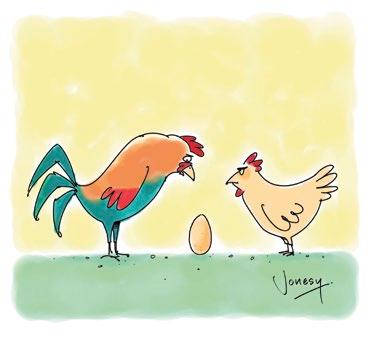
“But it looks nothing like me!”
laugh when she said, “You’d think with all that room in there, he would have gone round the other turtle.”
CHRIS CUDLIPP, Weston-super-Mare
I WENT TO CHESTER ZOO with my two nieces Emily and Laura (both six years old). We came to an enclosure with two turtles in, and one was obviously partially on top of the other.
I was hoping there would be no awkward questions. Thankfully there weren’t, but one niece made me
DANIELLA ROBERTS, Clwyd
I WAS SITTING ON A BENCH in the middle of Sauchiehall Street in Glasgow, watching the world go by, when an elderly woman sat down beside me. Glasgow people are very friendly and she immediately struck up a conversation.
“Are you a student?” she asked.
FUN & GAMES | 11•2015 130
A little astonished (I was in my late fifties at the time), I said that I wasn’t, but was flattered she should think so.
“Oh well,” she said. “My eyesight isn’t what it used to be. Last week I flagged down a bus, then realised it was a fire engine!”
SYLVIA THOMSON, Fife
MY SISTER WAS PREPARING PANCAKES
for her sons Jason and Robbie. My nephews began to argue over who would get the first pancake.
My sister saw the opportunity for a moral lesson. “If Jesus were sitting here,” she said, “He would say, ‘Let my brother have the first pancake. I can wait.’ ”
Robbie turned to his younger brother and said, “Jason, YOU be Jesus.”
JAKE COOPER, London
MY YOUNGEST DAUGHTER was in her bedroom and I heard her shout, “Ouch! I’ve just bumped my toe.”
“Which toe?” I called to her.
“The one that ate roast beef!” came the reply.
STEVE HUGHES, Hertfordshire
SITTING ABOARD my first flight overseas, I was revelling in the experience. A Zimbabwean by birth, even going to South Africa was a treat, never mind America.
Applying my knowledge of South African holidays to this one, I politely asked the attentive air host for an Appletiser. To my surprise, a little packet of pretzels was promptly
delivered. My family and I eyed the bag curiously before I decided to take advantage of the gift, while again asking for an Appletiser to go with the pretzels. A bemused host arrived with another pretzel packet.
This happened four times until my brother leaned over—a broad grin on his face—and said, “Stop asking for appetisers; just ask for Coke.”
KC LEMMER, Surrey
WHILE WORKING IN THE GARDEN, I heard the telephone ring. Before I could answer it, my granddaughter shouted, “I’ll get it, Grandad!”
A few minutes later she called, “It’s for you, Grandad. Someone called the Scottish Weirdos?”
BARRIE MARKLEW, Yorkshire
ON A FIELD TRIP to a local police station, the children were looking at photos of all the people that were wanted for various crimes.
The police officer giving the tour asked if there were any questions. One child piped up, “If these people are all wanted, why didn’t you just keep them when you were taking their photos?”
HOPE LEWIS,
Liverpool
MY FIVE-YEAR-OLD GRANDSON was watching my husband eat a multi-grain roll. Very seriously, he said, “Grandad, if you pick one of the seeds off of the top and plant it in the garden, you can grow some more rolls.”
JULIE MEPSTEAD, Ashford
READER’S DIGEST 11•2015 | 131
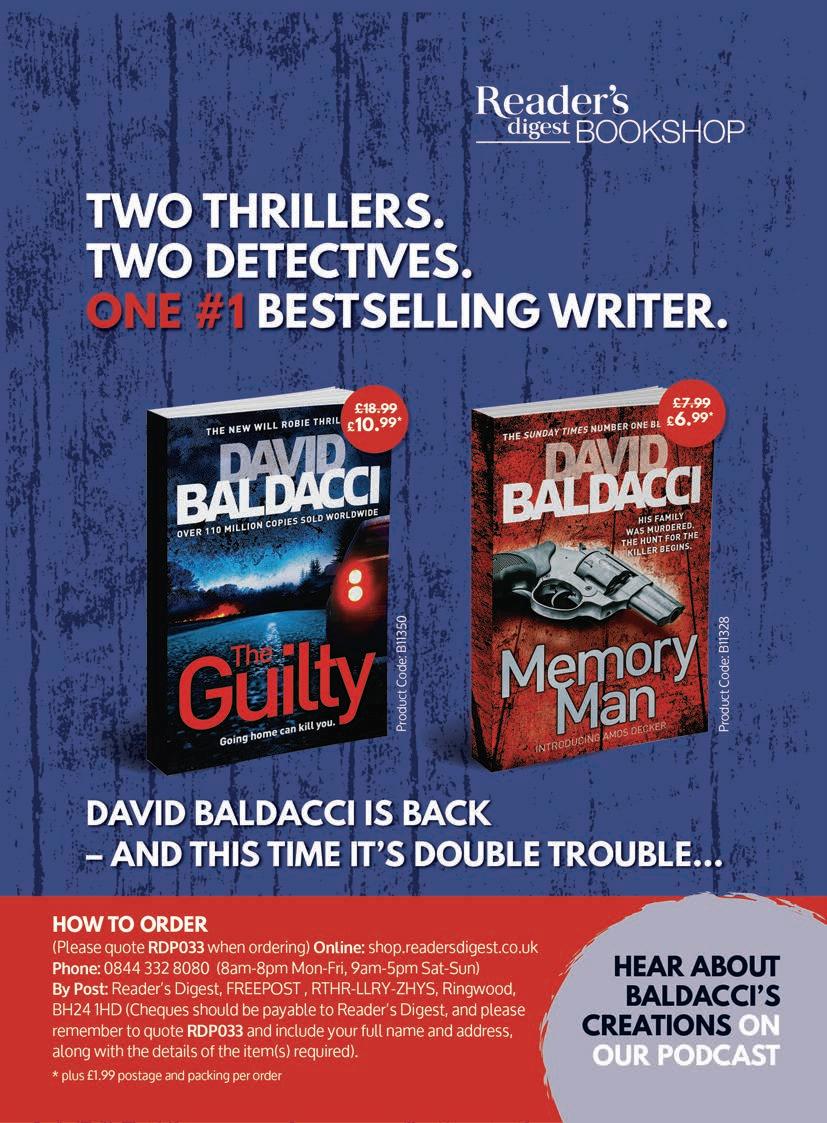
IT PAYS TO INCREASE YOUR
Word Power
Shakespeare’s princely Hamlet is the character who mopes about muttering, “Words, words, words.” Here, from the venerable play by the Bard, are some words (in their root form) you can actively employ today. If, tragically, you need answers, consult the next page.
BY EMILY COX & HENRY RATHVON
1. impetuous (im-‘peh-choo-us) adj—A: full of questions. B: rash. C: scheming.
2. traduce (truh-‘doos) v
A: shame using lies. B: parry with a sword. C: exchange for a profit.
3. germane (jer-‘mayn) adj
A: poisonous. B: relevant. C: ghostly.
4. incorporeal (in-kor-‘por-ee-uhl) adj—A: using military might. B: full of tiny holes. C: having no body.
5. wax (‘waks) v—A: grow smaller. B: grow larger. C: grow a moustache.
6. paragon (‘par-uh-gone) n
A: mounted soldier. B: five-sided figure. C: example of excellence.
7. calumny (‘ka-luhm-nee) n
A: row of pillars. B: disaster.
C: character attack.
8. beguile (bih-‘giyl) v
A: bond or form a union. B: deceive. C: leave stranded.
9. whet (‘wet) v—A: sharpen or stimulate. B: moisten. C: hasten.
10. rub (‘ruhb) n—A: piece of gossip. B: difficulty. C: goodluck charm.
11. felicity (fih-‘lih-suh-tee) n
A: ill fortune. B: faithful devotion.
C: happiness.
12. sully (‘sul-lee) v—A: answer back smartly. B: drizzle. C: defile or tarnish.
13. malefactor (‘ma-luh-fak-tuhr)
n—A: masculine quality.
B: one who commits an offence.
C: swear word.
14. exhort (ig-‘zort) v
A: dig up. B: overthrow or dethrone.
C: urge strongly.
15. quintessence (kwin-‘teh-sents)
n—A: most typical example.
B: one fifth. C: fluidity in language or spoken word.
11•2015 | 133
Answers
1. impetuous—[B] rash. “Jenny walks up and impetuously hugs strangers.”
2. traduce—[A] shame using lies. “Jeff loves to watch politicians on television traducing each other with bogus statistics.”
3. germane—[B] relevant. “Your Honour, my client’s nickname— Light Fingers—isn’t germane to this case of theft.”
4. incorporeal—[C] having no body. “After supper, my grandfather sat us down by the fire for a tale of the incorporeal beings supposedly haunting his house.”
5. wax—[B] grow larger. “Noah’s hopes waxed as the torrential rain began to wane.”
6. paragon—[C] example of excellence. “The acclaimed poet’s debut collection was a paragon of eloquence.”
7. calumny—[C] character attack. “If you can’t win a debate with reason, try outright calumny.”
8. beguile—[B] deceive. “Don’t let the mermaids beguile you with their siren songs.”
9. whet—[A] sharpen or stimulate. “The aroma of roast chicken was all I needed to whet my appetite.”
10. rub—[B] difficulty. “Skiving off is easy, but not getting caught—there’s the rub.
11. felicity—[C] happiness. “Nothing on earth could diminish the felicity of the family’s first holiday together in years.”
12. sully—[C] defile or tarnish. “It would take only one scandal to sully the mayor’s reputation.”
13. malefactor—[B] one who commits an offence. “Upon seeing someone pulled over by the police, my dad used to announce, ‘There goes another malefactor!’ ”
14. exhort—[C] urge strongly. “The candidate exhorted the crowd to make the right choice at the election.”
WORD OF THE DAY*
DRUMLIN:
an elongated hill in the shape of an inverted spoon.
Alternative suggestions:
“Like kindling, but using chopped-up drumsticks.”
“A mythical creature that likes to play the drums.”
“A doctor Lin who likes the odd glass of rum.”
15. quintessence —[A] most typical example. “The humanrights speaker was the quintessence of humility.”
VOCABULARY RATINGS
9 or less: Understudy
10–12: Lead actor
13–15: Master thespian
WORD POWER | 11•2015 134
*POST YOUR DEFINITIONS EVERY DAY AT FACEBOOK.COM/READERSDIGESTUK
























Give a Gift ey’ll Love All Year rough! What’s more, as an existing subscriber, you’ll benefit from an exclusive offer price of ONLY £18 if you take out another subscription today. That’s a SAVING OF OVER 60%, equivalent to only £1.50 per copy! Our gift subscription offer is also available by direct debit. To set this up call us on 0844 332 4994 quote RDN013 to claim offer price Your Details Payment by cheque/credit card I enclose a cheque for £18.00 payable to Reader’s Digest Please debit my credit/debit card for £18.00 using details below Card Number: Valid From Expiry Date Issue No. / / Signature ....................... Start subscription immediately Start subscription from January 2016 ORDER FORM Complete the form below and return to: Reader’s Digest, FREEPOST, RTHR-LLRY-ZHYS, Ringwood BH24 1HD. I am an existing subscriber and wish to take out an additional subscription as a gift at the price of £18.00. I understand that at the end of the initial 12 month term I will be automatically offered an opportunity to renew for a further 12 months. If I do not wish to continue with either my personal or gift subscription I can simply cancel by contacting customer services. Savings are calculated against the full price of £45.48 based on the cover price of £3.79 per issue. I accept that this offer is valid for existing subscribers only applicable when taking out an additional gift subscription. If an existing personal subscription is cancelled before the end of the current term the difference in value for a full priced subscription will be invoiced. Name ................................................................................... Gift Recipient Details Title.................. Forename................................................ Surname.............................................................................. Address............................................................................... ........................................... Postcode .............................. Home Tel .......................................................................... Email RDN013 READER’S DIGEST SMALL AND PERFECTLY INFORMED NOVEMBER 2015 NOVEMBER 2015 Tails of the Unexpected Heroic animals that went beyond the call of duty PAGE 56 100-Word-Story Competition Send us your tiny tale—it could win you £2,000! PAGE 65 How to Have a Great Teenager PAGE 78 “I Remember”: Wilko Johnson PAGE 28 Penelope Wilton talks Downton PAGE 20 Laugh 140 If I Ruled the World 84 Word Power 133 Books that Changed my Life 129 NOVEMBER 2015 £3.79 readersdigest.co.uk
Challenge yourself by solving these puzzles and mind stretchers, then check your answers on page 139.
By MaRCEl DaNESi
SECRET SEQUENCE
Among the three choices given, which square is the logical next step in the sequence?
aRiTHMERiDDlE
Replace the question marks with mathematical symbols (+, —, × and ÷) to create a correct equation. You must follow the order of operations and include the parentheses below.
| 11•2015 136
a B C
{3 ? 5 ? 5} ? {12 ? 3} ? 9 = 0
FU N & Ga MES
BrainTeasers
What numeral belongs on the peak of the last triangle?
NUMBER SEaRCH
Find two identical three-digit numbers, one horizontal and one vertical, that intersect each other across the middle like a plus sign.
ON THE DOT
How many dots should go under the last set of digits?
2 3 5 2 7 7 5 4 1 0 2 9 1 0 2 3 6 3 3 0 5 6 6 3 3 6 2 1 4 9 5 1 8 7 8 8 9 5 9 2 3 4 5 3 4 9 5 6 1 2 4 5 6 3 2 1 8 9 0 5 4 1 1 2 11•2015 | | 137
3 5 2 5 9 7 5 5 2 7 8 5 12 5 8 9 9 8
SCHEME
PyRaMiD
9 13 7 12
MiND THE GaPS
Complete the crossword in under ten minutes by filling in the dashes in each clue to complete the phrase or sentence
| 11•2015 138 brain teasers
01 The trees were laden with spring __ (7) 05 A Midsummer Night’s __(5) 08 Oriental secrets of the __ (5) 19 Arrogant young __ (7) 10 Few prisoners __ from Colditz (7) 11 Neither right nor left, but straight __ (5) 12 “Rockabye your baby with a Dixie __” (6) 14 You can’t enter the club unless you’re a __ (6) 17 The __ Pavarotti sings “Nessum Dorma” (5) 19 There are 26 __ in the English alphabet (7) 22 The groom adjusts the horse’s __ (7) 23 From his shifty look, she knew he was __ (5) 24 As white as a __ (5) 25 __ and brothers (7) ERSwaNS :aCROSS 1 lossomb 5 Dream 8 utras 9 Upstart 10 scapede 11 heada 12 Melody 14 Member 17 enort 19 Letters 22 Harness 23 Lying 24 heets 25 isterss :NwOD 1 asieb 2 Optica 3 calps 4 Mouldy 5 Disease 6 vadee 7 Matador 12 Matches 13 Darkest 15 eehiveb 16 Pluses 18 erven 20 alest 21 ighss
01 Count __ and his Orchestra (5) 02 A mirage is an __ illusion (7) 03 Rub hair restorer into your __ (5) 04 Left too long, the bread had gone __ (6) 05 Measles is an infectious __ (7) 06 Running and hiding to capture (5) 17 The __ taunts the bull with his cape (7) 12 He used a whole box of __ lighting his pipe (7) 13 It’s always __ just before the dawn (7) 15 The queen and her workers live in the __ (7) 16 __ and minuses (6) 18 He panicked and lost his __ (5) 20 Chaucer wrote The Canterbury __ (5) 21 The Bridge of __ is in Venice (5) 1 2 3 4 5 6 8 9 10 11 12 7 13 14 15 16 17 18 19 20 21 22 23 24 25
aCROSS
DOwN
* Entry is open only to residents of the UK, Channel Islands, Isle of Man and Republic of Ireland aged 18 or over. It is not open to employees of Vivat Direct Limited (t/a Reader’s Digest), its subsidiary companies and all other persons associated with the competition.
BrainTeasers: Answers
SECRET SEQUENCE
C. The number of symbols above each square multiplied by the number of symbols below each square produces the number of symbols inside the square. Also, the symbol used on the inside of each square is always above and below the next square.
aRiTHMERiDDlE
{3 + 5 + 5} - {12 ÷ 3} - 9 = 0
PyRaMiD SCHEME
11. The numerals represent the number of distinct triangles in each figure. Note that a triangle can be made up of smaller segments, including smaller triangles.
£50 PRizE QUESTiON
answer published in the December issue
identify the missing speech bubble
a B C D !?
the first correct answer we pick on november 4 wins £50!*
email excerpts@readers digest.co.uk
ON THE DOT
10. The number of dots is worked out by adding the first two digits in each set and then subtracting the third. For example, for the first line of dots, 3 + 5 – 2 = 6, and this translates into six dots.
aNSwER TO OCTOBER’S PRizE QUESTiON
C is the missing figure
aND THE £50 GOES TO… Paula Finn, Hampshire
11•2015 | | 139
SEaRCH 2 3 5 2 7 7 5 4 1 0 2 9 1 0 2 3 6 3 3 0 5 6 6 3 3 6 2 1 4 9 5 1 8 7 8 8 9 5 9 2 3 4 5 3 4 9 5 6 1 2 4 5 6 3 2 1 8 9 0 5 4 1 1 2
NUMBER
R E a DER ’ S Di GEST
?! !? !?
!? ?! ? !? ?!
!?
?! !? ?!
Laugh!
Win £50 for every reader’s joke we publish! Go to readersdigest. co.uk/contact-us or facebook.com/readersdigestuk
I’M NOT SEXIST—I’m not! That’s why I let my female workers work longer than the men so they can make the same money.
COMEDIAN AL MURRAY, THE PUB LANDLORD
IF TOAST ALWAYS LANDS butterside down and cats always land on their feet, what happens if you strap toast to the back of a cat and drop it?
SEEN ONLINE
MY FRIEND TOLD ME he was going to a fancy dress party as an Italian island. I said to him, “Don’t be Sicily.”
COMEDIAN TIM VINE
AT A HOTEL RESTAURANT, a man sees an attractive woman sitting alone at the next table.
Suddenly she sneezes and a glass eye comes flying out of her socket. It hurtles past the man, and he snatches it from the air and hands it back to her.
“This is so embarrassing,” the woman says, as she pops her eye back in place. “I’m sorry to have
disturbed you. Let me buy dinner to make it up to you. May I join you?” He nods.
The woman is a stimulating conversationalist, stunningly pretty, and the man finds they have a lot in common. He gets her phone number and asks, “You’re the most charming woman I’ve ever met. I must know—are you this nice to every man you meet?”
“No,” she replies. “You just happened to catch my eye.”
SEEN AT CLEANJOKE.COM
AN 18-YEAR-OLD goes to NatWest to open his first bank account.
Completing the form, he comes to the question: “Name of your previous bank.”
He thinks for a moment and then writes “Piggy.” STEPHEN GEE, Wiltshire
YOU HAVE TO BE CAREFUL in my country because we have bad cars and good wine—a dangerous combination.
COMEDIAN FRANCESO DE CARLO
FUN & GAMES | 11•2015 140
“DO YOU BELIEVE IN LIFE AFTER DEATH?” the boss asked one of his employees.
“Yes, sir,” the clerk replied.
“That’s good,” the boss said. “After you left early yesterday to go to your grandmother’s funeral, she stopped in to see you.”
SEEN ONLINE
DOGS DON’T LOVE YOU. They’re just glad they don’t live in China.
COMEDIAN ROMESH RANGANATHAN
MY FRIEND GOT A CHINESE TAKEWAY last night. As he got in the car he heard the bag rustle, so he looked over and saw a pair of eyes looking out of the top of the bag at him then disappearing back inside.
He was scared witless, but looked again and saw the eyes still looking out at him then disappearing back in the bag.
He ran back into the shop and asked the waiter what was going on.
He replied, “No worry—it’s Peking Duck.”
ANGE HEARN, Nottinghamshire
A STRING AND HIS FRIENDS walk into a bar. The string goes up to get a drink and the bartender says, “We don’t serve strings here.”
The string ties himself in a loop and rubs the top of his head. He then goes up to the bar, and the bartender says, “Uh...are you a string?”
The string says, “No, I’m a frayed knot.” SEEN AT REDDIT.COM
MAKING FACES
It’s funny what you see when you’re looking for something (from sadanduseless.com)






READER’S DIGEST 11•2015 | 141
TWO COCKROACHES, Tom and Oscar, are hanging out next to a rubbish bin enjoying a snack.
“Hey, Tom” said Oscar to his friend, “You know that restaurant down the road? I went there yesterday to pick up some scraps and I couldn’t believe how clean it was. I could practically see my reflection on the shiny, waxed floor.”
“Oscar!” exclaimed Tom, spitting the food out of his mouth. “Please, not while I’m eating!” SEEN ONLINE
MY WIFE WAS COOKING some scrambled eggs when I walked into the kitchen.
“Careful,” I said, “Put in some butter. You’re cooking too many eggs at once. Turn them over. You need more butter. Be careful. Are you listening? You never listen when you’re cooking eggs. Hurry up. Have you lost your marbles? Don’t forget to add some salt.”
Finally she stopped cooking and said “What is your problem? I know how to cook eggs.”
I replied, “I just wanted to show you how it feels when I’m driving.”
GARY ROBERTS, Shropshire
INSTEAD OF “THE JOHN”, I call my toilet “the Jim”. That way it sounds better when I say I go to the Jim first thing every morning.
SEEN AT LAUGHFACTORY.COM
WHAT
DO ALEXANDER THE
GREAT and Winnie the Pooh have in common? Same middle name.
SEEN ONLINE
#DAWKINSCOMPLAINING
Richard Dawkins has been heralded as one of the most eminent thinkers of his generation. According to Twitter, he also likes a good grumble, particularly while travelling…
“The dawn flights are getting to me. Today I forgot to check in my (enormous) suitcase and sleepwalked with it into the security line.”
“Knowledgeable physicists: is it plausible that a water-bed mattress could act as a significant barrier to WiFi signal?”
“I choose the buffet breakfast in hotels so I can have less than the menu breakfast. But it costs twice as much! How naive of me.”
“Is there an obvious reason why iPad maps can’t locate me, steaming off the coast of New Guinea? Keeps putting me in Hong Kong.”
LAUGH | 11•2015 142
Beat the Cartoonist!

Think of a witty caption for this cartoon—the three best suggestions, along with the cartoonist’s original, will be posted on our website in midNovember. If your entry gets the most votes, you’ll win £100 and a framed copy of the cartoon, with your caption.
September’s Winner

A hard-fought contest this month! Cartoonist Peter King attracted a lot of support for his caption, “Wait, don’t tell me if I got the job yet, whisper it to Mr Fluffy first!”, but in the end he just lost out to reader Michael Cusack’s offering, “Teddy thinks I’m ready for a position with more responsibility.” So a tough struggle, but business as usual in the end…
Submit your captions online at readersdigest. co.uk/caption by November 13. We’ll announce the winner in our January issue. SCOREBOARD: READERS 34 CARTOONISTS 12

The Only Ones
With one-child families on the rise across Europe, we talk to only children across the generations about their upbringings and experiences
IN THE DECEMBER ISSUE Plus
• Mary Berry Talks Food—and Cake
• The Greek Village That Welcomes Refugees
• “I Remember”: Jimmy Osmond
• Best of British: Christmas Shopping
READER’S DIGEST 11•2015 | 143
TOP CARTOON:
/ BOTTOM: PETER KING
STEVE JONES
60-Second Stand-Up
We caught up with the self-effacing Nish Kumar
WHAT’S THE BEST PART OF YOUR CURRENT TOUR?
I talk about Monopoly and how it’s developed a dangerous free-market agenda. I think people are mostly laughing at how paranoid I am.
HAVE YOU FOUND ANY PARTS OF THE COUNTRY TO BE FUNNIER THAN OTHERS?

I’ve said some pretty horrendous things directly to the faces of Scottish people and they seemed absolutely delighted by it.

WHAT’S YOUR MOST MEMORABLE HECKLE EXPERIENCE?
When I’d been on stage for about 30 seconds and a guy shouted, “When are the famous people coming on?”
DO YOU HAVE ANY FUNNY TALES ABOUT A TIME YOU BOMBED ON STAGE?
A heavy metal band chased me out of a venue once because the show had overrun. Funny now; terrifying then.
WHAT’S YOUR FAVOURITE ONE-LINER?
A Milton Jones joke: “I come from a family of failed magicians—I have two half sisters.”
IF YOU WERE A FLY ON A WALL, WHOSE WALL WOULD YOU BE ON?
I’d watch Roosevelt, Churchill and Stalin at the Yatla Conference—I’d love to have heard the small talk.
IF YOU COULD HAVE A SUPER POWER, WHAT WOULD IT BE?
I’d be self-healing like Wolverine. I’d just walk around giving lip to everyone, knowing that I didn’t have to fear the consequences.
Nish Kumar is on tour with Long Word... Long Word...Blah Blah Blah...I’m So Clever. For details and to book tickets, visit nishkumar.co.uk
LAUGH | 11•2015 144
FOR MORE, GO TO READERSDIGEST.CO.UK/FUN-GAMES








































































































































































 © Kevin n ixon/Future Publishing/ rex s hutterstoc K
Wilko with his 1962 Fender Telecaster guitar
© Kevin n ixon/Future Publishing/ rex s hutterstoc K
Wilko with his 1962 Fender Telecaster guitar





 Left: Wilko’s eldest son Matthew was born in 1973; (right) Wilko, Lee Brilleaux and John B Sparks perform as Dr Feelgood
Left: Wilko’s eldest son Matthew was born in 1973; (right) Wilko, Lee Brilleaux and John B Sparks perform as Dr Feelgood









































 ■ Paul Finch’s Dead Man
■ Paul Finch’s Dead Man






















 PHOTO: MICHAEL KOOREN/REUTERS
Visitors flock to view Rembrandt’s “The Night Watch” in the museum’s Gallery of Honour
PHOTO: MICHAEL KOOREN/REUTERS
Visitors flock to view Rembrandt’s “The Night Watch” in the museum’s Gallery of Honour











































































































































































































































